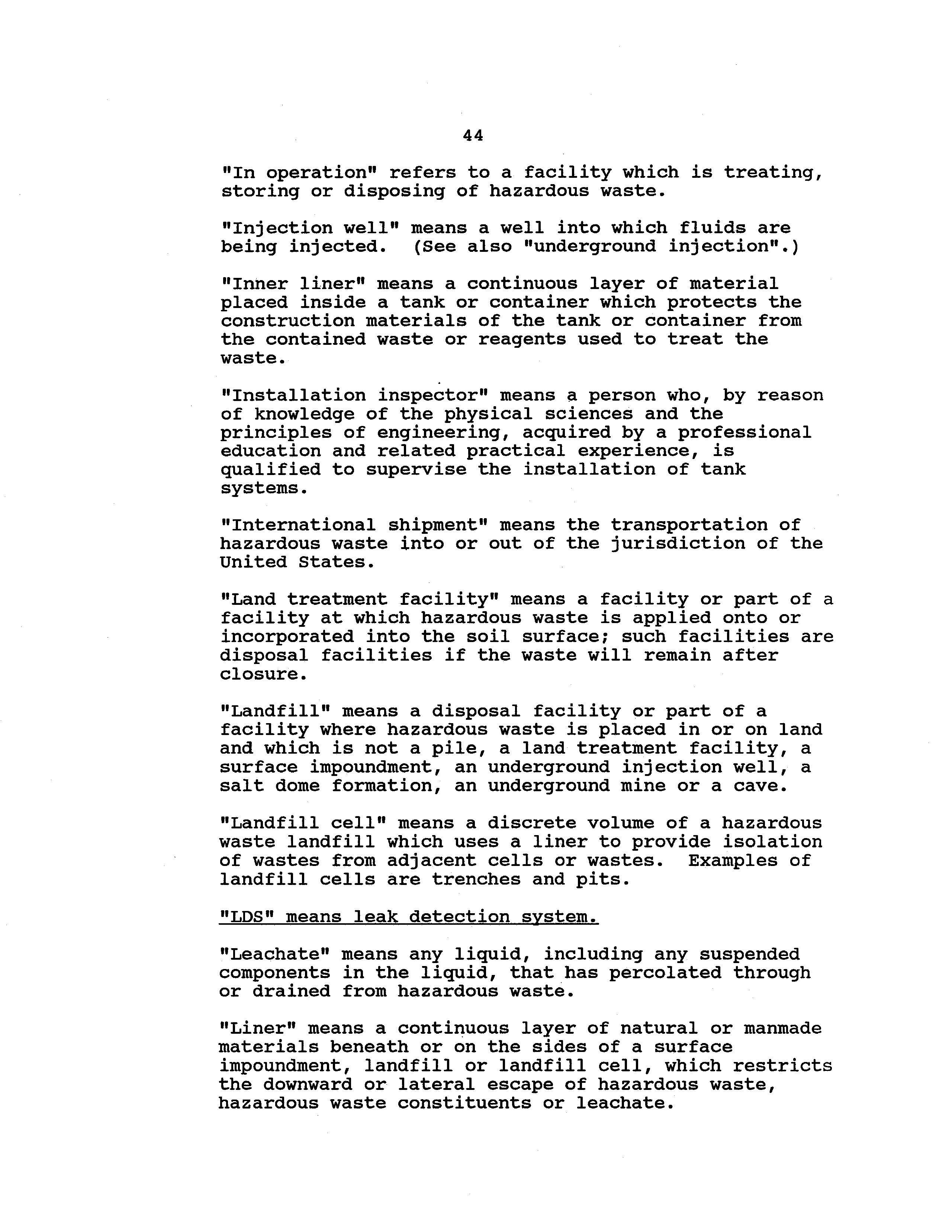| | - L~ /~
- U ~.)O uJ.~
- description set forth in Subpart D of this Part.
- waste listed in Subpart D of this Part is firstadded to the solid waste.
- A) Receives and burns only:
- M) Iron blast furnace slag;
- other applicable shipping requirements; or
- i) Assure that the following informationaccompanies the sample: The sample
- waste.
- F) When each treatability study was conducted;
- In~3pcctionofGround-water
- Linerc~:Protection
- ~j Dikes
- ensure:
- Sections 724.321. 724,35. and 724.401.
- 9312) For an on-site treatment facility, the information
- ~j The liner system must include:
- 96jjj.. A composite bottom liner, consisting of
- Qj.. Designed and operated to minimize clogain~
- effectively.
- A) Liner, location and groundwater monitoring.
- of drinking water (as that term isdefined in 35 Ill. Adm. Code 702.110 and
- iii) The monofill is in compliance withgenerally applicable groundwater
- with the design standards of 35 Ill. Adni. Code
- the requirements of this Section are satisfied.
- Rcguiromcntc (Rcpcaled)Action Leakaae Rate
- 100leakage rate must include an adequate satetv margin to
- Section 724.323 Response Actions
- operator shall:
- ~j Assess the source of liauids and amounts of
- ~j Conduct a fingerorint, hazardous constituent
- or other analyses of the liQuids in the LOS
- to identify the source of liquids and
- possible location of any leaks1 and the
-
- çj Assess the seriousness of any leaks in terms
- of potential for escaping into the
- environment: or
- any of the following:
- the impoundment; and
- surface impoundment construction.
- a) At closure, the owner or operator aunt shall:
- 2) Closure in place.
- and waste residues;
- cover; and
- C) Cover the surface impoundment with a finalcover designed and constructed to:
- i) Provide long-term minimization of themigration of liquids through the closed
- ii) Function with minimum maintenance;
- iii) Promote drainage and minimize erosion orabrasion of the final cover;
- iv) Accommodate settling and subsidence sothat the cover’s integrity is
- maintained; and
- applicable requirements of Subpart F; and
- a) A waste pile (except for an existing portion of a wastepile) must have:
- A) Constructed of materials that haveappropriate chemical properties and
- leachate; and
- i) Chemically rcoiatcnt resistant to thewaste managed in the pile and the
- leachate expected to be generated; and
- waste pile.
- 1) The nature and quantity of the wastes;
- 2) The proposed alternate design and operation;
- ~j The liner sYstem must include:
- jjj A composite bottom liner, consisting ofat least two comoonents. The u~~er
- component during the active life andpost-closure- care period. The lower
- (a)(1)(A). (B) and (C) above.
- ~j Constructed with a bottom slope of onepercent or more
- basins) associated with run-on and run-off control
- systems must be emptied or otherwise managed
- expeditiously after storms to maintain design capacity
- of the system.
- mu3-t shall cover or otherwise manage the pile tocontrol wind dispersal.
- that the requirements of this eeet4efiSection aresatisfied.
- (Rcpc~lcd) Action Leakaae Rate
- (Rcpcalcd) Response Action Plan
- operator shall:
- ~j Assess the source of liauids and amounts of
- liquids by source
- environment: or
- 1) Synthetic liners and covers must be inspected to
- Section 724.401 Design and Operating Requirements
- sufficient strength and thickness to prevent
- failure due to pressure gradients (including
- leachate; and
- A) Constructed of materials that are:
- expected to be generated; and
- ii) Of sufficient strength and thickness toprevent collapse under the pressures
- exerted by overlying wastes, waste covermaterials and by any equipment used at
- 2) The proposed alternate design and operation;
- 0I38-O66~
- transaissivity of 3 X 10 m2/sec or more:
- 0138-0665
- head on the bottom liner.
- effectively.
- waived by the Agency for any monofill, if:
- 2) No migration demonstration.
- A) Design and location requirements.
- liner is leaking.
- 0138 -0667
- Requirements (flopoalod) ~ion Leakage Rate
- tears, punctures or blisters; and
- present.
- 0 138-0669
- Section724.404 Response Actions
- applicable requirements of Subpart F;
- otherwise damaging the final cover; and
- 0138-0672
- 0138-0673
- 129and notify the owner or operator of the
- leakage;- and
- i) Chemically resistant to the wastemanaged in the drip pad and the leakage
- 0138-06Th
- liquid resulting from drippage or precipitation inorder to prevent run—off.
- Purpose, Scope and ApplicabilityImminent Hazard Action
- SUBPART F: GROUNDWATER MONITORING
- Disposal or Decontamination of Equipment, Structures
- and Soils
- Certification of Closure
- Certification of Completion of Post—Closure Care
- 725.251 Promulgation of Forms (Repealed)
- 0138-0579
- 725. 290725. 291725. 292
- 725. 293725. 294725. 295725. 296
- Response Actions
- Other Thermal TreatmentGeneral Operating RequirementsWaste Analysis
- 725.410
- 725.412
- 725. 413
- 725. 414725.415725.416
- Section725.530
- Closure
- Pressure Relief Devices in Gas/Vapor
- Recordkeeping Requirements
- Section 725.113 General Waste Analysis
- a) Waste analysis:
- minimum, the analysis must be repeated:
- facility; and
- Section 725.115 General Inspection Requirements
- 139equipment (such as dikes and sump pumps) that are
- ~j COA program.
- Low-permeability Boil liners
- officer gualifications.
- 141clans for im~1ementingcorrective measures; and
- (Source: Added at 17 Ill. Reg effective
- Section 725.173 operating Record
-
- kept only three years);
- cost estimates under Section 725.244;
- subsection (a) above if:
- 146from passing into the liner at any time
- intaine-d at the facility.
- freauency pursuant to Section 725,326(b).
- Section 725.323 Containment Cyotem Resoonse Actions
- the Agency the results of the determinations
- ~ Assess the seriousness of any leaks in termsof potential for escaping into the
- environment; or
- Section 725.324 Containment System
- ~j The owner or operator muot shall inspect:
- çj Final Agency determinations oursuant to this Section
- Section 725.328 Closure and Post-closure Care
- 725.410, including the following:
-
- C) Cover the surface impoundment with a finalcover designed and constructed to:
- i) Provide long-term minimization of themigration of liquids through the closed
- impoundment;
- ii) Function with minimum maintenance;
- iii) Promote drainage and minimize erosion orabrasion of the cover;
- iv) Accommodate settling and subsidence sothat the cover’s integrity is
- maintained; and
- system or natural subsoils present.
- requirements of Subpart F; and
- to the Board oursuant to Section 40 of theEnvironmental Protection Act.
- Section 725.359 Resoonse Actions
- or operator shall:
- Section 725.360 Monitoring and Iz~s~ection
- of the system.
- waste is controlled.
- receiDt of the notification, the Agency will: Establish
- an action leakaae rate, either as proposed by the owner
- or ooerator or modified using the criteria in this
- unless the Agency aperoves a different period under
- Section 725.404(b).
- Section 725.403 Resconse Actions
- environment r or
- ~c±ion 725.404 Monitoring and Inscection
- ~j. Final Aaencv determinations cursuant to this
- Section 725.410 Closure and Post-closure
- landfill or cell with a final cover designed andconstructed to:
- 2) Function with minimum maintenance;
- 0138~071!
- 3) Have a curb or berm around the perimeter;
- A) Constructed of materials that haveappropriate chemical properties and
- leakage; and
- A) Constructed of materials that are:
- th~~t might be generated;
- iii) Of sufficient strength and thickness toprevent collapse under the pressures
- of hazardous waste or accumulated liquid atthe earliest praaticable time.
- could cause-hazardous waste to be released from thedrip pad.
- prevent overflow onto the drip pad.
- A) Enter a record ofthe discovery in thefacility operating log;
- determination and the underlying rationale inwriting.
- Standards applicable to transporters of hazardous wastefuel (Repealed)
- fuel (Repealed)
- Conditional exemption for spent materials and by-
- products exhibiting a characteristic of hazardous waste(Repealed)
- 726.144 Standards applicable to burners of used oil burned forenergy recovery
- 726.133
- 726.136
-
- 726.Appendix
- 726.Appendix B
- 726.Appendix C
- 726.Appendix726.Appendix726.Appendix726.Appendix
- 726 Appendix H
- 726.Appendix L
- 726.Table A
- Applicability and requirements
- Tier II Emission Rate Screening Limits for FreeChlorine and Hydrogen Chloride
- D Reference Air ConcentrationsE Risk Specific Doses
- F Stack Plume RiseG Health—Based Limits for Exclusion of Waste-DerivedResidues
- Potential PIC5 for Determination of Exclusion ofWaste-Derived Residues
- K Lead-Bearing Materials That May be Processed inExempt Lead Smelters
- Exempt Quantities for Small ~uantity Bu... ~erExemption
- sludge from coking operations.
- A) Provide a one-time written notice to theAgency indicating the following:
- 1) The owner or operator claims exemptionunder this subsection;
-
- provisions of subsection (c)(2), below;
- iii) The hazardous waste contains recoverablelevels of metals; and
- iv) The owner or operator will comply withthe sampling and analysis and
- recordkeeping requirements of thissubsection;
- above; or
- waste listed in Appendix L must contain
- recoverable levels of nickel or chromium
- and baghouse bags used to capture
- metallic dusts emitted by steel
- manufacturing must contain recoverablelevels of metal; and
- ii) The waste does not exhibit the ToxicityCharacteristic of 35 Ill.Ada. Code
- 721.124 for an organic constituent; and
- iii) The waste is not a hazardous wastelisted in 35 Ill. Ada. Code 721.Subpart
- i) The concentration and toxicity oforganic constituents in th-e material;
- ii) The level of destruction of toxicorganic constituents provided by the
- furnace; and
- concentration.
- The owner or operator claims exemption under
- this e~ection;
- B) The hazardous waste is burned for legitimaterecovery of precious metal; and
- 2) Sample and analyze the hazardous waste as
-
- “BIF” means boiler or industrial furnace.
- “Carcinogenic metals” means arsenic, beryllium,cadmium and chromium.
- “CO” means carbon monoxide.
- “Cu m” means cubic meters.
- “E” means “ten to the”. For example, “XE-Y” means
- “Feed rates” are measured as specified in Section726.202(e) (6).
- “NC” means hydrocarbon.
- “&4e~HC1” means hydrogen chloride gas.
- “K” means Kelvin.
-
- “PlC” means product of incomplete combustion.
- “PM” means particulate matter.
- constituent.
- “ppmv” means parts per million by volume.
- “QA/QC” means quality assurance and qualitycontrol.
- specified in Appendix D.
- “TESH” means terrain-adjusted effective stackheight (in meters).
- “Tier I”. See Section 726.206(b).
- “Tier II”. See Section 726.206(c).
- “Tier III”. See Section 726.206(d).
- “ug” means microgram.
- Procedures for case-by—case Extensions to an EffectiveDate
- 728.106 Petitions to Allow Land Disposal of a Waste Prohibitedunder Subpart C
- (Repealed)728.109 SpecialRules for Characteristic Wastes
- 728. 132728.133728.134728.135728. 139
- Section728.101728.102728.103728.104728.105
- 728.150
- 728.Appendix728 .Appendix
- 728.Appendix728 .Appendix728.Appendix728.Appendix
- 728 .Appendix‘28 .Appendix728.Appendix
- SUBPART A: GENERAL
- Section 728.103 Dilution Prohibited as a Substitute forTreatment
- Section 728.135 Waste Specific Prohibitions—-Third Thirdwastes.
- a) The following wastes are prohibited from land disposal.
- FO25P039 (wastewaters);
- KO02KO03K004 (wastewaters)K005 (wastewaters)KO06
- 1(029 (wastewaters)1(031 (wastewaters)1(032
- P033P034P036 (wastewaters)P037
- P038 (wastewaters)P042
- 184P095
- P096P101P102P103P105P108
- 1313813140U41
- DO01D002D003D004 (wastewaters)D005
- DO06DO07D008 (e.~.~ceptfor lead materials s~’redbefore
- secondary smelting)D009 (wastewaters)
- EPA Hazardous Waste Numbers:
- P039 (nonwastewaters)
- DOO9 (nonwastewaters);
- refractory bricks carrying the EPA Hazardous WasteNumbers KO48—KO52)~ and
- d) Effective May 8, 1992, hazardous wastes listed in
- Sections 728.1iO,’7~8.ii1or 728.1i2 that are mixed
- radioactive/hazardous wastes, and soil or debris
-
- 728.106, with respect to those wastes and unitscovered by the petition;
- Section 728.141 Treatment Standards expressed as
- Concentrations in Waste Extract
- D001 NA NA NA FSUBS; Ignitable LiquidsRORGS; or based on 35 Ill.
-
- Ada. Code 721.121(a)(2)
- 721.121(a) (4)
- Ada. Code 721.122(a)(1)
- treat— treat-ment. ment.
- (1)
- D006 NA 7440-43-9 NA RTHERM Cadmium-containingbatteries
- (and are not incin-erator residues))
- D009 Tables 7439-97-6 NA RMERC Mercury: (HighA & B Mercury
- Mercury——inorganics(including
- INCIN
- benzene
- manufacturing andprocessing of
- explosives
- wastewater con-taining explosives
- uenediamine in theproduction of
- toluenediamine viahydrogenation ofdinitrotoluene
- INCIN INCIN
- CARBN; orINCIN
- INCIN
- P016 NA 542-88—1 (WETOX or INCIN Bis(chloromethyl)-CHOXD) fb ether
- CARBN; orINCIN
- P026 NA 5344-82-1 (WETOX or INCIN —(o-Chlorophenyl)—CHOXD) fb thiourea
- CARBN; orINCIW
- CARBN; orINCIN
- INCIN
- CARBN; orINCIN
- INC~N
- P082 Table B 62-75-9 NA INCIN N-Nitrosodimethyl-amine
- INCIN
- Mercury Sub-category——greaterthan or equal to 260mg/kg total
- Mercury Content)
- INCIN INCIN
- INCIN
- INCIN
- P120 Table B 1314-62-1 NA STABL Vanadium pentoxide
- INCIN INCIN
- Table B 75-05-8 NA INCIN Acetonitrile
- INCIN
- U038 Table B 510-15—6 NA INCIN Chlorobenzilate
- U042 Table B 110-75-8 NA INCIN 2-Chloroethyl vinylether
- INCIN
- U057 Table B 108-94-1 NA FSUBS; or CyclohexanoneINCIN
- INCIN
- phosphate
- INCIN
- INCIN
- INCIN
- INCIN
- INCIN
- INCIN INCIN
- INCIN
- CHRED; or CHRED; or
- INCIN INCIN
- INCIN INCIN
|
ILLINOIS POLLUTION CONTROL
BOARD
January 21,
1993
IN THE MATTER OF:
)
)
RCRA
UPDATE,
USEPA REGULATIONS
)
R92-10
(1/1/92
—
6/30/92)
)
(Identical in Substance
)
Rules)
Adopted Rule.
Final Order,
ORDER
OF THE BOARD
(by J. Anderson):
Pursuant to Section 7.2 and 22.4(a) of the Environmental
Protection Act (Act), the Board is amending the
RCRA
hazardous
waste regulations.
The
amendments
involve
35 Iii. Adm. Code 702,
703,
720, 721,
724,
725,
726 and 728.
The Board will not file
the
adopted
rules until 30 days after the date of this order, to
allow time for post—adoption comments, particularly from the
agencies involved in the authorization process.
Section 22.4 of the Act governs adoption of regulations
establishing the RCRA program in Illinois.
Section 22.4(a)
provides for quick adoption
of regulatio~swhich are “identical
in substance’t to federal regulations; Sectioh 22.4(a) provides
that Title VII of the Act and Section 5 of the Administrative
Procedure Act shall not apply.
Because
this
rulemaking is not
subject to Section 5 of the Administrative Procedure Act,
it is
not subject to first notice.or to second notice review by the
Joint Committee on Administrative Rules
(JCAR).
The federal
RCRA
regulations are found at 40 CFR 260 through 270.
This
rulemaking
updates Illinois’ RCRA rules to correspond with federal
amendments. during the period January 1 through
June
30,
1992.
The. completetext of the rules
is
attached to this order.
This
order is supported by an opinion adopted this same day.
IT
IS
SO
ORDERED.
I, Dorothy N.
Gunn, Clerk of the Illinois Pollution
Control
Board, hereby ce~ifythat the above order was adopted on the
~
day of
‘
~a.
,
1993, by a vote of
~~‘—e
7.
Dorothy N.
nn, Clerk
Illinois Pollution Control. Board
0 t38-05i~9
2
TITLE
35:
ENVIRONMENTAL PROTECTION
SUBTITLE G:
WASTE DISPOSAL
CHAPTER
I:
POLLUTION
CONTROL
BOARD
SUBCHAPTER
b:
PERMITS
PART
702
RCRA AND
UIC
PERMIT PROGRAMS
Section
702.101
702.102
702.103
702.104
702.105
702.106
702107
702.108
702.109
702.110
SUBPART A:
Applicability
Purpose
and Scope
Confidentiality
References
Rulemaking
Agency Criteria
Permit
Appeals
Variances
Enforcement
Definitions
GENERAL
PROVISIONS
SUBPART
B:
PERMIT
APPLICATIONS
Section
702.120
702.121
702.122
702.123
702.124
702~l25
702 126
Section
702.140
702.141
702.142
702.143
702.144
702.145
702.146
702.147
702.148
702.149
702.
150
702.151
702.152
702.160
702.161
702.162
Permit Application
Who
Applies
Completeness
Information Requirements
Recordkeeping
Continuation of Expiring Permits
Signatories to Permit Applications and Reports
SUBPART C:
PERMIT
CONDITIONS
Conditions Applicable to all Permits
Duty
to Comply
Duty
to Reapply
Need to Bait or Reduce Activity Not a Defense
Duty
to Mitigate
Proper Operation and Maintenance
Permit Actions
Property Rights
Duty
to
Provide
Information
Insj,
~ction
and
Entry
Monitoring
and
Records
Signatory
Requirements
Reporting
Requirements
Establishing Permit Conditions
Duration of Permits
Schedules
of
Compliance
0138-0550
3
702.163
Alternative
Schedules
of
Compliance
702.164
Recording and Reporting
SUBPART
0:
ISSUED PERMITS
Section
702.181
Effect of a Permit
702.182
Transfer
702.183
Modification
702.184
Causes for Modification
702.185
Facility
Siting
702.
186
Revocation
702.187
Minor
Modifications.
AUTHORITY:
Implementing Section 13 and
22.4
and
authorized
by
Section 27 of the Environmental Protection Act
(111. Rev. Stat.
1~8C Cupp.
1991,
ch.
111
1/2, pars.
1013, 1022.4 and 1027).
SOURCE:
Adopted in R81—32, 47 PCB 93, at 6 Iii. Reg. 12479,
effective as noted in 35
Ii..
Adnt. Code 700.106; amended in
R82—19, at 53 PCB 131,
7 Ill. Reg.
14352,
effective
as noted in
35 Iii.
Adin.
Code 700.106; amended in R84—9 at 9 Iii. Reg. 11926,
effective July 24,
1985; amended in R85—23 at 10 Ill. Reg. 13274,
effective July 29, 1986; amended in R86—1 at 10 Iii. 14083,
effective August 12,
1986; amended in R86-28 at 11 Iii. Rag.
.6131, effective March 24,
1987; amended in R87—5 at 11 Iii. Reg.
19376, effective November
12.,
1987; amended in R87—26 at 12 Ill.
Reg.
2579,
effective January 15,
1988; amended in. RB7—29 at 12
Ill. Reg.
6673, effective March 28,
1988; amended in R87-39 at 12
13083, effective July 29,
1988; amended in R89—1 at 13 Iii. Reg.
18452, effective November 13,
1989; amended in R89—2 at 14 Iii.
Reg. 3089, effective February 20,
1990; amended in R89—9 at 14
Ii..
Reg.
6273, effective April
16,
1990;
amended in R92—10 at
17
Iii.
Reg.
.
,
effective
_________________
SUBPART
0:
.
ISSUED
PERMITS
Section
702.181
Effect of a Permit
a)
The existence of a R~~RA
or UIC permit he~gQg~. not
constitute
a
defense
to
a
violation
of
the
Environmental Protection Act or this Subtitle, except
for development, modification or operation without a
permit. However,
a permit may be modified, reissued or
revoked during its term for cause as set forth in 35
Ill. Adm. C&le 703.270 through 703.273
(RCRA) and 35
Ill. Adm. Code 704.261 through 704.263
(UIC)
and
Section 702.186.
b)
The issuance of a permit does not convey any property
rights of any sort, or any exclusive privilege.
4
C)
The issuance of a permit does not authorize any injury
to persons or property or invasion of. other private
rights, or any infringement of State or local law or
regulations, except as noted in subsection
(a).
BOARD
NOTE:
Derived from 40 CFR 144.35 -(l~8U)
(1991~and 40 CPR 270.4 (1~8O),me amended at
53
Fed. Req. 37~)34,C.ptuber 38, 1~80(1991).
as
amended at 57 Fed. Rep.
3486. January 29
1992.
(Source:
Amended at 17 Ill. Reg.
_____,
effective
0138-0552
5
TITLE
35:
ENVIRONMENTAL PROTECTION
SUBTITLE
G:
WASTE DISPOSAL
CHAPTER
I:
POLLUTION CONTROL BOARD
SUBCHAPTER b:
PERMITS
PART 703
RCRA PERMIT PROGRAM
SUBPART
A:
GENERAL PROVISIONS
Scope and Relation to Other Parts
Purpose
References
SUBPART
B:
PROHIBITIONS
Prohibitions
in Genera?
RCRA Permits
Specific Inclusions
in Permit Program
Specific Exclusions
from Permit Program
Discharges of Hazardous Waste
Reapplications
Initial Applications
Federal
Permits
(Repealed)
SUBPART
C:
AUTHORIZATION BY RULE AND INTERIM STATUS
Purpose and Scope
Permits by Rule
Application by Existing HWM Facilities and Interir
Status Qualifications
Application by Ne~HWN Facilities
Amended Part A Application
Qualifying for Interim Status
Prohibitions During Interim Status
Changes During Interim Status
InterirE Status Standards
Grounds
for Termination of Interim Status
Permits for Less Than an Entire Facility
Closure by Removal
Procedures for Closure Determination
SUBPART
D:
APPLICATIONS
Section
703.100
703. 101
703.110
Section
703. 120
703.12?
703. 122
703. 123
703. 124
703.125
703.126
703.127
Section
703
.
140
703.141
703. 150
703.15?
703.152
703.153
703. 154
703.155
703.156
703.157
703.158
703. 159
703. 160
Section
703 .160
703. 181
703
.
182
703,183
,L~1
703.8.
-.
-
Applications
in General
Contents of Part A
Contents
of Part B
General
Informaticr~
Facility Location Information
Groundwater Prote.~t~cnInformation
Exposure Informaticr~
Solid Waste Manaoerc~ntUnitE
U
/
~.‘
¼..
(~
6
703.188
703.200
703.201
703.202
703.203
703.204
703.205
703.206
703.207
70. .208
703.209
703.210
703.211
703.212
Section
703.240
703.241
703.242
703.243
703.244
703.245
703.246
703.247
Section
703.260
703.270
703.271
703.272
703.273
703.280
703.281
703.282
703.283
Appendix A
Other Information
Specific Information
Containers
Tank Systems
Surface Impoundments
Waste Piles
Incinerators
Land Treatment
Landfills
Specific Part B Information Requirer~entsfor Boilers
and Industrial Furnaces
Miscellaneous Units
Process Vents
Equipment
Drip Pads
SUBPART
E:
SHORT TERM
AND
PHASED PERMITS
Emergency Permits
Incinerator Conditions Prior to Trial Burn
Incinerator Conditions During Trial Burn
Incinerator Conditions After Trial Burn
Trial Burns for Existing Incinerators
Land Treatment Demonstration
Research, Development and Demonstration Permits
Permits for Boilers and Industrial
Furnaces Burning
Hazardous Waste
SUBPART F:
PERNIT CONDITIONS OR DENIAL
Permit Denial
Establishing Permit Conditions
Noncompliance Pursuant to Emergency Permit
Monitoring
Notice of Planned Changes
Twenty-four Hour Reporting
Reporting Requirements
Anticipated Noncompliance
SUBPART
G:
CHANGES
TO
PERMITS
Transfer
Modification
Causes for Modification
Causes for Modification or Reissuarice
Facility Siting
Permit Modification at the Request
of the Permittec
Class
1 Modifications
Class
2 Modifications
Class
3 Modifications
Classification
of Permit ModificationE
013
E -055 ~
Section
703.221
703.222
703.223
703.224
703.225
703.230
703.231
703.232
7
AUTHORITY:
Implementing
Section
22.4
and
authorized
by
Section
27
of
the
Environmental
Protection
Act
(Ill.
Rev.
Stat.
1991,
oh.
111½, pars.
1022.4
and
1027).
SOURCE:
Adopted
in
R82-19,
53
PCB
131,
at
7
Ill.
Reg.
14289,
effective
October
12,
1983;
amended
in
R83—24
at
8
Ill.
Reg.
206,
effective December
27,
1983;
amended
in
R84—9
at
9
Ill.
Reg.
11899, effective July 24,
1985;
amended in R85—22
at
10
Ill. Reg.
1110,
effective
January
2,
1987;
amended
in
R85-23
at 10
111.
Reg.
13284,
effective
July
28,
1986; amended in R86—1 at
10 Ill.
Reg.
14093,
effective
August
12,
1986;
amended
in
R86—19
at
10
Ill.
Reg.
20702,
effective
December
2,
1986;
amended
in
R86—28
at
11
Ill.
Reg.
6121,
effective
March
24,
1987;
amended
in
R86—46
at
11
Ill.
Reg.
13543,
effective
August
4,
1987;
amended
in
R87-5
at
11
Ill.
Reg.
19383,
effective
November
12,
1987;
amended
in
R87-
26
at
12
Ill.
Reg.
2584,
effective
January
15,
1988;
amended
in
R87—39
at
12
Ill.
Reg.
13069,
effective
July
29,
1988;
amended
in
R88-16
at
13
Ill.
Reg.
447,
effective
December
27,
1988;
amended
in
R89—l
at
13
Ill.
Reg.
18477,
effective
November
13,
1989;
amended
in
R89-9
at
14
Ill.
Reg.
6278,
effective
April
16,~1990;
amended
in
R90-2
at
14
Ill.
Reg.
14492,
effective
August
22,
1990;
amended
in R90—ll at 15
Ill.
Reg.
9616,
effective June
17,
1991;
amended
in R91—1 at
15 Ill. Reg.
145544 effective September
30,
1991;
amended
in R9l—l3
at
16 Ill Reg.
9767,
effective June
9,
1992;
amended
in
R92—l0
at
17
Ill.
P.eg.
_____
,
effective
SUBPART
D:
APPLICATIONS
Section 703.203
Surface Impoundments
For facilities that store,
treat or dispose of hazardous waste
in
surface impoundments,
except as otherwise provided
in 35
Ill.
Adin.
Code 724.101, the Part
B application must include:
a)
A
list
of
the
hazardous
wastes
placed
or
to
be
placed
in each surface impoundment;
b)
Detailed plans and an engineering report describing how
the surface impoundment is designed and
is or will be
dc~igned,
constructed,
operated
and maintained to meet
the
requirements
of
35
Ill.
Adin.
Code
724.119,
724.321~
724.322
and
724.323,
-.
Thio
Dubm
oion
muot
addrc~
the
iLemo
as
apccitico
in
LflUL
~coL1on
addressina
the
following
items:
1)
The liner
system
(except
for
an
existing
portion
of
a
surface
impoundment)
.
If
an
exemption
from
the requirement
for a liner
is sought as providei
by
35
Ill..
Ado.
Codc
724.321(b),
submit ~-e~-a-i-~-e-~
plano
and
engineering
and
hydrogeologic
rcporto
o:
appropriate,
dcccribing
altcrnate
dcoign
en~
O!3~-Q555
8
operating practio~c~that
will,
in
conjunction
wi~th
location aopects, prevent the migration of any
ha~ardou~oonctituentG into the ciround-water or
~urfacc water at any future
time
a
copy
of
the
board
order
granting
an
ad-justed
standard
pursu~fl~
to
35
Iii.
Adin.
Code
724.321(b)
~
The
double
liner
and
leak
(leachate)
detection,
collection
and
removal
system,
jf
the
surface
impoundment must nieet the reguirements of
35 Iii.
AdIn.
Code
724.321(c).
If an exemption from the
re~uirenaentsfor double liners and
a
leak
detection,
collection and removal system or
alternative desigr
is sought as provided by 35
Ill. Mm.
Code 724.321(d),
(e)
or
(f),
submit
appropriate information
~j
If the leak detection system
js located
in
a
saturated zone,
submit detailed plans and an
engineerjng report explaining the leak detection
system design and operation,
and the location
of
the saturated zone
in relation to the leak
detection system
~j
The construction
guality assurance
(CQA)
plan
if
reguired under
35
Ill.
Adm.
Code 724.119
~
Proposed action leakage rate, with rationale,
if
required under
35
Ill.
Adin.
Code 724.322,
response
action
plan,
if
required
under
35
Ill.
Adm.
Code
724.323,
and
a
proposed
pump
operating
level,
if
required under
35
111.
Adrn.
Code 724.326(d) (3)
6)
Prevention of overtopping; and
7)
Structural integrity of dikes;
c)
A description of how each surface impoundment,
including the double liner system, leak detection
system,
cover system
and
cover oyotcms and
appurtenances for control of overtopping, will be
inspected
in
order
to
meet
the
requirements
of
35
Ill.
Adm.
Code
724.326(a)~
~
(b)
and
(d).
This
information
ohould must be included
i.
the
inspection
plan
submitted under Section 703.183(e);
d)
A certification by
a qualified engineer which attests
to the structural
integrity
of each dike,
as required
under
35 Ill.
Adm.
Code
724,326(c).
For ne~units, th~
owner or operator must
shall submit
a statement by
a
qualified engineer that the engineer will provide
s~o~
a certification upon completion of construction
in
0138-0556
9
accordance with the plans and specifications;
e)
A description of the procedure to be
used for removing
a surface impoundment from service,
as required under
35
Ill.
Adm.
Code
724.327(b)
and
(c).
This
information
~h-ou1d must
be included in the contingency plan
submitted under Section 703.183(g);
f)
A description of how hazardous waste residues and
contaminated materials will be removed from the unit at
closure,
as required under 35 Ill. Adm. Code
724.328(a) (1).
For any wastes not to be removed from
the unit upon closure, the owner or operator ~u~t shall
submit detailed plans and an engineering report
describing how
35
Ill. Adm.
Code 724.328(a) (2) and
(b)
will
be complied with.
This information ohould must be
included
in the closure plan and,
where applicable,
the
post-closure plan submitted under Section 703.183(m);
g)
If ignitable or reactive wastes are to be placed in
a
surface impoundment,
an explanation of how 35
Ill. Adm.
Code 724.329 will be complied with;
h)
If incompatible wastes, or incompatible wastes and
materials, will be placed in a surface impoundment,
an
explanation of how 35 Ill. Adm. Code 724.330 will be
complied
with--
;
and,
i)
A waste management plan for hazardous waste numbers
F020,
F02l,
F022,
F023,
F026
and F027 describing how
the surface impoundment
is or will be designed,
constructed, operated and maintained to meet the
requirements of
35
Ill.
Adm.
Code 724.331.
This
submission must address the following items
as
specified
in
that
Section:
1)
The volume, physical
and
chemical
characteristics
of the wastes,
including their potential to
migrate through soil or to volatilize or escape
into the atmosphere;
2)
The attenuative properties of underlying and
surrounding
soils
or
other
materials;
3)
The mobilizing properties of other materials
co-disposed with these wastes;
and
4)
The effectiveness cf additional treatment, desiq~
or monitoring techniques.
BOARD NOTE:
Ccc 40 CFR 2~0.17
Derive~frcr
40
CFP
270.17
(1991),
as
amendeT
at
57 Fe~.
p
L/Jc~C5S7
10
Req.
3486,
January
29,
1992.
(Source:
Amended at
17
113. Reg.
_____
,
effective
Section 703.204
Waste Piles
For facilities that store or treat hazardous waste
in waste
piles, except as otherwise provided in
35 Ill. Adm.
Code 724.101,
the Part
B application must include:
a)
A list of hazardous wastes placed or to be placed
in
each waste pile;
b)
If an exemption
is sought to 35
Ill. Adm Code 724.351
and 724.Subpart F as provided by 35 Ill.
Adm.
Code
724.350(c)
or
724.190(b)
(2),
an
explanation
of
how
the
requirements of
35
Ill. Adm. Code 724.350(c)
will be
complied with or detailed plans and an engineering
report describing how the requirements of 35
Ill. Adm.
Code
724.190(b)
(2)
will
be
met;
c)
Detailed plans and an engineering report describing ho~
the pile is designed and
is or will be
d-e-signcd,
constructed,
operated
and
maintained
to
meet
the
requirements of
35 Ill.
Adm. Code 724.119, 724.35l~
724.352 and 724.353,
addressing the following items:
This
submission
must
address
the
following
items
ac
~peaifled
in -that Cectioni
1)
Liner,
leak detection and removal system.
~J
The liner system
(except for an existing
portion of a waste pile),
if the waste pile
must meet the requirements
of
35
Ill. Ado.
Code 724.35l(aj.
If an exemption from the
requirement for a liner is sought,
as
provided by 35
Ill.
Adrn.
Code 724.351(b), the
owner or operator gust submit detailed plans
and engineering and hydrogeologic reports as
appropriate, describing alternate design~
and
operating practices that will,
in conjunct4e~
with jo-cation aspects, prevent the migration
e-i
any ~a~-ardouoconstituents into the
ground—water or surface water at any fut~i~-?
time shall submit
a copy of the Board order
granting an adlusted standard pursuant to 3~
Ill.
Adin.
Code 724.351(h)
~
The double liner and
leal: (leachat~
detection,
collection
and removal
system,
if
the waste pile rust meet the requirements
of
0! 3a-0558
11
35
Ill.
Adm.
Code 724.351(c).
If an
exemption from the requirements for
double
liners and
a leak detection,
collection
and
removal system or alternative design
is
ught as provided bY
35
Iii. Adm. Code
724.35l(d)~
(e)
or
(f),
submit appropriate
information
~
If the leak detection sYstem is located in
a
saturated
zone,
submit detailed plans and an
engineering report explaining the
leak
detection system design and operation,
and
the location of the saturated zone
in
relation to the leak detection system
Q~
The COA plan
if required under
35
Ill.
Adr.
Code 724.119
~j
Proposed action leakage rate, with rational?,
if required under
35 Ill.
Admn.
Code 724.352,
and response action plan,
if required under
3~Ill.
Adin.
Code 724.353
2)
Control
of run-on;
3)
Control
of run-off;
4)
Management of collection and holding units
associated with run-on and run-off control
systems;
and
5)
Control
of wind dispersal
of particulate matter,
where applicable;
d)
A description of how each waste pile,
including the
double liner system,
leachate collection and removal
system,
leak detection system,
cover system and
appurtenances for control of run-on and run—off,
will
be inspected in order to meet the requirements of
35
Ill.
Adir.
Code 724.354(a)~e~ (b)
and
(c).
This
information should must be included
in the
inspection
plan submitted under Section 703.183(g
~).
e)
If the treatment
is carried out on or in the pile,
details
of the process and equipment used,
and the
nature and quality of the residuals;
f)
If ignitable or reactive wastes are to be placed
in
a
waste
pile,
an explanation
of how the requirements
of
35
101.
A5.m.
Code 724.35E will he complied with~
If
incompatible wastes,
or incompatible wastes
ani
c
i~
~
-
U
559
12
materials,
will be placed
in
a waste pile,
an
explanation of how
35 Ill.
Adit.
Code 724.357 will be
complied
with;
h)
A description of how hazardous waste residues and
contaminated materials will be removed from the waste
pile at closure,
as required under
35 Ill.
Adxn.
Code
724.358(a).
For any waste not to be removed from the
waste pile upon closure, the owner or operator gust
shall
submit detailed plans and an engineering report
describing how 35
Ill.
Adm. Code 724.410(a) and
(b)
will be complied with.
This information ohould must be
included
in the closure plan and, where applicable,
the
post-closure plan submitted under Section 703.183(m)--i
and,
i)
A waste management plan for hazardous waste numbers
F020,
F02l,
F022,
F023, F026 and F027 describing how
the surface impoundment
is or will be designed,
constructed, operated and maintained to meet the
requirements of
35
Ill.
Admn.
Code
724.359.
This
submission must address the following items as
specified
in
that
Section:
1)
The volume, physical and chemical characteristics
of the wastes,
including their potential to
migrate through soil or to volatilize or escape
into the
atmosphere;
2)
The attenuative properties of underlying and
surrounding soils or other materials;
3)
The mobilizing properties of other materials
co—disposed with these wastes; and
4)
The effectiveness of additional treatment,
design
or
monitoring
techniques.
BOARD
NOTE:
Ccc
40
-CFR 270.1BDerived from 40
CFR 270.18
(1991),
as amended at
57
Fed.
Rca.
3486,
January 29,
1992.
(Source:
Amended at
17
Ill.
Req.
_____
,
effective
Section 703.207
Landfills
For facilities
that dispose of hazardous waste
in landfil3s,
except as otherwise provided
in
35
131.
Adm.
Code 724.101,
thc
Part B application must include:
a)
A
list
of
the
hazardous
wastes
placed
or
to
he paoE::
013&-0560
13
The liner system and lcachatc collection and
removal
system
(except for an existing
portion of a
landfill)
,
if
the
landfill must
meet the requirements
of
35 Ill.
Adm.
Code
724.401(a).
If an exemption from the
requireinent~for a liner, and
a leachate
collection and removal system is sought
as
provided by 35
Ill.
Adm. Code 724.401(b),
submit detailed plans engineering and
hydrogcologic reports as appropriate,
describing alternate design and operating
practices that will,
in conjunction with
location aspects, prevent the migration
0
any
hazardous constituent
into the
dwotcr ~r ~
~a4cr -a4 sny
~
time ~ copy of the
Board order granting an
adjusted standard pursuant to 35
Ill.
Ado.
Code
724.401(b)
~
The double liner and
leak
(leachate)
detection, collection and removal system,
if
the landfill must meet the requirements
of
35
Ill.
Adin.
Code 724.403(c).
If an exemption
from the requirements for double liners and
a
leak detection,
collection and removal
system.
or alternative design
is sought as provided
by 35
Iii. Adm.
Code 724.401(d),
(e)
or
(f),
submit appropriate information
~
If
the
leak
detection system is located
in
a
saturated zone,
submit detailed ~1ans and an
engineering report explaining the leak
detection
system design and operation,
and
the location of the saturated
zone
in
relation
to
the
leak
detection
system
~
The
CQA
plan
if
resumed
under
35
13
.
Ado.
CodE
724.119
C 13 8
-0561
~LUU1J
in each landfill or landfill cell;
b)
Detailed plans and an engineering report describing how
the landfill is designed and
is or will be designed,
constructed, operated and maintained to comply with
meet
the requirements of 35
Ill. Adm. Code 724.119,
724.401.,
724.402 and 724.403, addressing the following
items:.
This submission must address the following
items
as specified in that Scotioni
1)
Liner,
leak detection, collection and removal
systems.
14
~
Proposed action leakage rate,
with rationale,
if required under 35
Ill.
Adrn.
Code 724.402,
and response action plan,
f required under
35 Ill.
Adin.
Code
724.404,
and proposed pur~p
Qperating level,
if required under
35 111.
Admn.
Code 724.403
2)
Control
of run-on;
3)
Control
of
run-off;
4)
Management of collection and holding facilities
associated with run-on and run-off control
systems;
and
5)
Control of wind dispersal
of particulate matter,
where applicable;
c)
If an exemption from 35 I1L—Adin.
Code 724.Cubpart
F
i-s
sought,
as provided by 35
Ill. Adm. Code 724.402(a),
the—owncr or operator must submit detailed plans and an
engineering
report explaining the location of
the
saturated
zone in relation to the landfill,
the design
of ~adouble-liner system that incorporates a leak
detection system between the liners and a
leachate
collection and removal system above the lincrsi ~
description of how each
landfill,
including the double
liner system,
leachate collection and removal system,
leak detection system,
cover system, and appurtenances
for
control
of
run—on
and
run—off,
will
be
inspected
in
order
to
meet
the
requirements
of
35
Ill.
Adn.
Code
724.403(a),
(b)
,
and
(c)
.
This information must be
included in the inspection plan submitted under Section
703.183(e);
ci)
A description of how each landfill,
including the
liner and cover systems,
will be inspected
in order to
meet the requirements
of the 35
Ill.
Adm.
Code
724.403(a)
and
(b).
This information should rust be
included in the inspection plan submitted under Section
703.183(e);
e)
Detailed plans and an engineering report describing thE
final
cover which will be apr’ ied to each landfill
or
landfill
cell at closure
n a~cordancewith
35 Ill.
Ado.
Code 724.410(a)
,
and
a description of how each
landfill
will
be
maintained
and
monitored
after
closurE
in accordance with
35
Ill. Ado.
Code 724.410(b).
This
information &eu---d must be included
in the closure
an~2
post-closure
plans
submitted
under
Section
703,183(r);
f)
f igoitahc-- or
reactive wastes will
he landfil1e~, a:.
0138-0562
15
explanation of how the requirements of
35
Ill.
Ado.
Code
724.412 will be complied with;
If incompatible wastes, or incompatible wastes and
materials,
will be landfilled,
an explanation of how
35
Ill.
Ado. Code
724.413 will be complied with;
h)
If bulk or non—containerized liquid waste or waste
containing
free liquids is to be l-andfilled,
an
explanation of how the requirements
of
35 Ill.
Ado.
Code 724.414 will be complied with;
i)
If
containers of hazardous waste are to be landfilled,
an explanation of how the requirements of 35
Ill.
Ado.
Code 724.415 or
724.416,
as applicable,
will be
complied
W~th-r
;
and,
j)
A waste
management plan for hazardous waste numbers
F020,
F021,
F022,
F023, F026 and F027 describing how a
landfill
is or will be designed, constructed,
operated
and maintained to meet the requirements of
35 Ill.
Ado.
Code 724.417.
This submission must address the
following items
as
specified in that Section:
1)
The volume,
physical and chemical characteristics
of the wastes,
including their potential to
migrate
through
soil
or
to
volatilize
or
escape
into the atmosphere;
2)
The attenuative properties of underlying and
surrounding soils or other materials;
3)
The mobilizing properties
of
other
materials
co-disposed with these wastes;
and
4)
The effectiveness of additional treatment,
design
or monitoring techniques.
BOARD NOTE:
Ccc 40
CFR 270.-QlDerived from
40
CFR 270.21
(1991)
,
as amended at
57
Fed.
Rec.
3486, January
29.
1992.
(Source:
Amended at
17
Ill.
Req.
_____
,
effective
Section 703.Appendix A
Classification
cf
Permit
Modifications
Class
Modifications
A.
General
Permit
Provisions
1.
Adoinistrativc
an:~
ir~formaticnz~.1co:~n’~
:~
‘~
(
r~
r
~
16
1
2.
Correction of typographical errors.
1
3.
Equipment replacement or upgrading with
functionally equivalent components
(e.g.,
pipes,
valves,
pumps,
conveyers,
controls)
4.
Changes
in the frequency of or procedures
for
monitoring,
reporting,
sampling or maintenance
activities by the permittee:
1
a.
To provide
for more frequent monitoring,
reporting or maintenance.
2,
b.
Other changes.
5.
Schedule of compliance:
1*
a.
Changes
in
interim
compliance dates, with
prior approval
of the Agency.
BOARD NOTE:
“~“
indicates that prior Agency
approval
is required.
3
b.
Extension of final compliance date.
1*
6.
Changes in expiration date of permit to allow
earlier permit termination, with prior approval
of
the Agency.
1*
7.
Changes
in ownership or operational control
of
a
facility,
provided the procedures
of Section
703.260(b)
are
followed.
F
General Facility
Standards
1.
Changes to waste sampling or analysis methods:
1
a.
To conform with Agency guidance or Board
regulations.
1
h.
To incorporate changes associated with F039
(multi—source leachate)
sampling or analysis
methods.
2
c.
Oth~r cL~dnges.
2.
Changes
to analytical
quality assurance/control
plan:
1
a.
To
conform
with
agency
guidance
or
regulations.
UI
36-056k
17
2
b.
Other changes.
3.
Changes in procedures for maintaining the
operating record.
2
4.
Changes
in frequency
or
content
of
inspection
schedules.
5.
Changes
in
the training plan:
-
2
a.
That affect the type or decrease the amount
of training given to employees.
b.
Other changes.
6.
Contingency plan:
2
a.
Changes
in emergency procedures
(i.e.,
spill
or release response procedures).
b.
Replacement with functionally equivalent
equipment, upgrade or relocate emergency
equipment
listed.
2
c.
Removal
of
equipment
from emergency equipment
list.
ci.
Changes
in name,
address or phone number of
coordinators or other persons or agencies
identified
in the plan.
Note:
When
a permit modification
(such as
introduction of a new unit)
requires
a change
in
facility
plans
or
other
general
facility
standards,
that
change
must
be
reviewed
under
the
same
procedures
as
the
permit
modification.
7.
COA plan:
~
Changes that the COA officer certifies
in the
operating
record
will provide equivalent
or
better certainty that the unit components
meet the design specifications.
b.
Other
changes.
C’.
Groundwater Protection
1.
Changes
to wells:
a.
Changes
in the
number,
location,
depth
or
1~ ‘~P_1)~
LI
~
LJU
18
design
of upgradient or downgradient wells of
permitted groundwater monitoring
system.
b.
Replacement
of
an
existing
well
that
has
been
damaged or rendered inoperable, without
change to location, design or depth of the
well.
2.
Changes
in groundwater sampling or analysis
procedures
01
monitoring schedule, with prior
approval of the Agency.
3.
Changes
in statistical procedure for determining
whether
a statistically significant change in
groundwater q~ialitybetween upgradient and
downgradient wells has occurred, with prior
approval of the Agency.
4.
Changes
in point
of compliance.
5.
Changes
in indicator parameters,
hazardous
constituents
or
concentration
limits
(including
ACL5 (Alternate Concentration Limits)):
a.
As specified in the groundwater
protection
standard.
b.
As
specified
in the detection monitoring
program.
6.
Changes to
a detection monitoring program
as
required
by
35
Ill.
Ado. Code 724.198(j),
unless
otherwise specified
in this Appendix.
7.
Compliance monitoring program:
a.
Addition of compliance monitoring program
as
required
by
35
Ill.
Ado. Code 724.198(h)
(4)
and 724.199.
b.
Changes
to
a compliance monitoring program as
required
by
35 Ill. Ado.
Code 724.199(k),
unless otherwise specified in this Appendix.
8.
Corrective icti~nprogram:
a.
Addition
of
a
corrective
action
program
as
required-
by
35
Ill.
Ado.
Code
724.199(i)
(2)
and
724.2CC-.
-h.
Changes
to
a
corrective
action
program
as
required
~y
3E
Ill.
Ado.
Code
724.200(h),
0
i 3
E;
-
056 6
19
unless otherwise specified
in this Appendix.
D.
Closure
1.
Changes to the closure plan:
1*
a.
Changes
in estimate of maximum extent of
operations
or maximum inventory of waste on—
site at any time during the active life of
the facility, with prior approval of the
Agency.
1*
b.
Changes
in the closure schedule for any unit,
changes
in the final closure schedule for thE
facility or extension of the closure period,
with prior approval of the Agency.
1*
c.
Changes
in the expected year of final
closure, where other permit conditions are
not changed, with prior
approval
of the
Agency.
1*
ci.
Changes in procedures
for decontamination of
facility equipment or structures, with prior
approval
of the Agency.
2
e.
Changes
in approved closure plan resulting
from unexpected events occurring during
partial
or final closure, unless otherwise
specified in this Appendix.
2
f.
Extension of the closure period to allow
a
landfill,
surface impoundment or land
-
treatment
unit
to
receive
non—hazardous
wastes after final receipt of hazardous
wastes
under
35
Ill. Ado.
Code 724.213(d)
or
(e).
2.
Creation of
a new landfill unit as part of
closure.
3.
Addition
of
the
following
new
units
to
be
use:’
temporarily for closure activities:
3
a.
Surface
impoundments.
3
b.
Incinerators.
c.
Waste piles that
do not comply with
3-S Il.
Ado.
Code 724.3~0(0).
2
d.
Waste piles that comply with
31
Ill.
Ado.
0
1
3 ~-0567
20
Code
724.350(c).
2
e.
Tanks or containers
(other than specified
below).
1*
f.
Tanks used for neutralization,
dewatering,
phase separation or component separation,
with prior approval of the Agency.
F.
Post-Closure
1.
Changes
in name, address or phone number of
contact in post-closure plan.
2
2.
Extension of post-closure care period.
3
3.
Reduction
in the post—closure care period.
4.
Changes to the expected year of
final closure,
where other permit conditions are not changed.
2
5.
Changes in post-closure plan necessitated by
events occurring during the active life of the
facility,
including partial and final closure.
F.
Containers
1.
Modification or addition of container units:
3
a.
Resulting
in greater than 25
increase
in th?
facility’s container storage capacity,
except
as provided in F(l) (c)
and F(4) (a)
2
F.
Resulting in up to 25
increase
in the
facility’s container storage capacity,
except
as provided in
F(l) (c)
and F(4) (a)
C.
Or treatment processes necessary to treat
wastes that are restricted from land
dispc-sa
to meet some or all of the applicable
treatment standards or to treat wastes to
satisfy
(in whole or in part)
the standard
o~
“use of practically available technology
that
yields the greatest environmental benef~
contained in
40 CFR 268.8(a) (2) (ii),
incorporated by reference
in
35
Ill.
Ado.
Code 726.108,
with prior approval
of the
Agency.
This modification may also- involve
the addition of new waste codes
or narrativc
description
of wastes.
It
is not applicatle
to dioxin—containing wastes
(F020,
F021,
F022,
F023,
F026-,
F027
and FO2E-).
0
:~
8
-056 6
21
2.
2
a.
Modification
of
a
container
unit
without
increasing the capacity of the unit.
b.
Addition of
a roof to
a container unit
without alteration of the containment system.
3.
Storage of different wastes
in containers,
except
as
provided
in
F(4):
a.
That require additional or different
management practices from those authorized
in
the permit.
2
F.
That do not require additional
or different
management practices from those authorized
in
the permit.
Note:
See Section 703.280(g)
for
modification procedures to be used for the
management of newly listed or identified
wastes.
4.
Storage or treatment of different wastes
in
containers:
2
a.
That require addition of units or change
in
treatment process or management standards,
provided that the wastes are restricted from
land disposal and are to be treated to meet
some or all of the applicable treatment
standards,
or are to be treated to satisfy
(in whole or in part) the standard of “use
of
practically available technology that yields
the greatest environmental benefit” contained
in 40 CFR 268.8(a) (2) (ii),
incorporated
by
reference in
35
Ill.
Ado.
Code 728.108.
It
is not applicable to dioxin—containing wastes
(F020,
F02l,
F022,
F023,
F026,
F027
and
F028)
b.
That do not require the addition of units or
a change
in the treatment process or
management standards,
and provided that the
units have previously received wastes of the
same type
(e.g.,
incinerator scrubber water).
This modification
is not applicable to
dioxin—containing wastes
(F020,
F021,
F022,
FC23,
F026,
Y027 and FC2E)
C.
Tanks
3
a
-0569
22
1.
3
a.
Modification or
addition
of
tank
units
resulting in greater than 25
increase in the
facility’s tank capacity, except as provided
in paragraphs G(l)(c),
G(l)(d)
and G(l)(e).
2
b.
Modification or addition of tank units
resulting in up to 25
increase
in the
facility’s tank capacity, except as provided
in paragraphs G(l) (d’
anu G(l) (e).
2
c.
Addition of a new tank that will operate for
more than 90 days using any of the following
physical or chemical treatment technologies:
neutralization,
dewatering,
phase separation
or component separation.
1*
d.
After prior approval of the Agency,
addition
of a new tank that will operate for up to 90
days using any of the following physical or
chemical treatment technologies:
neutralization,
dewatering, phase separation
or component separation.
e.
Modification or addition of tank units or
treatment processes that are necessary to
treat wastes that are restricted from land
disposal to meet some or all
of the
applicable treatment standards or to treat
wastes to satisfy
(in whole or
in part)
the
standard of “use of practically available
technology that yields the greatest
environmental benefit” contained in 40 CFR
268.8(a) (2) (ii),
incorporated by reference
in
35 Ill. Ado. Code 728.108,
with
prior
approval of the Agency.
This modification
may also involve the addition of new waste
codes.
It
is not applicable to dioxin-
containing wastes
(F020,
F02l,
F022,
F023,
F026,
F027 and F028)
2
2.
Modification of a tank unit or
secondary
containment system without
incrt. sing the capacity
of the unit.
3.
Replacement of
a tank with
a tank that meets thE
same design standards and ha:
a capacity within
+/-
10
of
the replaced tank provided:
a.
The capacity difference
is no more than
15CC
gallons,
b.
The facility’s permitted tank capacity
is not
increased and
c.
The replacement tank meets the same
conditions
in
the
permit.
2
4.
Modification of
a tank management practice.
5.
Management of
different wastes
in tanks:
3
a.
That
require
additional
or
different
management practices, tank design, different
fire protection specifications or
significantly different tank treatment
process from that authorized
in the permit,
except
as provided in paragraph G(5) (c).
2
F.
That do not require additional or different
management practices, tank design,
different
fire protection specification or
significantly different tank treatment
process than authorized in the permit,
except
as provided
in paragraph G(5) (d).
Note:
See Section 703.280(g)
for
modification procedures to be used for the
management of newly listed or identified
wastes.
c.
That require addition of units or change
in
treatment
processes
or management standards,
provided that the wastes are restricted from
land disposal and are to be treated to meet
some or all of the applicable treatment
standards,
or that
are to be treated to
satisfy
(in whole or in part)
the standard
of
“use of practically available technology
that
yields the greatest environmental benefit~
contained
in 40 CFR 268.8(a) (2) (ii),
incorporated by reference in
35 Ill. Ado.
Code 728.108.
The modification
is not
applicable
to
dioxin-containing
wastes
(P020,
P021,
F022,
P023,
F026, F027 and F028)
ci.
That do
not require the addition
of units
or
a change
in the treatment process or
management standards,
and provided that the
units have previously received wastes of
thE
same
type
(e.g.
,
incineratcr scrubber water;
This modification
is not applicable to
dioxin—containing wastes
(P020, FCIf F0~.
FC3,
F02E,
FC-27
and P028).
I
38-057j
24
H.
Surface Impoundments
3
1.
Modification or addition of surface impoundment
units that result
in increasing the facility’s
surface impoundment storage
or treatment capacity.
3
2.
Replacement of a surface impoundment unit.
2
3.
Modification of a
surface impoundment unit without.
increasing the facility’s surface impoundment
storage or treati~entcapacity and without
modifying the unit’s liner,
leak detection system
or leachate collection system.
2
4.
Modification of
a surface impoundment management
practice.
5.
Treatment,
storage or disposal of different wastes
in surface
impoundments:
3
a.
That require
additional
or
different
management practices or different design
of
the liner or leak detection system than
authorized in the permit.
2
b.
That do not require additional
or different
management practices or different design
of
the liner
or leak detection system than
authorized
in the permit.
Note:
See Section 703.280(g)
for
modification procedures to be used for the
management of newly listed or identified
wastes.
C.
That are wastes restricted from land diSposal
that meet the applicable treatment standards
or that are treated to satisfy the standard
of “use of practically available technology
that yields the greatest environmental
benefit” contained in 40 CFR 268.8(a) (2) (ii),
incorporated by reference
in 35
Ill.
Ado.
Code 728.108, and provided that the unit
meets the
Th~fl1j,. 1.m technological requirements
stated in 40 CFR 268.5(h) (2)
,
incorporated by
reference in 35
Ill. Ado. Code 728.105.
This
modification is not applicable to dioxin-
containing wastes
(P020,
F02l,
P022,
P023,
P02 6,
P027
and
F028)
ci.
That are residues from wastewater
treatmer.:
or incineration, provided the disposal occur~
013e-o572
25
in
a unit that meets the minimum
techndlogical requirements stated in 40 CFR
268.5(h) (2),
incorporated by reference
in
35
Ill. Ado. Code 728.105, and provided further
that the surface impoundment has previously
received wastes of the same type
(for
example, incinerator scrubber water).
This
modification
is not applicable to dioxin-
containing wastes
(F020,
F02l,
P022,
F023,
F026,
F027
and
F028)
1*
6.
Modifications
of unconstructed units
to coni~lv
with 35 Ill.
Ado.
Code 724.321(c),
724.322,
724.323 and 724.326(d).
7.
Changes
in response action plan:
3
a.
Increase
in action leakage rate.
—
~
Change
in
a specific response reducing its
fre~ency or effectiveness.
2
—
~
Other changes.
31.
Enclosed Waste Piles.
For all waste piles,
except
those complying with 35
Ill. Ado.
Code 724.350(c),
modifications are treated the same
as for
a landfill.
The following modifications are applicable only to
waste piles complying with
35
Ill.
Ado. Code
724.350(c)
1.
Modification or addition of waste pile units:
3
a.
-
Resulting
in greater than 25
increase
in the
facility’s waste pile storage
or treatment
capacity.
2
b.
Resulting
in up to 25
increase
in the
facility’s waste pile storage or treatment
capacity.
2
2.
Modification of waste pile unit without increasing
the capacity of the unit.
3.
Replacement of
a waste pile unit with another
waste
pile
unit
of
the
same
design
and
capacity
and meeting
all waste pile conditions
in. the
perm:t.
4.
Mot~ficotion of
a
waste pile management practice.
1-.
Storacç~or treatment of different wastes
in wastc
n
I
(
—
-7
L~Li-,,
J~_~i~:~i
26
piles:
3
a.
That require additional
or different
management practices or different design of
the unit.
F.
That do not require additional
or different
management practices or different design of
the unit.
Note:
See Section 703.280(g)
for
modification procedures to be used for the
management of newly listed or identified
wastes.
Landfills
and Unenclosed Waste Piles
3
1.
Modification or addition of landfill units that
result
in increasing the facility’s disposal
capacity.
3
2.
Replacement of a landfill.
3.
Addition or modification
of
a liner,
leachate
collection system,
leachate detection system, run-
off control or final cover system.
4.
Modification of a landfill unit without changing
a
liner,
leachate collection system,
leachate
detection system,
run—off control
or
final cover
system.
5.
Modification of
a landfill management practice.
6.
Landfill different wastes:
-
3
a.
That require additional or different
management practices,
different design of
the
liner,
leachate collection system or leachate
detection system.
2
F.
That do not require additional
or different
management practices,
different design of
the-
Lner,
leachate collection system
or leachat’.
detection system.
Note:
See Section 703.280(g)
for
modification
procedures
to
be
used
for
the
management
of
newJ y listed
or identified
wastes.
c.
That are
wastes
restricted
fro:
land
disco:..
27
that meet the applicable treatment standards
or that are treated to satisfy the standard
of
“use of practically available technology
that yields the greatest environmental
benefit” contained in
40 CFR 268.8(a) (2) (ii),
incorporated by reference
in 35
Ill. Ado.
Code 728.108,
and provided that the landfill
unit meets the minimum technological
requirements stated in 40 CFR 268.5(h) (2)
incorporated by reference
in
35
Ill. Ado.
Code 728.105.
This modification
is not
applicable to dioxin-containing wastes
(F020,
P021,
F022,
F023,
P026,
F027 and P028)
d.
That are residues from wastewater treatment
or incineration, provided the disposal occurs
in a landfill unit that meets the minimum
technological requirements stated
in 40 CFR
268.5(h) (2),
incorporated by reference in 35
Ill.
Ado.
Code 728.105,
and provided further
that the landfill has previously received
wastes of the same type
(for example,
incinerator ash).
This modification
is not
applicable to dioxin-containing wastes
(F02C~
F02l,
F022,
F023,
P026,
F027 and F028).
1*
7.
Modification
of
unconstructed units to comply with
35
Ill.
Ado. Code 724.351(c),
724.352,
724.353,
724.354(c),
724.401(c),
724.402, 724.403(c)
and
724.404.
8.
Changes
in response action plan:
a.
Increase
in action leakage rate.
—
b.
Change
in
a specific response reducing its
frequency or effectiveness.
2
—
~
Other changes.
K.
Land Treatment
3
1.
Lateral expansion of or other modification
of
a
land treatment unit to increase area extent.
2.
Modification
of run-on control
system.
Modify run—off control
system..
4.
Other modification
of
land treatment unit
component specifications
or standards
required
permit.
28-
5.
Management
of
different wastes
in land treatment
units:
3
a.
That require a change
in permit operating
conditions or unit design specifications.
2
F.
That do not require
a change
in permit
operating conditions or unit design
specifications.
Note:
See Section 703.280(g)
for
modification procedures to be used for the
management of newly listed or identified
wastes.
6.
Modification of a land treatment unit management
practice to:
3
a.
Increase rate or change method of waste
application.
F.
Decrease rate of waste application.
2
7.
Modification
of a land treatment unit management
practice to change measures of pH or moisture
content or to enhance microbial or chemical
reactions.
3
8.
Modification
of
a land treatment unit management
practice to grow food chain crops,
to add to or
replace existing permitted crops with different
food chain crops or to modify operating plans for
distribution of animal feeds resulting from such
crops.
3
9.
Modification of operating practice due to
detection of releases from the land treatment unit
pursuant to 35
Ill.
Ado.
Code 724.378(g) (2).
3
10.
Changes
in the unsaturated zone monitoring system.
resulting in a change to the location,
depth,
number
of sampling points or replace unsaturated
zone monitoring devices or components of devices
with
devices or components that have
specifications different from p’~mit requirements.
11.
Changes
in
the
unsaturated
zone
monitoring
system
that do not result in a change to the location,
depth, number of sampling points,
or that repleoc
unsaturated
zone monitoring devices
or component:
of devices with devices or components having
specifications different
from permit rectireoc-nt:.
0138-0576
29
2
12.
Changes
in background values for hazardous
constituents
in soil and soil—pore liquid.
2
13.
Changes
in sampling, analysis or statistical
procedure.
2
14.
Changes in land treatment demonstration program
prior to or during the demonstration.
1*
1S.
Changes
in any condition specified
in the permit
for
a land treatment unit to reflect results of
the land treatment demonstration, provided
performance standards are met,
and the Agency’s
prior approval has
been received.
1*
10.
Changes to allow
a second land treatment
demonstration to be conducted when the results
of
the first demonstration have not shown the
conditions under which the wastes can be treated
completely,
provided
the
conditions for the second
demonstration are substantially the same as the
conditions for the first demonstration and have
received the prior approval of the Agency.
3
17.
Changes to allow a second land treatment
demonstration to be conducted when the results
of
the first demonstration have not shown the
conditions
under
which
the
wastes
can
be
treated
completely, where the conditions for the second
demonstration are not substantially the same as
the conditions for the first demonstration.
2
18.
Changes
in vegetative cover requirements for
closure.
L.
Incinerators,
Boilers
and
Industrial
Furnaces
1.
Changes to increase by more than 25
any of the
following limits authorized
in the permit: A
thermal
feed
rate
limit,
a
feedstrearn feed
ratE.
limit,
a chlorine/chloride feed rate limit,
a
metal
feed rate limit or an ash feed rate
limit.
The Agency shall require
a new trial burn to
substantiate compliance with the regulatory
performance standards unless
this demonstration
can be made through other means.
2
2.
Changes to increase by up to 25
any of
the-
following limits authorized
in the permit:
A
thermal
feed rate limit,
a feedstream
feed rate
limit,
a chlorine/chloride
feed rate limit,
a
metal
feed rate limit
or an ash feed rate limit.
p.-
/
I
‘1;
30
The Agency shall require
a new trial burn to
substantiate compliance with the regulatory
performance standards unless this demonstration
can be made through other means.
3
3.
Modification of an incinerator, boiler or
industrial furnace unit by changing the internal
size or geometry of the primary or secondary
combustion units, by adding
a primary or secondary
combustion unit,
by substantially charging the
design of any component used to remove HC1/C12,
metals or particulate from the combustion gases
or
by changing other features of the incinerator,
boiler or industrial furnace that could affect its
capability to meet the regulatory performance
standards.
The Agency shall require a new trial
burn to substantiate compliance with the
regulatory performance standards, unless this
demonstration can be made through other means.
2
4.
Modification of an incinerator, boiler or
industrial
furnace unit
in a manner that will not
likely affect the capability of the unit to meet
the regulatory performance standards but which
will
change the operating conditions or
monitoring
requirements specified
in the permit.
The
Agency
may require a new trial burn to demonstrate
compliance with the regulatory performance
standards.
5.
Operating requirements:
3
a.
Modification of the limits specified in the
permit for minimum or maximum combustion gas
temperature, minimum combustion gas residence
time,
oxygen concentration in the
secondary
combustion chamber,
flue gas carbon
monoxide
or hydrocarbon concentration, maximum
temperature at the inlet to the PM emission
control system or operating parameters
for
the air pollution control system.
The Agency
shall require
a new trial burn to
substantiate compliance with the regulatory
performance standards unless this
demonstration
an ~
made through other
means.
3
F.
Modification of any stack gas emission
lim.it~:
specified
in the permit,
or modification
cI
any conditions
in the permit
concerning
emergency shutdown
or automatic waste
feed
cutoff
procedures
or
controls.
0! 38-0578
31
c.
Modification
of
any other operating •condition
or any inspection or recordkeeping
requirement specified
in the permit.
Burning different wastes:
3
.
a.
If the waste contains a
POHC
that is more
difficult to burn than authorized by the
permit or if burning of the waste requires
compliance with different regulatory
performance standards than specified in the
permit,
the Agency shall require
a new trial
burn
to
substantiate
compliance
with
the
regulatory performance standards,
unless this
demonstration can be made through other
means.
2
b.
If the waste does not contain a POHC that
is
more difficult to burn than authorized by the
permit
and
if
burning
of
the
waste
does
not
require compliance with different regulatory
performance standards than specified in the
permit.
BOARD
NOTE:
See
Section
703.280(g)
for
modification procedures to be used for the
management
of newly listed or identified
wastes.
7.
Shakedown and trial
burn:
2
a.
Modification of the trial burn plan or any
of
the
permit
conditions
applicable
during
the
shakedown period
for
determining
operational
readiness after construction,
the trial burn
period or the period immediately following
the trial burn.
1*
F.
Authorization of up
to an additional 720
hours of waste burning during the shakedown
period for determining operational readiness
after construction, with the prior approval
of the Agency.
1*
c.
Changes
in the operating requirements set
in
the permit for conducting
a trial
burn,
provided the change
is minor and has received
the prior approval
of the Agency.
ci.
Change:
in the ranges
of the operating
requirements set
in. the permit to reflect tb~
result:
of
th?. trial
burn,
provided thc
L~ /~
32
change
is
minor
and
has
received
the
prior
approval of the Agency.
8.
Substitution of an alternate type of nonhazardous
waste
fuel
that
is not specified in the permit.
BOARD NOTE:
Derived from 40 CFR 270.42, Appendix
I
(1990),
as amended
at
56
Fed.
Reg.
7206,
February 21,
1991.
(Source:
Amended at 17
Ill.
Reg.
_____
,
effective
10
‘7
—
L..~
33
TITLE
35:
ENVIRONMENTAL PROTECTION
SUBTITLE
G:
WASTE DISPOSAL
CHAPTER
I:
POLLUTION CONTROL BOARD
SUBCHAPTER
c:
HAZARDOUS
WASTE
OPERATING
REQUIREMENTS
PART
720
HAZARDOUS WASTE MANAGEMENT
SYSTEM:
GENERAL
SUBPART A:
GENERAL PROVISIONS
Section.
720.103.
Purpose, Scope and Applicability
720.102
Availability
of Information; Confidentiality of
Information
720.103
Use of Number and Gender
SUBPART
B:
DEFINITIONS
Secticn
720.120
Definitions
720.111
References
SUBPART
C:
RULEMAKING PETITIONS AND OTHER PROCEDURES
Rulemaking
Alternative Equivalent Testing Methods
Waste Delisting
Procedures for Solid Waste Determinations
Solid Waste Determinations
Boiler Determinations
Procedures for Determinations
Additional regulation of certain hazardous waste
Recycling
Activities
on
a
case—by—case Basis
720.141
Procedures
for
case-by—case regulation of hazardous
waste Recycling Activities
Appendix A
Overview of 40
CFR, Subtitle
C Regulations
AUTHOPJT~:
Implementing Section 22.4
and authorized by Section
27
of the Environmental Protection Act
(Ill.
Rev.
Stat.
1991,
oh.
ll1~,pars.
1022.4 and 1027).
SOURCE:
Adopted
in P.81—22,
43
PCB 427,
at
5
Ill. Reg.
9761,
effective
as noted in
35 Ill.
Ado.
Code 700.106; amended and
codified
in
P.83—22,
45
PCB
317,
at
6
Ill.
Reg.
4828,
effective
as
noted
in
35 Ill.
Adm. Code 700.106; amended
in R82-l9 at
7
Ill.
Req.
14015, effective Oct.
12,
1983;
amended
in P.84—9,
53
PCB 132
at
9
Ill.
Pea.
11819,
effective
July
24,
1985; amended
in R85—22
at
iC
flI.
Rec.
968-,
effective January
2,
1986;
amended
in R86—1
at
10
Ill.
Pea.
13998, effective August
12,
1986;
amended
in P86-
19
at
iC
11. Pea.
20630,
effective
December
2,
1986;
amended
in
at
12
III.
Peg.
6017,
effective March
24,
198-7;
am-ended
in
P316—46
at
12
Ill.
Pea,.
13425, effective
August
4,
1987;
amended
in P87—S at
Il
111.
Req.
19280,
effective November 12,
1987;
—
Section
720.120
720. 121
720. 122
720.130
720.131
720.132
720.133
720. 140
34
amended
in P87-26 at 12
Ill.
Reg. 2450,
effective January
15,
1988;
amended
in
P.87-39
at
12
Ill.
Reg.
12999,
effective July 29,
1988;
amended
in P.88-16 at
13
Ill. Reg.
362, effective December
27,
1988;
amended in P.89—1 at 13 Ill.
Reg.
18278,
effective
November
13,
1989;
amended
in
P.89—2
at
14
Ill.
Reg.
3075,
effective February 20,
1990; amended
in R89—9 at
14
Ill.
Reg.
6225,
effective April
16,
1990;
amended
in R90—l0 at
14
Ill. Req.
16450,
effective September 25,
1990; amended in P.90—17
at 15
Ill.
Reg.
7934,
effective May 9,
1991; amended
in R90-11 at 15
Ill.
Reg.
9323,
effective June 17,
1991; amended in R91-l at
15
Ill.
Reg.
14446,
effective September 30,
1991;
amended in R91-13 at
16
Ill.
Peg.
9489,
effective June 9,
1992;
amended in P92—I at
16
Ill.
Peg.
17636,
effective November
6,
1992;
amended in
P.92—
10 at
17
Ill. Peg.
_____
,
effective
_________________
SUBPART
B:
DEFINITIONS
Section
720.110
Definitions
When
used
in
35 Ill. Ado.
Code 720 through 726 and 728 only,
the
following terms have the meanings given below:
“Aboveground tank” means
a device meeting the
definition of “tank” that is situated
in such a way
that the entire surface area of the tank is completely
above the plane of the adjacent surrounding surface and
the entire surface area of the tank
(including the tank
bottom)
is
able to be visually inspected.
“Act” or “RCRA” means the Solid Waste Disposal Act,
as
amended by the Resource Conservation and Recovery Act
of
1976,
as amended
(42 U.S.C.
6901 et
seq.)
“Active life”
of a facility means the period from the
initial receipt of hazardous waste at the facility
until the Agency receives certification of
final
closure.
“Active portion”
means that portion of
a facility
where
treatment,
storage
or
disposal operations are being
or
have been conducted after May 19,
1980,
and which
is
not
a closed portion.
(See also “closed portion”
and
“inactive portion”.)
“AThinistrator” means the Administrator of the U.S.
Environmental Protection Agency or the Administrator’s
designee.
“Agency” means the Illinois Environmental Protectic-i~
Agency.
“Ancillary equipment”
means any device including,
but
0!
35-~~~
35
not limited to,
such devices as piping,
fittings,
flanges, valves and pumps,
that
is used to distribute,
meter or control the flow of hazardous waste from its
point of generation to storage or treatment tank(s),
between hazardous waste storage and treatment tanks to
a point of disposal onsite,
or to
a point of shipment
for disposal off—site.
“Aquifer”
means
a geologic formation, group of
formations or part of
a formation capable of yielding
a
significant amount of groundwater to wells or springs.
“Authorized representative” means the person
responsible for the overall operation of a facility or
an operational unit
(i.e.,
part of
a facility), e.g.,
the
plant
manager,
superintendent
or
person
of
equivalent
responsibility.
“Board” means the Illinois Pollution Control Board.
“Boiler” means
an enclosed device using controlled
flame combustion and having the following
characteristics:
The unit must
have physical provisions
for
recovering and exporting thermal energy
in the
form of steam, heated
fluids or heated gases; and
the unit’s
combustion chamber and primary energy
recovery section(s) must be of integral design.
To be of integral design, the combustion chamber
and the primary energy recovery section(s)
(such
as waterwalls and superheaters) must be physically
formed
into
one
manufactured
or
assembled
unit.
A
unit in which the combustion chamber and the
primary energy recovery
section(s)
are joined only
by ducts or connections carrying flue gas
is not
integrally designed; however,
secondary energy
recovery equipment
(such as economizers or air
preheaters)
need not be physically formed into
the-:
same unit as the combustion chamber and the
primary energy recovery section.
The following
units are not precluded from being boilers solely
because they are not of integral design:
process
heaters
(units that transfer energy directly tc
a
process
stream)
,
and fluidized bed combustion
units; and
While
in operation,
the unit must maintain
a
thermal
energy recovery efficiency
of
at least
6
percent,
calculated
in terms of
the recovered
energy compared with the thermal value ef
the-.
fuel;
and
I
3H0583
36
The unit must export and utilize at least 75
percent of the recovered energy,
calculated on an
annual basis.
In this calculation, no credit
shall be given for recovered heat used internally
in
the
same
unit.
(Examples
of
internal
use
are
the preheating of fuel or combustion air,
and the
driving of induced or forced draft fans or
feedwater pumps)
;
or
The unit
is one which the Board has determined,
on
a case-by—case basis,
to be a boiler,
after
considering the standards in Section 720.132.
“Carbon regeneration unit” means any enclosed thermal
treatment device used
to regenerate spent activated
carbon.
“Certification” means
a statement of professional
opinion
based upon knowledge and belief.
“Closed Portion” means that portion of a facility which
an owner or operator has closed
in accordance with the
approved facility closure plan and all applicable
closure requirements.
(See also “active portion” and
“inactive portion”.)
“Component” means either the tank or ancillary
equipment of a tank system.
“Confined aquifer” means an aquifer bounded above and
below by impermeable beds or by beds of distinctly
lower permeability than that of the aquifer itself;
an
aquifer containing confined groundwater.
“Container” means any portable device in which
a
material
is stored,
transported,
treated, disposed of
or
otherwise
handled.
“Contingency plan” means a.document setting out an
organized,
planned and coordinated course of action
to
be followed
in case of a fire,
explosion or release of
hazardous waste or hazardous waste constituents which
could threaten human health or the environment.
“Corrosion expert” means a person who, by reason of
knowledge of the physical sciences and the principles
of engineering and mathematics,
acquired by a
professional
education
and
related
practical
experience,
is qualified to engage
in the practice
c-f
corrosion control
on buried or submerged metal piping~
systems and metal tanks.
Such a person must
be
certified
as being qualified by the Nationa
~
—~~cL,
~
,¼~J
L)~JL)~
37
Association
of
Corrosion
Engineers
(NACE)
or
be
a
registered professional engineer who has
certification
or licensing that includes education and experience
in
corrosion control on buried or submerged metal piping
systems and metal tanks.
“Designated facility” means
a hazardous waste
treatment,
storage or disposal
facility,
Which:
Has received a RCRA permit
(or interim
status)
pursuant to
35 Ill. Ado.
Code
702,
703 and 705;
Has received
a RCRA permit from USEPA
pursuant to 40 CFR 124 and 270
(1991)
Has received
a
RCRA
permit from
a state
authorized by USEPA pursuant to 40 CFR 271
(1991)
; or
Is regulated under
35 Ill. Ado.
Code
721.106(c) (2)
or 266.Subpart
F;
and
Which has been designated on the manifest by the
generator pursuant to 35
Ill. Ado.
Code 722.120.
If
a
waste
is
destined
to
a
facility
in
a
state,
other
than Illinois, which
has been authorized
by
USEPA
pursuant
to
40
CFR
271,
but
which
has
not
yet obtained authorization to regulate that waste
as hazardous,
then the designated facility must be
a facility allowed by the receiving state to
accept such waste.
“Dike” means
an embankment or ridge
of either natural
or manmade materials used to prevent the movement of
liquids, sludges, solids or other materials.
“Director” means the Director of the Illinois
Environmental Protection Agency.
“Discharge” or “hazardous waste discharge” means the
accidental
or intentional
spilling,
leaking,
pumping,
pouring, emitting,
emptying or dumping of hazardous
waste into or on any land or water.
“Disposal”
mean.: the discharge, deposit,
injection,
dumptng,
spilling,
leaking or placing
of any solid
waste
or hazardous waste into or on any land or water
sc
that
such
scCi-f waste
or hazardous waste
or any
C;
~~‘UU
38
constituent thereof may enter the environment or be
emitted
into the air or discharged
into any waters,
including groundwaters.
“Disposal
facility” means
a facility or part of a
facility at which hazardous waste is intentionally
placed into or on any land or water and at which waste
will
remain
after
closure.
“Drip
pad” means an engineered structure consisting of
a curbed, free—draining base,
constructed of non—
earthen materials and designed to convey preservative
kick-back
or
drippage
from
treated
wood,
precipitation
and surface water run-on to an associated collection
system at wood preserving plants.
“Elementary neutralization unit” means
a device which:
Is used for neutralizing wastes which are
hazardous only because they exhibit the
corrosivity
characteristic
defined
in
35
Ill.
Ado.
Code 721.122 or are listed
in
35 Ill.
Ado. Code
72l.Subpart D only for this reason; and
Meets the definition of tank,
tank system,
container, transport vehicle or vessel
in this
Section.
“EPA”
or
“USEPA
“
means United States Environmental
Protection
Agency.
“EPA
hazardous
waste
number”
or “USEPA hazardous waste
number” means
the number assigned by EPA to each
hazardous waste listed in 35
Ill. Ado. Code 721.Subpart
D and to each characteristic identified
in 35
Ill. Adn.
Code 721.Subpart
C.
“EPA
identification
number”
or
“USEPA
identification.
number”
means the number assigned by USEPA pursuant to
35
Ill.
Ado.
Code
722
through
725 to each generator,
transporter and treatment,
storage or disposal
facility.
“EPA
region”
means
the
states
and
te
-itories
found
in.
any
one
of
the
following
ten
regions:
Region
I:
Maine,
Vermont, New Hampshire,
Massachusetts,
Connecticut
and
Rhode
Island
Region
II:
New
York,
New
Jersey,
Commonwealth
o~
Puerto
Rico
and
the
U.S. Virgin Island:.
0J33-0586
-
39
Region III:
Pennsylvania, Delaware,
Maryland,
West Virginia, Virginia and the District of
Columbia
Region IV:
Kentucky,
Tennessee, North Carolina,
Mississippi,
Alabama,
Georgia, South Carolina and
Florida
Region V:
Minnesota,
Wisconsin,
Illinois,
Michigan,
Indiana and Ohio
-
Region VI:
New Mexico, Oklahoma, Arkansas,
Louisiana
and
Texas
Region VII:
Nebraska, Kansas, Missouri and Iowa
Region VIII:
Montana, Wyoming,
North Dakota,
South Dakota,
Utah and Colorado
Region IX:
California,
Nevada,
Arizona,
Hawaii,
Guam, American Samoa and Commonwealth of the
Northern Mariana Islands
Region
X:
Washington, Oregon,
Idaho and Alaska
“Equivalent method” means any
testing
or- analytical
method approved by the Board pursuant to Section
720. 120.
“Existing hazardous waste management
(HWM)
facility” or
“existing facility” means a facility which was
in
operation or for which construction commenced on or
before November 19,
1980.
A facility had commenced
construction
if
the
owner
or
operator
had
obtained
the
federal,
state and local approvals or permits necessary
to begin physical construction and either:
A continuous on—site, physical construction.
program had begun or
The owner or operator had entered into contractua
obligations
—-
which could not be cancelled or
modified without substantial loss
—-
for physical
construction of the facility to be completed
within
a reasonable
time.
“Existing portion” means that land surface area
of an
existing waste management unit,
included
in the
original Part A permit application,
on which wastes
have been placed prior to the issuance of
a permit.
“Existing
tank
syster’
or
“e:isting
component”
means
e-
~
I
3
b
-35~7
40
tank system or component that
is used for the storage
or treatment of hazardous waste and that is
in
operation,
or for
which installation has commenced on
or prior to July
14,
1986.
Installation will be
considered to have commenced if the owner or operator
has obtained all federal,
State and local approvals or
permits necessary to begin physical construction of the--
site or installation of the tank system and
if either
A continuous on-site physical construction or
installation program has begun;
or
The owner or operator has entered into contractual
obligations
——
which cannot be canceled or
modified without substantial loss
-—
for physical
construction of the site or installation of the
tank system to be completed within
a reasonable
time.
“Facility” means all contiguous land and structures,
other appurtenances and improvements on the land used
for
treating,
storing
or
disposing
of
hazardous
waste.
A facility may consist of several treatment,
storage
or
disposal operational units
(e.g.,
one or more
landfills,
surface impoundments or combinations of
them).
“Final
closure”
means
the
closure
of
all
hazardous
waste management units
at the facility
in accordance
with all applicable closure requirements so that
hazardous waste management activities under 35
Ill.
Ado. Code 724 and 725 are no longer conducted at the
facility unless subject to the provisions
of
35 Ill.
Ado.
Code 722.134.
“Federal agency” means any department,
agency or other
instrumentality of the federal government,
any
independent
agency
or
establishment of the federal
government including any government corporation and the
Government Printing Office.
“Federal,
state and local approvals or permits
necessary to begin physical construction” means
permit:
and approvals
required
‘der federal,
state or local
hazardous waste control statutes, regulations or
ordinances.
“Food-chain crops” means tobacco,
crops grown
for hum:~:.
consumption and crops grown
for feed for animals whos-
products are consumed by human:.
“Freeboard” means the vertical distance between the
te-:
0
!3E;-O56~
41
of
a
tank
or surface impoundment dike and the surface
of the waste contained therein.
“Free liquids” means
liquids which readily separate
from the solid portion of a waste under ambient
temperature
and
pressure.
“Generator” means any person, by site, whose act or
process produce hazardous waste identified or listed
in
35
Ill. Ado. Code 721 or whose act first causes a
hazardous waste to become subject to regulation.
“Groundwater” means water below the land surface
in
a
zone of saturation.
“Hazardous waste” means
a hazardous waste as defined
in
35
Ill. Ado. Code 721.103.
“Hazardous
waste constituent” means a constituent which
caused the hazardous waste to
be listed
in 35 Ill.
Ado.
Code 72l.Subpart
D,
or
a constituent listed
in of
35
Ill. Ado.
Code 721.124.
“Hazardous waste management unit”
is
a contiguous
arc-a
of land on or in which hazardous waste
is placed,
or
the largest area
in which there
is significant
likelihood of mixing
hazardous waste constituents
in
the same area.
Examples of hazardous waste management
units include
a surface impoundment,
a waste pile,
a
land
treatment area,
a landfill cell,
an incinerator,
a
tank and its
associated piping and underlying
containment
system
and
a
container storage area.
A
container alone does not constitute
a unit; the unit
includes containers and the land or pad upon which they
are placed.
“Inactive portion” means that portion of
a facility
which
is not operated after November 19,
1980.
(See
also “active portion” and “closed portion”.)
“Incinerator” means any enclosed device that:
Uses controlled
flame combustion and neither:
Meets the criteria for classification
as
a
boiler,
sludge dryer or carbon regeneration
unit,
nor
Is
listed as an industrial
furnace;
or
Meets the definition of
infrared incinerator
or
plasm:
ar-c incinerator.
-
0
42
“Incompatible waste” means
a hazardous waste which
is
suitable
for:
Placement
in
a
particular
device or facility
because it may cause corrosion or decay of
containment materials
(e.g.,
container inner
liners or tank walls); or
Commingling with another waste or material under
uncontrolled conditions because the commingling
rnig.it
produce heat or pressure,
fire or explosion,
violent reaction,
toxic dusts, mists,
fumes or
gases or flammable fumes or gases.
(See 35
Ill.
Ado. Code 725.Appendix E for
examples.)
“Industrial furnace” means any of the following
enclosed devices that are integral components of
manufacturing processes and that use thermal treatment
to accomplish recovery of materials or energy:
Cement kilns
Lime kilns
Aggregate kilns
Phosphate kilns
Coke ovens
Blast furnaces
Smelting, melting and refining furnaces
(includin7
pyrometallurgical devices such as cupolas,
reverberator
furnaces,
sintering
machines,
roasters and foundry furnaces)
Titanium dioxide chloride process oxidation
reactors
Methane reforming furnaces
Pulping liquor recovery furnaces
Combustion devices used
in the recovery of sulfur
values from spent sulfuric acid
Halogen. acid furnaces
(iAFs)
for the production
c:
acid from halogenated hazardous waste generated b~
chemical production facilities where the furnace-
0
3
C
-
05 ~0
is located on the site of
a chemical production
facility,
the acid product has
a halogen acid
content of
at least
3,
the acid product is used
in
a manufacturing process and, except for
hazardous waste burned as fuel, hazardous waste
fed to the furnace has
a minimum
halogen
content
of 20,
as generated.
Any other such device as the Agency determines to
be an “Industrial Furnace” on the basis of one or
more of the following factors:
The design and use of the device primarily to
accomplish recovery of material products;
The use of the device to burn or reduce raw
materials to make
a material product;
The use of the device to burn or reduce
secondary materials as effective substitutes
for raw materials,
in processes using raw
materials as principal
feedstocks;
The use of the device to burn or reduce
secondary materials as ingredients
in an
industrial
process
to
make
a
material
product;
The use of the device
in common industrial
practice to produce
a material product; and
Other relevant factors.
“Individual generation site” means the contiguous
site
at. or on which
one or more hazardous wastes are
generated.
An individual generation site,
such as
a
large manufacturing plant,
may have one or more source:
of hazardous waste but is considered a single or
individual generation site
if the site or property
is
contiguous.
“Infrared incinerator” means any enclosed device which
uses electric powered resistance heaters as a source of
radiant heat and which
is
not listed as an industrial
furnace.
“Inoround tank” means
a device meeting the definition
of
“tank’
whereby
a portion
of the
tank wall
is
situated to any dearec with:n the ground,
thereby
rreventina visual
inspection of that external surface
area
of the tank that
is
in the ground.
44
“In operation” refers to a facility which is treating,
storing or disposing of hazardous waste.
“Injection well” means a well into which fluids are
being injected.
(See also “underground injection”.)
“Inner liner” means a continuous layer of material
placed inside a tank or container which protects the
construction materials of the tank or container from
the contained waste or reagents used to treat the
waste.
“Installation inspector” means a person who, by reason
of knowledge of the physical sciences and the
principles of engineering, acquired by a professional
education and related practical experience,
is
qualified to supervise the installation of tank
systems.
“International shipment” means the transportation of
hazardous waste into or out of the jurisdiction of the
United States.
“Land treatment facility” means a facility or part of
a
facility at which hazardous waste
is applied onto or
incorporated into the soil surface; such facilities are
disposal facilities if the waste will remain after
closure.
“Landfill” means a disposal facility or part of a
facility where hazardous waste is placed in or on land
and which is not a pile,
a land treatment facility,
a
surface impoundment, an underground injection well,
a
salt dome formation, an underground mine or a cave.
“Landfill cell” means a discrete volume of a hazardous
waste landfill which uses a liner to provide isolation
of wastes from adjacent cells or wastes.
Examples of
landfill cells are trenches and pits.
“LDS” means leak detection system.
“Leachate” means any liquid, including any suspended
components in the liquid, that has percolated through
or drained from hazardous waste.
“Liner” means a continuous layer of natural or manmade
materials beneath or on the sides of a surface
impoundment,
landfill or landfill cell, which restricts
the downward or lateral escape of hazardous waste,
hazardous waste constituents or leachate.
45
“Leak—detection system” means
a
system capable of
detecting the failure of either the primary or
secondary containment structure or the presence
of
a
release of hazardous waste or accumulated liquid
in the
secondary containment structure.
Such
a system must
employ operational controls
(e.g.,
daily visual
inspections for releases into the secondary containment
system of aboveground tanks)
or consist of an
interstitial
monitoring
device
designed
to
detect
continuously
and
automatically
the
failure of the
primary or secondary containment structure or the
presence of a release of hazardous waste into the
secondary containment structure.
“Management” or “hazardous waste management” means the
systematic control of the collection,
source
separation,
storage, transportation, processing,
treatment,
recovery and disposal
of hazardous waste.
“Manifest” means the shipping document originated and
signed by the generator which contains the information
required by 35
Ill. Ado. Code 722.Subpart
B.
“Manifest document number”
means the USEPA twelve digit
identification number assigned to the generator plus
a
unique five digit document number assigned to the
manifest by the generator for recording and reporting
purposes.
“Mining overburden returned to the mine site” means any
material overlying an economic mineral deposit which is
removed to gain access to that deposit and
is then used
for reclamation of
a surface mine.
-
“Miscellaneous unit” means a hazardous waste management
unit where hazardous waste is treated,
stored or
disposed of and which is not a container,
tank,
tank
system,
surface impoundment,
pile,
land treatment unit,
landfill,
incinerator,
boiler,
industrial furnace,
underground injection well with appropriate technical
standards under 35
Ill.
Ado. Code 730,
or
a unit
eligible for a research, development and demonstration
permit under
35 Ill.
Ado. Code 703.231.
“Movement” means that hazardous waste transported to
a
facility in an individual vehicle.
“New hazardous waste management facility”
or
“new
facility” means
a facility which began operation,
or
for which construction. commenced,
after November
19,
l9SC-.
(See also “Existing hazardous waste management
facility”.)
r,,~
U
~.)O uJ.~
46
“New tank system” or “new tank component” means
a tank
system or component that will be used for the storage
or
treatment
of
hazardous
waste
and
for
which
installation commenced after July 14,
1986; except,
however,
for
purposes
of
35
Ill. Ado. Code
724.293(g) (2)
and 725.293(g) (2),
a new tank system is
one for which construction commences after July 14,
1986.
(See also “existing tank system.”)
“Onground tank” means
a device meeting the definition
of “tank” that
is situated in such a way that the
bottom of the tank is on the same
level
as the adjacent
surrounding surfaces so that the external tank bottom
cannot be visually inspected.
“On—site” means the same or geographically contiguous
property which may be divided by public or private
right-of-way, provided the entrance and exit between
the
properties
is
at
a
crossroads
intersection
and
access
is by crossing as opposed to going along the
right-of-way.
Noncontiguous properties owned by the
same person but connected by a right—of—way which he
controls and to which the public does not have access
is also considered on—site property.
“Open burning” means the combustion of any material
without the following characteristics:
Control
of
combustion air to maintain adequate
temperature for efficient combustion;
Containment of the combustion reaction in an
enclosed device to provide sufficient residence
time and mixing for complete combustion;
and
Control of emission of the gaseous combustion
products.
(See
also
“incineration”
and
“thermal
treatment”.
“Operator” means the person responsible
for the overall
operation
of
a
facility.
“Owner” means the person whr~owns
a facility or part
of
a facility.
“Partial
closure” means the closure of a hazardous
waste management unit in accordance with the
applicable-
closure requirements
of
35
Ill.
Ado. Code
724
or 725
ac
a
facility
which contains other active hazardous
waste-
management units.
For example,
partial closure may
include the closure
of
a tank
(including
it: associatc:
O59L~
47
piping
and underlying containment
systems),
landfill
cell,
surface impoundment, waste pile or other
hazardous waste management unit, while other units of
the
same
facility continue to operate.
“Person” means an individual, trust,
firm,
joint stock
company,
federal agency, corporation
(including
a
government corporation)
,
partnership,
association,
state, municipality,
commission, political subdivision
of
a state or any interstate body.
“Personnel” or “facility personnel” means all persons
who work at or oversee the operations of a hazardous
waste facility and whose actions or failure to act
may
result
in noncompliance with the requirements of
35
Ill.
Ado.
Code 724
or 725.
“Pile” means any noncontainerized accumulation of
solid,
non-flowing hazardous waste that is used for
treatment or storage.
“Plasma arc incinerator” means any enclosed device
which uses
a high intensity electrical discharge or are-
as
a source of heat and which
is not listed as an
industrial
furnace.
“Point source” means
any
discernible, confined and
discrete conveyance including,
but not limited
to,
any
pipe,
ditch,
channel, tunnel,
conduit,
well,
discrete
fissure,
container, rolling stock,
concentrated animal
feeding operation or vessel or other floating craft
from which pollutants are or may be discharged.
This
term does not include return flows from irrigated
agriculture.
“Publicly owned treatment works” or “POTW”
is as
defined
in 35
Ill. Ado.
Code 310.110.
“Qualified
groundwater
scientist”
means
a
scientist
or
engineer who has received
a baccalaureate or post-
graduate degree
in the natural sciences or engineering,
and has sufficient training and experience
in
groundwater hydrology and related
fields,
as
demonstrated by state registration, professional
certifications or completion of accredited university
courses that enable the individual
to make sound
professional judgments regarding groundwater oonitorin~
and contaminant
fate and transport.
SOARL
NOTE:
“State registration” include:,
but i~
not limited to, registration
as
a professional
engineer with
the Department
of ProfessIonal
01 3E-0595
48
Regulation, pursuant to Ill.
Rev.
Stat.
1991,
ch.
111,
par. 5201 and 68
Ill. Ado. Code 1380.
“Professional certification” includes, but
is not
limited to, certification under the certified
ground water professional program of the National
Ground Water Association.
“Regional Administrator” means the Regional
Administrator for the EPA Region
in which the facility
is located or the Regional Adoinistrator’s designee.
“Representative sample” means
a sample of a universe or
whole
(e.g.,
waste pile,
lagoon, groundwater) which can
be expected to exhibit the average properties of the
universe or whole.
“Replacement unit” means
a landfill, surface
impoundment or waste pile unit from which all or
substantially all of the waste
is removed,
and which is
subsequently reused to treat,
store or dispose of
hazardous waste.
“Replacement unit” does not include
a
unit from which waste is removed during closure,
if the
subsequent reuse solely involves the disposal of waste
from that unit and other closing units or corrective
action areas at the facility,
in accordance with
a
closure or corrective action plan approved by USEPA or
the Agency.
“Runoff” means any rainwater,
leachate or other liquid
that drains over land from any part of a facility.
“Runon” means any rainwater,
leachate or other
liquid
that drains over land onto any part of
a facility.
“Saturated zone”
or “zone of saturation” means that
part of the earth’s crust in which all voids are filled
with water.
“SIC Code” means Standard Industrial Code as defined
in
Standard Industrial Classification Manual,
incorporated
by reference in Section 720.111.
“Sludge” means any solid,
semi—solid or liquid waste
generated from
a municipal,
commercial or industrial
wastewate~ tre~mentplant,
water supply treatment
plant or
air pollution control facility exclusive of
the treated effluent from
a wastewater treatment plant.
“Sludge dryer” means
any
enclosed thermal
treatment
device which
is used to dehydrate sludge
and which ha~
a total thermal
input,
excluding the heating value
of
the sludge itself,
of 2500 Btu/lb or less
of sludge
U
1
U
U
u
C-
49
treated on
a wet weight basis.
“Small Quantity Generator”
means
a generator which
generates less than 1000 kg of hazardous waste
in
a
calendar
month.
“Solid waste” means a solid waste
as defined
in
35 Ill.
Ado.
Code 721.102.
“Sump” means any pit or reservoir that meets the
definition
of
tank
and
those
troughs
or
trenches
connected to it that
serve to collect hazardous waste
for transport to hazardous waste storage, treatment or
disposal
facilities; except
that, as used in the
landfill,
surface
impoundment
and
waste
pile
rules,
“sump” means any lined pit or reservoir that serves to
collect liquids drained from
a leachate collection
arid
removal
system or leak detection system for subsequent
removal
from the system.
-
“State” means any of the several states,
the District
of Columbia,
the Commonwealth of Puerto Rico,
the
Virgin Islands,
Guam, American Samoa and the
Commonwealth of the Northern Mariana Islands.
“Storage” means the holding of -hazardous waste for a
temporary period,
at the end of which the hazardous
waste
is treated, disposed of or stored elsewhere.
“Surface impoundment” or “impoundment” means
a facility
or part of
a facility which
is
a natural topographic
depression, manmade excavation or diked
area- formed
primarily
of
earthen
materials
(although
it
may
be
lined with manmade materials) which
is designed to hold
an accumulation of liquid wastes or wastes containing
free liquids and which is not
an injection well.
Examples of surface
impoundments are holding,
storage,
settling and aeration pits, ponds and lagoons.
“Tank” means
a stationary device, designed to contain
an
accumulation
of
hazardous
waste
which
is
constructed
primarily of nonearthen materials
(e.g.,
wood,
concrete,
steel,
plastic)
which
provide
structural
support.
“Tank system” means a hazardous waste storage or
treatment tank and its associated ancillary equipment
and containment
system.
“Thermal treatment” means the treatment of hazardous
waste in
a device which uses elevated temperatures as
the primary means
to change the chemical,
physical
or
0!
3 ~
-
7
biological character or composition of the hazardous
waste.
Examples of thermal treatment processes are
incineration, molten salt,
pyrolysis,
calcination, wet
air
oxidation and microwave discharge.
(See also
“incinerator’ and “open burning”.)
“Totally
enclosed treatment facility” means
a
facility
for the treatment of hazardous waste which is directly
connected to
an industrial production process and which
is constructed a~doperated in
a manner which prevents
the release of
any hazardous waste or any constituent
thereof
into
the
environment during treatment.
An
example
is a pipe in which waste acid is neutralized.
“Transfer facility” means any transportation related
facility including loading docks,
parking areas,
storage areas and other similar areas where shipments
of hazardous waste are held during the normal course of
transportation.
“Transport vehicle” means
a motor vehicle or rail car
used
for the transportation of cargo by any mode.
Each
cargo-carrying body
(trailer, railroad freight car,
etc.)
is
a separate transport vehicle.
“Transportation” means the movement of hazardous waste
by
air,
rail,
highway or water.
“Transporter” means
a person engaged in the off—site
transportation
of
hazardous
waste
by
air,
rail,
highway
or water.
“Treatability study” means:
A study
in which
a hazardous waste
is subjected to
a treatment process to determine:
Whether the waste is amenable to
the:
treatment process.
What
pretreatment
(if any)
is required.
The optimal process conditions needed
to
achieve the desired treatment.
The
efficiency
of
a
treatment
process
for
a
specific waste or wastes.
Or,
The
characteristic:
and
volume:
of
residuals
from
a particular treatment process.
Also included
in this definition
for the purpose-
L
51
of
35
Ill. Ado. Code 721.104(e)
and
(f) exemptions
are
liner
compatibility,
corrosion and
other
material
compatibility
studies
and
toxicological
and health effects studies.
A “treatability
study”
is not
a means to commercially treat or
dispose of hazardous waste.
“Treatment” means any method, technique or process,
including neutralization,
designed to change the
physical,
chemical or biological character or
composition of any hazardous waste so as to neutralize
such waste, or so as to recover energy or material
resources from the waste or so as to render such waste
non—hazardous or less hazardous; safer to transport,
store or dispose of;
or amenable for recovery, amenable
for storage or reduced in volume.
“Treatment zone” means
a soil area of the unsaturated
zone of a land treatment unit within which hazardous
constituents are degraded, transformed or immobilized.
“Underground injection” means the subsurface
emplacement of fluids through a bored,
drilled or
driven well;
or through a dug well,
where the depth of
the
dug
well
is
greater
than the largest surface
dimension.
(See also “injection well”.)
“Underground tank”
means
a device meeting the
definition of “tank” whose entire surface area
is
totally
below
the
surface
of
and
covered
by
the
ground.
“Unfit-for-use tank system” means
a tank syste~r~that
has been determined through an integrity assessment or
other inspection to be no longer capable of storing or
treating hazardous waste without posing
a threat of
release of hazardous waste to the environment.
“Uppermost aquifer” means the geologic formation
nearest the natural ground surface that is an aquifer,
as well
as lower aquifers that are hydraulically
interconnected with this aquifer within the facility’s
property boundary.
“United States” means the
50 States,
the District of
Columbia,
the Commonwealth of Puerto Rico,
the U.S.
Virgin Islands,
Guam,
American Samoa and the
Commonwealth
of the Northern Mariana Island:.
“Unsaturated
zone’~ or “zone
of
aeration”
mean:
the
zone
between
the
land
surface
and
the water table
“USEPA”
mean:
United
States
Environmental
Protectio~.
I
P’’~
52
Agency.
“Vessel” includes every description of watercraft,
used
or capable of being used as
a means
of transportation
on the water.
“Wastewater treatment unit” means
a device which:
Is part of a wastewater treatment facility which
has an NPDES permit pursuant to 35
Ill. Ado.
Code
309 or a pretreatment permit or authcrizauion to
discharge pursuant to
35
Ill. Ado.
Code 310;
and
Receives and treats or stores an influent
wastewater which
is
a hazardous waste as defined
in
35
Ill. Ado.
Code 721.103, or generates and
accumulates a wastewater treatment sludge which
is
a hazardous waste as defined in
35 Ill.
Adrri.
Code
721.103,
or treats or stores a wastewater
treatment sludge which is
a
hazardous
waste
as
defined in
35
Ill. Adm. Code 721.103; and
Meets the definition of tank or tank system
in
this
Section.
“Water (bulk shipment)” means the bulk transportation
of hazardous waste which is loaded or carried on board
a vessel without containers or labels.
“Well” means any shaft or pit dug or bored intc the
earth, generally of a cylindrical form,
and often
walled with bricks or tubing to prevent the earth from
caving in.
“Well injection”
(See “underground injection”)
“Zone of engineering control” mean:
an area under the
control
of
the
owner
or operator that, upon
detecticn
of
a hazardous waste release,
can be readily cleaned ug
prior to the release of hazardous waste or hazardous
constituents to groundwater or surface water.
(Source:
Amended at 17
Ill.
Reg.
_____
,
effective
--
I
--
—
I
~
TITLE
35:
ENVIRONMENTAL
PROTECTION
SUBTITLE
G:
WASTE DISPOSAL
CHAPTER
I:
POLLUTION
CONTROL BOARD
SUECHAPTEP. c:
HAZARDOUS
WASTE OPERATING REQUIREMENTS
PART
721
IDENTIFICATION
AND
LISTING OF
HAZARDOUS
WASTE
SUBPART
A:
GENERAL
PROViSIONS
Section
722.101
Purpose
and
Scope
721.101
Definition
of Solid Waste
721.101
Definition of Hazardous Waste
721. 104
Exclusions
72l.l0~
Special
Requirements
for
Hazardous
Waste
Generated
by
Small Quantity Generators
721.1CC
Requirements
for
Recyclable Materials
721.107
Residues of Hazardous Waste in Empty Containers
721.106
PCB
Wastes Regulated under TSCA
SUBPART
B:
CRITERIA FOR IDENTIFYING THE CHARACTERISTICS
OF
HAZARDOUS
WASTE
AND
FOR LISTING
HAZARDOUS
WASTES
Section
721.11:.
Criteria for Identifying the Characteristics of
Hazardous
Waste
721.1J.
Criteria
for
Listing
Hazardous Waste
SUBPART
C:
CHARACTERISTICS
OF HAZARDOUS
WASTE
Sect i on
721.120
General
721.12
Characteristic
of
Ignitability
721.221
Characteristic
of
Corrosivity
722.123
Characteristic
of
Reactivity
72.124
-
Toxicity
Characteristic
SUBPART
D:
LISTS OF HAZARDOUS WASTE
Section
722.131
General
721.131
Hazardous Wastes From Nonspecific Sources
721.231
Hazardous Waste from Specific Sources
721.133
Discarded Commercial Chemical Products,
Off-
Specification Species, Container Residues and Spill
Residues
Thereof
721.l3:d
Wood Preserving Wastes
721.Appcndix
A
Representative
Sampling
Methods
72l.Ap~er.d~xB Method 1311 Toxicity Characteristic Leaching
Procedure
(TCLP)
72.Ap:eni~x
C
Cnem:cal
Ana.ysis
Test
Methods
Ta~e
~:
Analytical
Characteristics
of
Organic Cnere-~ca~s
(Repealed)
Analytical Characteristics
of Inorganic
Specie:
01
3
~
-
o
54
Table
C
72l.Appendix G
721.Appendix H
72l.Appendix
I
Table A
Table
B
Table
C
Table
D
721 .Appendix
721.Appenclix
Z
(Repealed)
Sample
Preparation/Sample
Introduction
Techniques
(Repealed)
Basis for Listing Hazardous Wastes
Hazardous Constituents
Wastes Excluded under Section 720.120 and 720.122
Wastes Excluded from Non-Specific Sources
Wastes Excluded from Specific Sources
Wastes Excluded From Commercial Chemical Products,
Off—Specification Species, Container Residues,
and
Soil Residues Thereof
Wastes Excluded by Adjusted Standard
J Method of Analysis for Chlorinated Dibenzo-p-
Dioxins and Dibenzofurans
-
Table to Section 721.102
AUTHORITY:
Implementing Section 22.4 and authorized by Section
27
of the Environmental
Protection Act
(Ill.
Rev. Stat.
1991,
ch.
l1J)~,
pars.
1022.4
and
1027).
SOURCE:
Adopted in R8l—22,
43
PCB 427,
at
5
Ill. Reg.
9781,
effective
as
noted
in
35
Ill.
Ado.
Code
700.106;
amended
and
codified
in
R81—22,
45
PCB
317,
at
6
Ill. Reg.
4828,
effective as
noted
in
35
Ill.
Adm.
Code 700.106; amended
in R82—l8,
51 PCB
31,
at
7
Ill.
Reg.
2518, effective February 22,
1983;
amended in R82-
19,
53
P013
131,
at
7
Ill.
Reg.
13999,
effective
October
12,
1983;
amended
in
R84-34,
61
PCB
247,
at
8
Ill.
Reg.
24562,
effective
December
11,
1984;
amended in R84—9,
at
9 Ill. Reg.
11834,
effective
July
24,
1985;
amended
in
R85—22
at
10
Ill.
Reg.
99E-,
effective
January
2,
1986;
amended in R85-2
at
10
Ill.
Reg.
8112,
effective
May
2,
1986; amended in R86—1 at 10
Ill. Reg.
14002,
effective
August
12,
1986;
amended
in R86—l9 at
10 Ill.
Reg.
20647,
effective
December
2,
1986;
amended
in
R86—28
at
11
Ill.
Recs.
603~,
effective March 24,
1987; amended in R86—46 at
11
Ill.
Peg.
13466,
effective
August
4,
1987; amended
in R87—32 at
11
Ill.
Reg.
16698,
effective September 30,
1987; amended
in R87-5
at
11
Ill.
Reg.
19303,
effective
November
12,
1987;
amended
in
R87—26
at
12
Ill.
Reg.
2456,
effective
January
15,
1988;
amended
in
R87—30
at
12
Ill.
Reg.
12070,
effective July 12,
1988;
amended
in
P87—39
at
12
Ill.
Reg.
13006,
effective
July
29,
1988; amended
in
P88—16
at
13
Ill.
Reg.
382,
effective
December
27,
1988;
amended
in
R89-l
at
13 Ill.
Reg.
18300, effective November 13,
1989;
amended
in
R9O—2
at 14
Ill. Reg.
14401,
effective
August.
22,
1990;
amended
in
R90—lO
at
14
Ill.
Reg.
1L
72, effective
September
25,
1990;
amended
in
R90—l7
at
15
Ill.
Reg.
7950,
effective
May
9,
1991;
amended
in
R90—ll
at
15
Ill. Reg.
9332,
effective
June
17,
1991;
amended
in R9l-1
at
15
Ill.
Reg.
14473,
effective
September
30,
1991;
amended
in
R9l-12
at
16
Ill.
Rep.
21561,
effective
January
27,
1992;
amended
in
R9l—2E:
at
16
Il.
Rep.
2600,
effective February
3,
1992;
amended
in
P91—Il
at
10
Ill.
Rep.
9519,
effective June
9,
1992;
amended
in
P92—1
at
IC
Ill.
Pea..
17666,
effective
November
6,
1992;
amended
in
P.92—Il
fl
~
r
~r~’--
L)~)U
55
at
17
Ill.
Reg.
_____
,
effective
________________
SUBPART
A:
GENERAL PROVISIONS
Section 721.103
Definition
of Hazardous Waste
a)
A solid waste, as defined
in Section 721.102,
is
a
hazardous waste
if:
1)
It
is not excluded from regulation
as
a hazardous
waste under Section 721.104(b);
and
2)
It meets any of the following criteria-t:
A)
It exhibits any of the characteristics of
hazardous waste identified
in Subpart C ~
this Part.
Except that any mixture
of a
waste from the extraction,
beneficiation or
processing of ores or
minerals
excluded
under
Section 721.104(b) (7)
and any other solid
waste exhibiting a characteristic of
hazardous waste under
Subpart
C
of this Part
is
a hazardous waste only:
if
it exhibits
a
characteristic that would not have been
exhibited by the excluded waste alone
if such
mixture had not occurred; or,
if
it continues
to exhibit any of the characteristics
exhibited by the non-excluded wastes prior
to
mixture.
Further,
for the purposes of
applying the
EP toxicity -(extraction
proocdurc toxicity), oharactcrthtic
toxicity
characteristic to such mixtures,
the mixture
is also a hazardous waste:
if
it
exceeds
the
-maximum concentration for any contaminant
listed in Section 721.124 that would not
have--
been exceeded by the excluded waste alone
if
the mixture had not occurred;
or,
if
it
continues to exceed the maximum concentration
for any contaminant exceeded by the nonexeniç7
waste prior to mixture.
B)
It
is
listed
in
Subpart
D
of
this
Partand
ha:
not been excluded
from the lists
in Subpart
Dof this Fart under 35
Ill.
Ado. Code 720.32-
and 720.122.
C)
It
is
a
mixture
of
a
solid
waste
and
a
hazardous waste that
is listed
in Subpart Dcl
this
Part
solely
because
it
exhibit:
one
or
more of the cnaracteristics
of hazardous
waste identified
in Subpart
C
of this Part,
unless- the resultant mixture
no longer
013E-0607
56
exhibits any characteristic of hazardous
waste identified
in Subpart C of this Part,
or unless the solid waste:-
is excluded from
regulation under Section 721.104(b) (7); and,
the resultant mixture no longer exhibits any
characteristic of hazardous waste identified
in
Subpart
C of this Part for which the
hazardous waste listed
in Subpart 0 of this
Part was listed.
D)
it is a mi.ture of solid waste and one or
more hazardous wastes listed
in Subpart D~.f
this Part
and has not been excluded from
this
paragraph this subsection
(a) (2) under 35
Ill. Ado. Code 720.120 and 720.122; however,
the following
mixtures
of
solid
wastes
and
hazardous wastes listed
in Subpart
D of this
Part are not hazardous wastes
(except by
application of subsection
(a) (2) (A)
or
(B)T
above)
if the generator can demonstrate~that
the
mixture
consists
of wastewater the
discharge of which is subject to
regulation
under either
35 Ill.
Adin.
Code 309 or 310
(including wastewater at facilities which
have eliminated the discharge of wastewater)
and~
i)
One or more of the following opent
solvents
listed
in
Section
721.131
—
carbon tetrachioride, tctrachlorc
cthylcnctetrachloroethvlene,
trichloroethylene
-
provided that the
maximum
total
weekly
usage
of
these
solvents
(other than the amounts
that
can be demonstrated not to be discharged
to wastewater)
divided by the average
weekly flow of wastewater into the
headworks of the facility’s wastewater
treatment or prc-trcatincnt pretreatment
system does not exceed
1 part per
million;
or
ii)
One or more of the following spent
so1vent~listed
in Section 721.131
-
methylene chloride,
1,1,1
-
trichloroethane,
chlorobenzene,
o—dichlorobenzene,
cresols, cresylic
acid,
nitrobenzene, toluene,
methyl
ethyl ketone,
carbon disulfide,
isobutanol,
pyridine,
spent
e~--e~-e
fluorocarbon chiorofluorocarbon solvent:
-
provided that the inaximur total weekv
57
usage of these solvents
(other than the
amounts that can be demonstrated not to
be discharged to wastewater)
divided
by
the average weekly flow of wastewater
into the headworks
of the facility’s
wastewater treatment or prc-trcatmc~
pretreatment system does not exceed 25
parts per million; or
iii)
One of the following wastes listed in
Section 721.132
-
heat exchanger bundle
cleaning sludge from the petroleum
refining industry (EPA Hazardous Waste
No.
K050); or
iv)
A d-iochargcd discarded commercial
chemical product, or chemical
intermediate listed in Section 721.133,
arising from de mininiis losses of these
materials from manufacturing operations
in which these materials are used as
raw materials or are produced in the
manufacturing process.
For purposes
of
this subsection,
“de minimis” losses
include those from normal material
handling operations
(e.g.1
spills from
the unloading or transfer of materials
fr~rn
bins or other containers,
leaks
from pipes, valves or other devices used
to transfer materials); minor leaks
of
process equipment,
storage tanks
or
containers;
leaks from well—maintained
pump
packings
and seals; sample-
purgings; relief device discharges;
discharges from safety showers and
rinsing and cleaning of personal safety
equipment; and rinsate from
empty
containers or from containers that are
rendered empty by that rinsing; or
v)
Wastewater resulting from laboratory
operations containing toxic
(T)
wastes
listed in Subpart
D of this Fart,
provided that the annualized average
flow of laboratory wastewater does not
exceed one percent of total wastewater
flow into the headworks of the
facility’s wastewater treatment or
prc-tre~mentpretreatment
system,
or
provide
that the wastes combined
annualized
average
concentration
doe:-
not exceed one part per million in
the-
0
3E~-O6O5
58
headworks of the facility’s wastewater
treatment or prc—trcatmcnt pretreatment
facility.
Toxic
(T) wastes used in
laboratories that are demonstrated not
to be discharged to wastewater are not
to be included
in this calculation.
b)
A
solid
waste
which
is not excluded from regulation
under subsection
(a) (l)T above~-becomes
a hazardous
waste
when
any
of the following events occur:
1)
In the
case of
a waste listed in Subpart D
of this
Part,
when the waste first meets the listing
description set forth in Subpart D of this Part.
2)
In
the
case of a mixture of solid waste and
one or
more listed hazardous wastes, when a hazardous
waste listed in Subpart D of this Part is first
added to the solid waste.
3)
In the case of any other waste
(including
a waste
mixture), when the waste exhibits any of the
characteristics
identified in Subpart C of
this
Part.
c)
Unless and until
it meets the criteria of subsection
(d)T
below:
1)
A hazardous waste will remain a hazardous waste.
2)
Specific inclusions and exclusions~
A)
Except as otherwise provided in subsection
(c) (2) (B)T below, any solid waste generated
from the treatment,
storage or disposal of
a
hazardous waste,
including any sludge,
spill
residue,
ash, emission control dust or
leachate
(but not including precipitation
run—off),
is
a hazardous waste.
(However,
materials that are reclaimed from solid
wastes and that are used beneficially are
not
solid wastes and hence are not hazardous
wastes under this provision unless the
~claiuied material
is
burned for energy
recovery or used in a manner constitut~
r~g
disposal.)
B)
The following solid wastes are not hazardous
even
thouch
they
are
generated
from
the
treatment,
storage or disposal
of
a hazardou:
waste,
unless they exhibit one or more of
thc
characteristics
of hazardous waste:
0
38-0606
59
i)
Waste pickle liquor sludge generated
by
lime stabilization of spent pickle
liquor
from the
iron and steel industry
(SIC Codes
331 and
332)
(Standard
Industrial Codes,
as defined and
incorporated by reference in 35
111.
Ado.
Code 720.110 and 720.111).
ii)
Wastes from burning any of the materials
exempted from regulation by Section
721.106 (a) (3) (E)
,
(F),
(G)
or
(H)
iii)
Nonwastewater residues, such as slag,
resulting from high temperature metal
recovery
(HTMR)
processing of 1(061
waste,
in units identified below,
that
are disposed of in
non-hazardous waste
units, provided that these residues
meet
the generic exclusion levels identified
below for all constituents, and exhibit
no characteristics of hazardous waste.
The types of units are:
rotary kilns,
flame reactors, electric furnaces,
plasma arc furnaces, slag
reactors,
rotary hearth furnace/electric furnace
combinations or the following types of
industrial furnaces
(as defined
in 35
Ill.
Adin.
Code
720.110):
blast
furnaces,
smelting, melting and refining
furnaces
(including pyrometallurgical
devices such as cupolas, reverberator
furnaces, sintering machines, roasters
and foundry furnaces),
and other
furnaces designated by the Agency
pursuant to that definition.
Testing
requirements must be incorporated in
a
facility’s waste analysis plan or a
generator’s self-implementing waste
analysis plan;
at
a minimum,
composite
samples of residues must be collected
and analyzed
quarterly
and when the
process or operation generating the
waste changes.
The generic exclusion
levels
are:
Constituent
Maximum for any single
composite sample
(mg/L)
Antimony
0.06-3
Arsenic
.
.
.
.
0.055
Barium
6.3
B?rvllium
0.00(1
01 3 8
-
0607
60
Cadmium
.
0.032
Chromium
(total)
.
.
0.33
Lead
.
.
0.095
Mercury
0.009
Nickel
.
0.63
Selenium
0.16
Silver
.
0.30
Thallium
0.013
Vanadium
1.26
For each shipment of 1(061 HTMR residues
sent to a nonhazardous waste management
unit,
a notification and certification
must be sent to the Agency
(or, for out-
of-Stat’~shipments,
to the appropriate
Regional Administrator of USEPA or state
agency authorized to implement 40 CFR
268 requirements).
The notification
must include the following information:
The name and address of the nonhazardous
waste management
unit
receiving the
waste shipment;
The USEPA hazardous
waste number and tr~eatabi1itygroup at
the initial point of generation;
The
treatment standards applicable to the
waste at the initial point of
generation.
The certification must be
signed by an authorized representative
and must state as follows:
“1 certify under penalty of law that the
generic exclusion levels for
all
constituents have been met without
impermissible dilution and that no
characteristic of hazardous waste is
exhibited.
I am aware that there are
significant penalties for submitting
a
false certification,
including the
possibility of fine and imprisonment.”
d)
Any
solid waste described in subsection
(c)T aboveT
is
not
a hazardous waste if
it meets the following
criteria:
1)
In
the
case
of
any s~lidwast~, ii.. does not
exhibit any of the characteri~ics of hazardous
waste
identified
in
Subpart
C
of this Part.
(However,
wastes which exhibit
a characteristic
a-.
the point
of generation
~ay
still
be
subject
to
the recuirements of
35
Ill.
Ado. Code 726,
even
i~
they
no longer exhibit
a characteristic at the
point of land disposal.)
01 3C-0506
61
2)
In the case of
a waste which is
a
listed
waste
under Subpart D of
this Part, contains
a waste
listed
under
Subpart
0
of
this
Part or
is derived
from
a waste listed in Subpart D of this part,
it
also has been
excluded from subsection
(c)T aboveT
under
35
Ill.
Ado.
Code
720.120 and 720.122.
(Source:
Amended
at
17
Ill.
Reg.
_____
,
effective
Section
721.104
Exclusions
a)
Materials
which
are not solid wastes.
The following
materials
are
not
solid wastes for the purpose of this
Part:
1)
Sewage:
A)
Domestic
sewage;
and
-
B)
Any
mixture of domestic sewage and other
waste that passes through a sewer system to
publicly-owned treatment works for treatment.
“Domestic sewage” means untreated sanitary
wastes that pass through a sewer system.
2)
Industrial wastewater discharges that are point
source discharges with NPDES permits issued by the
Agency pursuant to Section 12(f)
of the
Environmental Protection Act and
35 Ill. Ado.
Code-:
309.
BOARD NOTE:
This exclusion applies only to
the
actual point source discharge.
It does not
exclude industrial wastewaters while they are
being
collected,
stored
or
treated before
discharge,
nor does
it exclude sludges that are
generated by industrial wastewater treatment.
3)
Irrigation return flows.
4)
Source,
special nuclear or by—product material
as
defined by the Atomic Energy Act of 1954,
as
amended
(42 U.S.C.
2011
et
seq.)-
5-)
Materials
subjected
to
in-situ
mining
techniques
which are not removed from the ground as part of
the
extraction process.
f)
Pulpinc liquors
(i.e., black
liquor)
that are
reclaimed
in
a pulping liquor recovery furnace
and
then reused
in the pulping process, unless
62
accumulated speculatively as defined
in Section
721.101(c)
7)
Spent sulfuric acid used to produce virgin
sulfuric acid,
unless
it is accumulated
speculatively as defined in Section 721.101(c).
8)
Secondary materials that are reclaimed and
returned to the original process or processes in
which they were generated where they are reused
in
the production process, provided:
A)
Only tank storage is involved,
and the entire
process through completion of reclamation is
closed by being entirely connected with pipes
or other comparable enclosed means
of
conveyance;
B)
Reclamation does not involve controlled flame
combustion
(such as occurs
in boilers,
industrial furnaces or incinerators);
C)
The secondary materials are never accumulated
in such tanks
for over twelve months without
being reclaimed; and
D)
The reclaimed material
is not used to produce
a fuel,or used to produce products that are
used in a manner constituting disposal.
9)
Wood preserving wastes.
A)
Spent wood preserving solutions that have
been used and are reclaimed and reused for
their original intended purpose;
and
B)
Wastewaters from the wood preserving proces:
that have been reclaimed and are reused to
treat wood.
iC)
When uced
ac~a
fuel,
coke
and coal tar
from
the
iron and
ctecd
industry that contains or
lB
produced from decanter tank tar oludge,
UCE-PA
hazard-c
~-
waste
1(087.
The process of producing
coke ano coal to
fro.
such decanter tank tar
sludge in a coke oven is likewise e.roludod from
regulation.Hazardous waste
number
1(087,
and
any
wastes from the coke by-products processes
which
are hazardous only because they exhibit th~
toxicity characteristic specified in Section
72.124,
when.
subse~ent
to
generation.
thesç
materials are recycled to coke ovens,
to the
t
0138-0610
63
recovery process as
p
feedstock
to
produce
coal
tar or are mixed with coal tar prior to the tar’s
sale or refining.
This exclusion
is conditioned
on there being
rip
land disposal
of the wastes from
the point they are
generated to the
point they are
recycled to coke ovens or the
tar refining
process.
11)
Nonwastewater splash condenser dross residue from
the treatment of
1(06? in high temperature metals
recovery units, provided
it is shipped in
drums
(if shipped)
and not land disposed before
recovery.
b)
Solid wastes which are not hazardous wastes.
The
following solid
wastes are not hazardous wastes:
1)
Household
waste,
including household waste that
has been collected,
transported,
stored,
treated,
disposed, recovered (e.g.,
refuse-derived fuel)
or
reused.
“Household waste” means any waste
material
(including garbage,
trash and sanitary
wastes
in septic tanks) derived from households
(including single and multiple residences,
hotels
and motels, bunkhouses,
ranger stations, crew
quarters, campgrounds, picnic grounds and day-use
recreation areas).
A resource recovery facility
managing municipal solid waste shall not be deemed
to be treating,
storing, disposing of or otherwise
managing hazardous wastes for the purposes of
regulation under this Part,
if such facility:
A)
Receives and burns only:
I)
Household waste
(from single and
multiple dwellings, hotels, motels
and
other residential sources)
and
ii)
Solid waste from commercial or
industrial
sources that does not contain
hazardous waste;
and
~)
Such facility does not accept hazardous waste
and the
owner
or operator of such facility
has established contractual
requirements
or
other appropriate notification or inspection
procedures
to
assure that hazardous wastes
are
not
received at or burned
in such
fa
ciiity.
2)
Solid wastes
generated
by any
of
the
following
an~
which are returned to the soil
as
fertilizers:
0138-0611
64
A)
The growing and harvesting of agricultural
crops.
B)
The raising of animals, including animal
manures.
3)
Mining overburden returned to the mine site.
4)
Fly ash waste, bottom ash waste,
slag waste and
flue gas emission control waste generated
primarily from
the
combustion of coal or other
fossil fuels,
except as provided in 35 Ill.
Adin.
Code 726.212 for facilities that burn or process
hazardous waste.
5)
Drilling fluids, produced waters, and other wastes
associated with the exploration, development, or
production of crude oil, natural gas or geothermal
energy.
6)
Chromium wastes:
A)
Wastes which fail the test for the toxicity
characteristic (Section 721.124 and Appendix
B) because chromium is present or are listed
in Subpart D of this Part due to the presence
of chromium, which do not fail the test for
the toxicity characteristic for any other
constituent or are not
listed due to the
presence of any other constituent,
and which
do not-fail the test for any other
characteristic,
if
it
is shown by a waste
generator or by waste generators that:
i)
The chromium in the waste is exclusively
(or nearly exclusively) trivalent
chromium; and
ii)
The waste is generated from an
industrial process which uses trivalent
chromium exclusively
(or nearly
exclusively)
and the process does not
generate hexavalent chromium; and
iii)
The waste
is typically and frequently
managed in non—oxidizing environments.
B)
Specific wastes which meet the standard
in
subsections
(b) (6) (A) (i)
(ii)
and
(iii)
above,
(so long
as they do
riot
fail
the
test
for
the toxicity characteristic
for any otbe:
constituent
of
EP
toxicity, and
do not -Iail
0I38~Q5
12
65
the te3t for exhibit
any other
characteristic)
are:
i)
Chrome
(blue)
trimmings generated by the
following subcategories of the leather
tanning and finishing industry; hair
pulp/chrome tan/retan/wet finish; hair
save/chrome tan/retan/wet finish;
retan/wet finish; no beamhouse; through-
the-blue; and shearling.
-
ii)
Chrome
(blue)
shavings generated by
the
following subcategories of the leather
tanning and finishing industry; hair
pulp/chrome tan/retan/wet finish; hair
save/chrome tan/retan/wet finish;
retan/wet finish; no beamhouse;
through-
the-blue; and shearling.
iii) Buffing dust generated by the following
subcategories of the leather tanning and
finishing industry:
hair pulp/chrome
tan/retan/wet finish; hair save/chrome
tan/retan/wet finish; retan/wet finish;
no beanthouse;
through—the-blue.
iv)
Sewer screenings generated by the
following subcategories
of the leather
tanning and finishing industry:
hair
pulp/chrome tan/retan/wet finish; hair
save/chrome tan/retan/wet finish;
retan/wet finish; no beanthouse; through-
the-blue; and shearling.
v)
Wastewater treatment sludges generated
by the following subcategories of the
leather tanning and finishing industry
hair pulp/chrome tan/retan/wet finish~
hair save/chrome tan/retan/wet finish;
retan/wet finish; no beamhouse; through-
the-blue; and shearling.
vi)
Wastewater treatment sludges generated
by
the following subcategories of
the
leather tanning and finishing industry:
hair pulp/chrome tan/retan/wet finish;
hair
save/chrome
tan/retan/wet
finish;
and
through-the-blue.
vii)
Waste
s-crap
leather from the leather
tanning industry,
the shoe manufacturir~
industry,
and
other
leather
product
0
I 38-0613
66
manufacturing industries.
viii)
Wastewater treatment sludges from
the production of titanium dioxide
pigment
using chromium-bearing ores
by the chloride process.
7)
Solid
waste
from
the
extraction,
beneficiatiori
and
processing of ores and minerals
(including coal,
phosphate rock and overburden -from the mining of
uranium ore),
except as provided by
35 Ill.
Ado.
Code 726.212 for facilities that burn or process
hazardous waste.
For purposes of this subsection,
beneficiation of ores and minerals
is restricted
to the following activities:-
crushing, grinding,
washing, dissolution, crystallization,
filtration,
sorting,
sizing, drying,
sintering, pelletizing,
briquetting, calcining to remove water or carbon
dioxide,
roasting, autoclaving or chlorination
in
preparation for leaching (except where the
roasting or autoclaving or chlorination)/leaching
sequence produces a final or intermediate product
that does not undergo further beneficiation or
processing), gravity concentration, -magnetic
separation,
electrostatic separation,
floatation,
ion exchange,
solvent extraction,
electrowinning,
precipitation, amalgamation, and heap,
dump,
vat
tank and in situ leaching.
For the purposes of
this subsection, solid waste from the processing
of
ores
and
minerals
includes
only
the
following
wastes:
-
A)
Slag from primary copper processing;
B)
Slag from primary lead processing;
C)
Red and brown muds from bauxite refining;
D)
Phosphogypsuin from phosphoric acid
production;
E)
Slag from elemental phosphorus production;
F)
Gasifier ash from coal gasification;
G)
Process wastewater from coal gasification;
H)
Calcium sulfate wastewater treatment plant
sludge
from
primary
copper
processing;
I)
Slag tailings
from primary copper processin;~
0136 -061 ~
67
J)
Fluorogypsum from hydrofluoric acid
-
production;
1()
Process wastewater from hydrofluoric acid
production;
L)
Air pollution control dust/sludge from iron
blast furnaces;
M)
Iron blast furnace slag;
N)
Treated residue from roasting/leaching of
chrome ore;
0)
Process wastewater from primary magnesium
processing by the anhydrous process;
P)
Process wastewater from phosphoric acid
production;
Q)
Basic oxygen furnace and open hearth furnace
air pollution control dust/sludge from carbon
steel production;
-
P.)
Basic oxygen furnace and open hearth furnace
slag from carbon steel production;
5)
Chloride processing waste solids from
titanium tetrachloride production;
and,
-I)
Slag from primary zinc smelting.
8)
Cement kiln dust waste,
except as provided-by
35
Ill.
Adrn.
Code ~2-66.2l2
for facilities that burn
or process hazardous waste.
9)
Solid waste which consists of discarded prsenic~-
treated wood or wood products which fails the
test.
for the toxicity characteristic ooJ.ely for aroenie
for hazardous waste codes D004 through D0l7 and
which
is not
a hazardous waste for any other
reason or reasons
if the waste
is generated by
persons who utilize the arsenical-treated wood anc
wood products for these materials’
intended end
use.
10)
Petroleum-contaminated
media
and
debris
that
fai2~
the test
for the toxicity characteristic of
Section
721.124
(hazardous
waste
codes
DOlE
through
DO43
only)
and
are
subject
to
corrective
action regulations under
35
111,
Adn.
Code
731.
0136-0615
68
11)
Injected groundwater that
is hazardous only
because
it exhibits the toxicity characteristic
(USEPA hazardous waste codes D018 through D024
only)
in Section 721.124
that
is reinjected
through an underground injection well pursuant to
free phase hydrocarbon recovery operations
undertaken at petroleum refineries, petroleum
marketing terminals petroleum bulk plants,
petroleum pipelines and petroleum spill sites
until January 25,
1993.
This
extension applies to
recovery operations in existence,
or for which
contracts have been issued,
on or before March 25,
1991.
For
groundwater returned through
infiltration galleries from such at petroleum
refineries, marketing terminals and bulk plants,
until
October
2,
1991.
New operations involving
injection wells
(beginning after March 25,
1991)
will qualify for this compliance date extension
(until
January
25,
1993)
only
if:
A)
Operations are performed pursuant to a “free
product removal
reportt’ pursuant to 35
Ill.
Adin.
Code 731.164;
and
B)
A copy of the “free product removal
report”
has been submitted to:
Characteristics Section
(OS-333)
USEPA
401 M Street,
SW
Washington,
D.C.
20460
12)
Used chiorofluorocarbon refrigerants from totally
enclosed heat transfer equipment,
including
mobile
air conditioning systems, mobile refrigeration,
and commercial and industrial air conditioning and
refrigeration systems,
which use chiorofluoro-
carbons as the heat transfer fluid in a
refrigeration cycle, provided the refrigerant is
reclaimed for further use.
;~J
This
subsection should contain the eauivalent
c-f
40 CFR 261.4(b) (13). which USEPA has not yet
adopted.
~4J
This subsection should contain the equivalent of
40
CFR
261.4(b)
(14).
which
USEPA
has
not
yet
adopted.
j~J
Non—terne plated used oil filters which are not
mixed
with
wastes
listed
in
Subpart
D
of
this
Part,
if these oil filters have been gravity
hot-
UI 38-0616
69
drained using one of the follow~.ngmethods:
i~J.
Puncturing the filter anti-drain back valve
or the filter dome end and hot-draining
~J.
Hot-draining and crushing
~j
Dismantling
arid
hot-draining;
or.
~j.
Any other equivalent hot-draining method
which w~1lremove used oil.
c)
Hazardous
wastes which are exempted from certain
regulations.
A hazardous waste which
is generated in
a
product or raw material storage tank,
a product or raw
material transport vehicle or vessel,
a product or raw
material pipeline, or
in a manufacturing process unit
or an associated non—waste-treatment manufacturing
unit,
is not subject to regulation under 35 Ill. Adm.
Code 702,
703,
705 and 722 through 725 and 728 or to
the notification requirements of Section 3010 of RCRA
until
it exits the unit
in which
it was generated,
unless the unit
is
a surface impoundment, or unless the
hazardous waste remains
in the unit more than 90 days
after the unit ceases to be operated for manufacturing,
or for storage or transportation of product or raw
materials.
d)
Samples
1)
Except as provided
in subsection
(d)
(2)T
belowT ~
sample of solid waste or a sample of water,
soil
or air, which
is collected for the sole purpose of
testing to determine its characteristics or
composition,
is not subject to any requirements
of
this Part or 35
Ill. Ado.
Code 702,
703,
705 and
722 through 728.
The sample qualifies when:
A)
The sample
is being transported to a
laboratory for the purpose of testing;
or
B)
The sample
is being transported back to the
sample collector after testing; or
C)
The sample
is being stored
by
the sample
collector before transport to
a laboratory
for testing; or
D)
The sample
is being stored
in
a laboratory
before testing;
or
I)
The sample
is
being
stored
in
a
laboratory
0138-0617
70
for testing but before
it is returned to the
sample collector;
or
F)
The sample is being stored
temporarily in the
laboratory after testing for a specific
purpose
(for example, until conclusion of
a
court case or enforcement action where
further testing of
the
sample may be
necessary)
2)
In order to qualify for the exemption in
subsection
(d) (1) (A)
and
(B)7 above,
a sample
collector shipping samples to a laboratory and a
laboratory returning samples to a sample collector
must:
A)
Comply with U.S. Department of Transportation
(DOT),
U.S. Postal Service
(USPS)
or
any
other applicable shipping requirements; or
B)
Comply with the following requirements if the
sample collector determines that DOT, USPS
or
other shipping requirements do not apply
to
the shipment of the sample:
i)
Assure that the following information
accompanies the sample:
The sample
collector’s name, mailing address and
telephone number;
the laboratory’s name,
mailing address and telephone
number;
the quantity of the sample; the date
of
the shipment; and a description of the
sample.
ii)
Package the sample so that it does
not
leak,
spill or vaporize from its
packaging.
3)
This exemption does not apply
if the laboratory
determines that the waste
is hazardous but the
laboratory
is no longer meeting any of the
conditions stated
in subsection
(d) (1)7 above.
e)
Treatability study
samples.
1)
Except as
is provided
in subsection
(e) (2)y be1o~,
persons who generate or collect samples for the
purpose of conducting treatability studies,
as
defined in
35
Ill.
Adr..
Code 720.110,
are
not
subject to any
requirement
of
35
Ill. Adm.
Codc~
721 through
723
or to the notification
requirements
of
Section
3010
of
the
ResourcE-
0136-0618
71
Conservation and Recovery Act.
Nor
are such
samples included
in the quantity determinations of
Section 721.105 and 35
Ill. Ado.
Code 722.134(d)
when:
A)
The sample
is being collected and prepared
for transportation by the generator or sample
collector;
or,
B)
The sample is being accumulated or stored by
the generator or sample collector prior to
transportation to a laboratory or testing
facility; or
C)
The sample is being transported to the
laboratory or testing facility for the
purpose of conducting a treatability study.
2)
The exemption
in subsection
(e) (1)7 above7 is
applicable to samples of hazardous waste being
collected and shipped for the purpose of
conducting treatability studies provided that:
A)
The generator or sample collector uses
(in
“treatability studies”)
no more than 1000 kg
of any non—acute hazardous waste,
1 kg of
acute hazardous waste or 250 kg of soils,
water or debris contaminated with acute
hazardous waste for each process being
evaluated for each generated wastestrear.; and
B)
The mass of each shipment does not exceed
1000
kg of non-acute hazardous waste,
1 kg
of
acute hazardous waste or 250 kg of soils,
water or debris contaminated with acute
hazardous waste; and
C)
The sample must be packaged so that
it does
not leak,
spill or vaporize from its
packaging during shipment and the
requirements of subsections
(e) (2) (C)
(i)
or
(ii),
below,
are met.
i)
The transportation of each sample
shipment complies with U.S. Department
of Transportation
(DOT)
,
U.S.
Postal
Service
(USPS)
or
any
other
applicable
shipping requirements; or
ii)
If the DOT,
USPS or other shipp~.nq
requirements do not
apply
to
the
shipment o~
the
sample,
the
fo1lo~ino
0138-0619
72
information must accompany the sample:
The name, mailing address and telephone
number of the originator of the sample;
the name,
address and telephone number
of the facility that will perform the
treatability study; the quantity of the
sample; the date of the shipment; and,
a
description of the sample,
including its
USEPA hazardous waste number.
D)
The ~auipl?.is shipped to a laboratory or
testing facility which is exempt under
subsection (f)7 below,
or has an appropriate
RCRA permit or interim status.
E)
The generator or sample collector maintains
the following records for a period ending
3
years after completion of the treatability
study:
1)
Copies of the shipping documents;
ii)
A copy of the contract with the facility
conducting the treatability study;
iii) Documentation showing:
The amount of
waste shipped under this exemption; the
name,
address and USEPA identification
number of the laboratory or testing
facility that received the waste;
the
date the shipment was made;
and, whether
or not unused samples and residues were
returned to the generator.
F)
The generator reports the information
required in subsection
(e) (2) (E)
(ui)-7-
above7
in its report under 35
Ill.
Ado. Code
722.141.
3)
The
Agency
may
grant
requests, on a case-by—case
basis,
for quantity limits in
excess of those
specified in subsection
(e)(2)(A)-7- above,
for up
to an additional
500 kg of any non-acute hazardouc
waste,
1 kg of acute hazardous waste and 250
~rg
c-I
soils, water or debris contaminated with acute
hazardous waste,
to conduct further treatability
study evaluation when:
There has been an
equipment or mechanical failure during the conduc:
of the treatability study;
there
is need to verif:
the results of a previously conducted treatabilin:
study;
there
is
a need to study and analyze
alternative techniques within
a previously
Di 360620
73
evaluated treatment process;
or, there
is
a need
to do further evaluation of an ongoing
treatability study
to determine final
specifications for treatment.
The additional
quantities allowed are subject to all the
provisions in subsections
(e) (1) and
(e) (2) (B)
through
(F),
above.
The generator or sample
collector must apply to the Agency
and provide
in
writing
the
following
information:
A)
The reason why the generator or sample
collector requires additional quantity of
sample for the treatability study evaluation
and the additional quantity needed;
B)
Documentation accounting for all samples of
hazardous waste from the wastestreain which
have been sent for or undergone treatability
studies, including the date each previous
sample was shipped,
the- quantity of each
previous shipment,
the laboratory or testing
-facility to which it was shipped, what
treatability study processes were conducted
on each sample shipped, and the available
results of each treatability study;
C)
A description of the technical modifications
or change
in specifications which will be
evaluated and the expected results;
D)
If such further study is being required due
to equipment or mechanical
failure,
the
applicant must include information regarding
the reason for the failure or breakdown and
also include what procedures or
equipment
have been made to protect against further
breakdowns;
and,
B)
Such other information as the Agency
determines is necessary.
4)
Final
Agency determinations pursuant to this
subsection may be appealed to the Board.
f)
Samples undergoing treatability studies at laboratories-
or testing facilities.
Samples undergoing treatabilit,
studies and the
laboratory or testing facility
conducting such treatability studies
(to the
extent.
such facilities are not otherwise subject to RCR~
rec~irements) are
not
subject
to
any
requirement of
this
Part,
or of
35 Ill. Ado,
Code 702,
703,
~
722
tnrouch 726,
and
726,
or
to
the notification
0136-0621
74
requirements of Section 3010 of the Resource
Conservation and Recovery Act, provided that the
requirements of subsections
(f) (1) through
(f) (11),
below,
are met.
A mobile treatment
unit
may qualify as
a testing facility subject to subsections
(f) (1)
through
(f) (11),
below.
Where a group of mobile
treatment units are located at the same site,
the
limitations specified in subsections
(f) (1) through
(f)
(11),
below,
apply to the entire group of mobile
treatment units collectively as
if the group were one
mobile
treatment unit.
I)
No less than
45 days before conducting
treatability studies, the facility notifies the
Agency in writing
that
it intends to conduct
treatability studies under this subsect~n.
2)
The laboratory or testing facility conducting the
treatability study has
a USEPA identification
number.
3)
No more than a total of 250 kg of “as received”
hazardous waste
is subjected to initiation of
treatability studies in any single day.
“As
received” waste refers to the waste as received
in
the shipment from the generator or sample
collector.
4)
The quantity of “as received” hazardous waste
stored at the facility for the purpose of
evaluation in treatability studies does not exceed
1000 kg,
the total of which can include 500 kg of
soils,
water or
debris contaminated with acute
hazardous waste or
1 kg of acute hazardous waste.
This quantity limitation does not include:
A)
Treatability study residues;
and,
5)
Treatment materials
(including nonhazardous
solid waste)
added to “as received” hazardous
waste.
5)
No more
than 90 days have elapsed since the
treatability study for the samp’
‘
was completed,
or no more than one year has elapsed since the
generator or sample collector shipped the ~mple
to the laboratory or testing facility, whichever
date first occurs.
E)
The
treatabiljtv study does not involve the
placement of hazardous waste
on the land or open
~urnino
of hazardous waste.
01
~~O622
75
7)
The facility maintains records for
3 years
following completion of each study that show
compliance with the treatment rate limits and the
storage time and quantity limits.
The following
specific information must be included for each
treatability study conducted:
A)
The name,
address and USEPA identification
number of the generator or sample collector
of each waste sample;
B)
The date the shipment was received;
C)
The quantity of waste accepted;
D)
The quantity of “as received” waste
in
storage each day;
E)
The date the treatment study was initiated
and the amount of “as received” waste
introduced to treatment each day;
F)
The date the treatability study was
concluded;
G)
The date any unused sample or residues
generated from the treatability study were
returned to the generator or sample collector
or,
if sent to a designated facility,
the
name of the facility and the USEPA
identification
number.
-
6)
The facility keeps, on—site,
a copy of the
treatability study contract and all shipping
papers associated with the transport of
treatability study samples to and from the
facility for a period ending
3 years from the
completion date of each treatability study.
9)
The facility prepares and submits a report to the
Agency by March 15 of
each year that estimates the
number
of studies -and the amount of waste expected
to be
used in treatability studies during the
current year,
and includes the following
information for the previous calendar year:
A)
The name,
address and USEPA identification
number
of
the facility
conducting the
treatability studies;
5)
The types
(by process)
of treatability
studies conducted;
0138-0623
76
C)
The names and addresses of persons for whom
studies have been conducted
(including their
TJSEPA identification numbers);
D)
The total quantity of waste
in storage each
day;
B)
The quantity and
types
of
waste subjected to
treatability studies;
F)
When each treatability study was conducted;
C)
The final disposition of residues and unused
sample from each treatability study;
10)
The facility determines whether ctny unused sample
or residues generated by the treatability study
are hazardous waste under Section 721.103 and,
if
so, are subject to 35
Ill.
Ado. Code
702,
703 and
721 through
728, unless
the
residues and unused
samples are returned to the sample originator
under the subsection
(e)
exemption,- above.
11)
The facility notifies the Agency by letter when
the facility
is no longer planning to conduct any
treatability studies at the site.
(Source:
Amended at 17 IlL
Reg.
_____
,
effective
SUBPART
B:
CRITERIA FOR IDENTIFYING
THE
CHARACTERISTICS
OF
RAZARDOUS
WASTE
AND
FOR LISTING
HAZARDOUS
WASTES
Section 721.111
Criteria for Listing Hazardous Waste
a)
USEPA lists a solid waste as
a hazardous waste only
upon determining that the solid waste
meets one of the
following criteria:
1)
It exhibits any of the characteristics of
hazardous waste identified in Subpart C ~i this
Part
or
2)
Acute
hazardous was~.
It has been found to be
fatal to humans
in
i~.,wdoses
‘jr,
the absence of
data on human toxicity,
it ha~been
shown
in
studies to have an oral LD 50 toxicity
(rat)
of
less than 50 mg/kg,
an inhalation LC 50 toxicity
(rat)
of less than
2 mg/L,
or
a
dermal LD 50
toxicity
(rabbit)
of less than 200 mg/kg
or is
otherwise
capable of causing or significantly
contributing to an increase
in serious
01
38-062k
77
irreversible
or
incapacitating reversible,
illness.
BOARD
NOTE:
Waste listed
in accordance with these
criteria are designated Acute Hazardous Waste.
3)
Toxic waste.
It contains any of the toxic
constituents listed in Appendix H and,
after
considering ~ny of the following factors, USEPA
concludes that the waste is capable of posing
a
substantial present or potential hazard to human
health or the environment when improperly treated,
stored, transported or disposed of, or otherwise
managed:
BOARD NOTE:
Substances are listed in Appendix H
only
if they have been shown in scientific studies
to have toxic, carcinogenic, mutagenic or
teratogenic effects on humans or other life forms.
A)
The nature of the toxicity presented
by
the
constituent.
B)
The concentration of the constituent
in the
waste.
C)
The potential
of the constituent or any toxic
-
degradation product of the constituent to
migrate from the waste into the environment.
under the
types
of improper management
considered in subsection
(a) (3) (G).
D)
The persistence of the constituent or any
toxic degradation product of the constituent.
B)
The potential for the constituent or any
toxic degradation product of the constituent
to degrade into nonharmful constituents
and
the rate of degradation.
F)
The degree to which the constituent or any
degradation product of the constituent
bioaccumulates in ecosystems.
-
C)
The plausible types of improper management to
which
the
waste
could
be
subjected.
H)
The cuantities
of the waste
generated
at
individual generation sites
or on a regiona
or
national
basis.
The
nat~re and severity
of the huma~ health
Di
38-0625
76
and environmental damage that has occurred as
a result of the improper management of the
wastes containing the constituent.
J)
Action taken by other governmental agencies
or regulatory programs based on the health
or
environmental hazard posed by the waste or
waste constituent.
K)
Such other factors as may be appropriate.
BOARD
NOTE:
Wastes listed in accordance with
these criteria are designated toxic wastes.
b)
USEPA may list classes or types of solid waste as
hazardous waste
if USEPA has reason to believe that
individual wastes, within the class or type of waste,
typically or frequently are hazardous under the
definition of hazardous waste found
in
Section
1004 (5)
of the Resource Conservation and Recovery Act
(42 USC
6901
et
seq.)
C)
USEPA will use the criteria
for
1-isting specified
in
this Section to establish the exclusion limits referred
to in Section 721.105(c).
(Source:
Amended
at
17
Ill.
Reg.
_____
,
effective
U
38-0626
79
TITLE
35:
ENVIRONMENTAL PROTECTION
SUBTITLE
G:
WASTE DISPOSAL
CHAPTER
I:
POLLUTION
CONTROL
BOARD
SUBCHAPTER
c:
HAZARDOUS
WASTE OPERATING
REQUIREMENTS
PART 724
STANDARDS
FOR
OWNERS AND
OPERATORS
OF
HAZARDOUS
WASTE
TREATMENT,
STORAGE AND
DISPOSAL FACILITIES
SUBPART A:
GENERAL PROVISIONS
Purpose, Scope and Applicability
Relationship to Interim Status Standards
SUBPART
B:
GENERAL FACILITY STANDARDS
Applicability
Identification Number
Required
Notices
General
Waste
Analysis
Security
General Inspection Requirements
Personnel Training
-
General Requirements for Ignitable,
Reactive or
Incompatible Wastes
Construction Quality Assurance -Program
Location Standards
SUBPART
C:
PREPAREDNESS
AND PREVENTION
Applicability
Design and Operation of Facility
Required Equipment
Testing and Maintenance of Equipment
Access to Communications or Alarm System
Required Aisle Space
Arrangements with Local Authorities
SUBPART
D:
CONTINGENCY
PLkN AND
EMERGENCY
PROCEDURES
Applicability
Purpose and Implementation of Contingency Plan
Content of Contingency Plan
Copies of Contingency Plan
-
Amendment
of Contingency Plan
Emergency Coordinator
Emergency Procedures
SUBPART
B:
MANIFEST SYSTEM,
RECORDKEEPING AND REPORTING
Section
724.17C
Applicability
724.171
Use of Manifest Systen
Section
724.101
724.103
Section
724.110
724.111
724
.112
724.113
724.114
724.115
724.116
724.117
724. 119
724.118
Section
724.130
724.131
724.132
724.133
724.134
724.135
724.137
Section
724.150
724.151
724.152
724.153
724.154
724.155
724.156
U!
360527
80
Manifest Discrepancies
Operating Record
Availability, Retention and Disposition of Records
Annual
Report
Unmanifested Waste Report
Additional Reports
SUBPART
F:
RELEASES FROM SOLID WASTE MANAGEMENT
UNITS
Section
724.
190
724.191
724.192
724.193
724.194
724.
19~
724.196
724.197
724.198
724.199
724.200
724.201
Section
724.240
724.241
724.242
724.243
724.244
724.245
724.246
Applicability
Required
Programs
Groundwater Protection Standard
Hazardous Constituents
Concentration Limits
Point
of
Compliance
Compliance Period
General
Groundwater
Monitoring
Requirements
Detection Monitoring Program
Compliance Monitoring Program
Corrective Action Program
Corrective Action for Solid Waste Management Units
SUBPART
G:
CLOSURE AND POST-CLOSURE
Applicability
Closure Performance Standard
Closure Plan; Amendment of Plan
Closure; Time Allowed For Closure
Disposal or Decontamination of Equipment,
Structures
and Soils
Certification of Closure
Survey Plat
Post-closure Care and Use of Property
Post-closure
Plan;
Amendment
of Plan
Post-closure Notices
Certification of Completion of Post—closure Care
SUBPART
H:
FINANCIAL
REQUIREMENTS
Applicability
Definitions of Terms
As Used
In This Subpart
Cost Estimate for Closure
Financial Assurance for Closure
Cost Estimate
for Post—closure Care
Firiancia~Ass rance for Post—closure Care
Use of
a Mechanism for Financial Assurance of Both
Closure
and
Post—closure
Care
724.247
Liability
Requirements
724.240
Incapacity
of
Owners
or
Operators,
Guarantors
or
Financial Institutions
724.251
Wordinc
of
the
Instruments
724.172
724.173
724. 174
724.175
724.176
724.177
Section
724.210
724.211
724.212
724.213
724.214
724.
21E
724.216
724.217
724.218
724.219
724.220
0
t
3
6 -062
8
El
SUBPART
I:
USE AND
MANAGEMENT OF CONGAINERS
Section
724.
270
724.271
724.272
724.273
724.274
724.275
724.276
724.277
724 .278
Section
724.290
724.291
724.292
724.293
724.294
724.295
724.29?
724.297
724.298
724.299
724
.300
Section
724
.32
0
724.321
724.322
724
.
323
724.326
724.327
724.328
724.329
724
.
33
C
724.331
Applicability
Condition of Containers
Compatibility of Waste With Container
Management of Containers
Inspections
Containment
Special Requirements for Ignitable or Reactive Waste
Special Requirements for Incompatible Wastes
Closure
SUBPART J:
TANK SYSTEMS
Applicability
Assessment of Existing Tank System’s Integrity
Design and Installation of New Tank Systems or
Components
Containment and Detection of Releases
General Operating Requirements
Inspections
Response to
Leaks
or Spills and Disposition of Leaking
or unfit-for-use Tank Systems
Closure and Post-Closure Care
Special Requirements for Ignitable or Reactive Waste
Special
Requirements for Incompatible Wastes
Special
Requirements
for
Hazardous
Wastes F020,
F02l,
F022,
F023,
F026 and F027
SUBPART K:
SURFACE
IMPOUNDMENTS
Applicability
Design and Operating Requirements
_1
~
~
~
-.
.t...
~.4-...
.-...~4-
Subpart
Ft Ground-water Protection flcquircmcnt~
(Ikcp-calcd) Action Leakage Rate
Response Actions
Monitoring and Inspection
Emergency Repairs; Contingency Plans
Closure and Post-closure Care
Special Requirements for Ignitable
or Reactive Waste
Special Requirements for Incompatible Wastes
Special Requirements for Hazardous Wastes F020,
F021,
F022,
F023, F026 and F027
SUBPART
L:
WASTE
PILES
Applicability
Design
and
Operating
Requirements
Doubie—lin-e4
~
~
water
rrotoctjpr, fl~
Rate
Section
724
.
3
5
C-
724.351
724 .352
t-.
~
ento (Rcpcalcd)
Action Leakac
0138-0629
82
In~3pcctionof
Ground-water
Linerc~:
Protection
E3Lc~ptionfrom
Rcquiremcntc~
Subpart
F:
(Repealed)
Response Action Plan
Monitoring and Inspection
Special Requirements
for Ignitable or Reactive Waste
Special Requirements for Incompatible Wastes
Closure and Post—closure Care
Special Requirements for Hazardous Wastes F020,
F021,
F022,
F023,
F026 and F027
SUBPART M:
LAND TREATMENT
Applicability
Treatment Program
Treatment Demonstration
Design and Operating Requirements
Food-chain Crops
Unsaturated Zone Monitoring
Recordkeeping
Closure and Post—closure Care
Special Requirements for Ignitable or Reactive Waste
Special Requirements for Incompatible Wastes
Special Requirements for Hazardous Wastes
F020,
F021,
F022,
F023,
F026 and F027
SUBPART N:
LANDFILLS
Section
724.400
Applicability
724.401
Design and Operating Requirements
724.402
Double lined Landfilloi
Exo~ption
-
-
Cround-water Protection
Requirom~.wi..u ~
Leakage Rate
Monitoring and Inspection
_______
Response Actions
Surveying
and
Recordkeeping
Closure and Post—closure Care
Special Requirements for Ignitable
or Reactive Waste
Special Requirements for Incompatible Wastes
Special Requirements for Bulk and Containerized
Liquids
Special Requirements for Containers
Disposal of Small Containers of Hazardous Waste
in
Overpacked Drums
(Lab
Packs)
724.417
Special Requirements for Hazardous Wastes F020,
F02l,
F022,
F023,
F026 and F027
SUBPART
0:
INCINERATORS
Applicability
Waste
Analysis
Principal
Organic
Hazardous
Constituents
(POHCs~
Performance
Standards
Hazardous
Waste
Incinerator
Permits
0138-0630
724.353
724.354
724.356
724.357
724.358
724.359
Section
724.370
724.371
724.372
724.373
724.376
•~4.378
724 379
724.380
724.381
724.382
724.383
724 .403
724.404
724.409
724.410
724.412
724.413
724.414
724.415
724.416
from Subpart
F:
~
Section
724.440
724.441
724.442
724.443
724.444
83
724.445
Operating Requirements
724.447
Monitoring and Inspections
724.451
Closure
SUBPART W:
DRIP PADS
Section
724.670
Applicability
724.671
Assessment of existing drip pad integrity
724.672
Design and installation of
new drip pads
724.673
Design and operating requirements
724.674
Inspections
724.675
Closure
SUBPART X:
MISCELLANEOUS UNITS
Section
724.701
Applicability
724.701
Environmental
Performance
Standards
-724.702
Monitoring,
Analysis,
Inspection,
Response,
Reporting
and Corrective Action
724.703
Post—closure Care
SUBPART AA:
AIR EMISSION STANDARDS FOR PROCESS VENTS
Section
724.930
Applicability
724.931
Definitions
724.932
Standards:
Process Vents
724.933
Standards:
Closed-vent Systems and Control
Devices
724.934
Test methods and procedures
724.935
Recordkeeping
requirements
724.936
Reporting
Requirements
SUBPART
BE:
AIR EMISSION STANDARDS FOR EQUIPMENT
LEAKS
Section
724.950
Applicability
724.951
-
Definitions
724.952
Standards:
Pumps
in Light Liquid Service
724.953
Standards:
Compressors
724.954
Standards:
Pressure Relief Devices
in Gas/Vapor
Service
724.955
Standards:
Sampling Connecting Systems
724.956
Standards:
Open-ended Valves or Lines
724.957
Standards:
Valves
in Gas/Vapor or Light
Liquid
Servic?;
724.958
Standards:
Pumps,
Valves,
Pressure Relief Devices and
Other Connectors
724.959
Standards:
Delay of Repair
724.960
Standards:
Closed-vent
Systems
and Control Devices
724.961
Alternative Percentage Standard
fo~
Valves
724.962
Skip Period Alternative
for Valves-
724.963
lest Methods and Procedures
i24.9-’-.
Recorafr:eepinc Reauirerents
724.965
Reporting Requirements
0138-0531
84
Appendix A
Recordkeeping Instructions
Appendix B
EPA Report Form and Instructions
(Repealed)
Appendix D
Cochran’s Approximation to the Behrens-Fisher
Student’s T-Test
Appendix
E
Examples of Potentially Incompatible Waste
Appendix
I
Groundwater Monitoring List
AUTHORITY:
Implementing Section 22.4 and authorized by Section
27 of the Environmental Protection Act
(Ill.
Rev.
Stat.
1991,
ch.
111½,
pars.
1022.4 and 1027).
SOURCE:
Adopted
in
R82—19,
53
PCB
131, at
7 Ill.
Reg.
14059,
effective October 12,
1983; amended in
R84—9
at
9 Ill. Reg.
11964,
effective July 24,
1985; amended in
R85—22
at 10
Ill.
Reg.
1136,
effective January
2,
1986;
amended in R86—l
at 10
Ill.
Reg.
14119,
effective August
12,
1986;
amended in R86—28 at 11
Ill.
Reg.
6138,
effective March 24,
1987; amended in R86—28 at
11 Ill.
Reg.
8684, effective April
21,
1987;
amended
in R86—46 at
11 Ill.
Reg.
13577, effective August
4,
1987; amended in R87—5 at
11 Ill.
Reg.
19397,
effective
November 12, 1987;
amended in R87-39 at
12
Ill.
Reg.
13135, effective July 29,
1988; amended in R88—l6
at
13
Ill.
Reg.
458,
effective December 28,
1988; amended in R89-.
at
13
Ill.
Reg.
18527, effective November 13, 1989; amended in R90-2
at 14
Ill.
Reg.
14511, effective August
22,
1990; amended in
R90-
10 at
14
Ill. Reg.
16658,
effective September 25,
1990; amended
in R90-ll
at
15 Ill.
Reg. 9654,
effective June 17,
1991; amended
in R91-l
at 15
Ill.
Reg.
14572,
effective October
1,
1991;
amended
in
R91-l3 at 16
Ill. Reg.
9833, effective June
9,
1992;
amended
in
R92-2. at
16 Ill.
Reg.
17702, effective November
6,
1992;
amended
in R92—lO at 17 Ill. Reg.
_____
,
effective
SUBPART
B:
GENERAL FACILITY STANDARDS
Section 724.113
General Waste Analysis
a)
Analysis:
1)
Before an owner or operator treats,
stores or
disposes of any hazardous waste~,or non—hazardous
wastes
if applicable under Section 724.213(d),
the
owner or operator shall obtain a detailed chemical
and physical analysis of a representative
sample
of the wastes.
At a minimum,
thic ~
analysis
must contain all the information which must be
known
to treat,
store or dispose of the waste in
accordance with
the requircmcnt3 of
this Part
e-r
~
35
Ill. Ad~.Code 728,
or pith the oonditio~
pf
p
~t
i~uedunder 35
Ill,
Adm, Code
702,.
703 and 705.
2~
The
analysis
may include
data
developed
under
IC
UI 38-0632
Ill.
Adis. Code
721, and existin~:published or
documented
data on the hazardous waste or on
hazardous waste generated from similar processes.
BOARD NOTE:
For example, the facility’s records
of
analyses performed on the waste before the
effective date of these regulations, or studies
conducted on hazardous waste generated
from
processes similar to that which generated the
waste to be managed at the facility, may be
included
in the data base required to comply with
subsection
(a) (1) above.
The owner or operator of
an off-site facility may arrange for the generator
of the hazardous waste to supply part or all of
the information required by subsection
(a) (1)
above,
except
as
otherwise specified in
35 Ill.
Adm. Code
728.107(b)
and
(C).
If the generator
does not supply the information,
and the
owner
or
operator chooses to accept. a hazardous waste, the
owner or operator is responsible for obtaining the
information required to comply with this Section.
3)
The analysis must be repeated as necessary to
ensure that
it is accurate and up to date.
At
a
minimum, the analysis must be repeated:
A)
When the owner or operator is notified,
or
has reason to believe, that the process or
operation generating the hazardous waste,
or
non-hazardous waste
if applicable under
Section 724.213(d), has changed; and
B)
For off-site facilities, when the results of
the inspection required in subsection
(a) (4)
below indicate that the hazardous waste
received at the facility
does
not match the
waste designated on the accompanying
manifest
or shipping paper.
4)
The owner or operator of an
off—site facility
shall inspect and,
if necessary,
analyze each
hazardous waste movement received at the facility
to determine whether it matches the identity of
the waste specified on the accompanying manifest
or shipping paper.
The owner or operator shall develop and follow
a
written
waste
analysis
plan
which
describes the
procedures which
it will carry out to comply with
subsection
(a)
above.
The
owner
or operator shall ke~
this-
plan at
the
facility.
At
a minimum,
the plan mus~
specily:
0136-0633
86
1)
The parameters for which each hazardous waste,
or
non—hazardous waste
if applicable under Section
724.213(d), will
be analyzed and the rationale
for
the selection of these parameters
(i.e.,
how
analysis for these parameters will provide
sufficient information on the waste’s properties
to comply with subsection
(a)
above).
2)
The test methods which will be used to test for
these parameters.
3)
The sampling method which will be used to obtain
a
representative sample of the waste to be analyzed.
A representative sample may be obtained using
either:
A)
One of the sampling methods described in 35
Ill.
Adin. Code 721.Appendix
A;
or
B)
An equivalent sampling
method.
BOARD
NOTE:
See 35
111. Adm. Code
720.121 for related discussion.
4)
The frequency with which the initial analysis of
the waste will be reviewed or repeated to ensure
that the analysis
is accurate and up to date.
5)
For off—site facilities,
the waste analyses that
hazardous waste generators have agreed to supply.
6)
Where applicable, the methods which will be used
to meet the additional waste analysis requirements
for specific waste management methods as specified
in
Sections
724.117,
724.414,
724.441,
724.934(d)
and 724.963(d),
and
35
Ill.
Adm. Code 728.107.
And,
7)
For surface impoundments exempted from land
disposal restrictions under 35
Ill.
Adm. Code
728.104(a),
the procedures and schedules for:
A)
The sampling of impoundment contents;
B)
The analysis of test data; and,
C)
The annual removal of residues which are
not
delisted under
35
Ill.
Adm. Code 720.122 or
which exhibit
a characteristic of hazardous
waste,
and either:
Dc
not meet applicable treatment
01
36-063~
87
standards of 35
Ill.
Act.r:..
Code
728.Subpart D;
or
ii)
Where no treatment standards have been
established:
Such residues are
prohibited from land disposal under 35
Ill.
Ad.m.
Code 728.132 or 728.139; or
such residues are prohibited from land
disposal under 35
Ill.
Adiii. Code
728.133(f).
c)
For off—site facilities, the waste analysis plan
required in subsection
(b) above must also specify the
procedures which will be used to inspect and,
if
necessary,
analyze each movement of hazardous waste
received at the facility to ensure that it matches the
identity of
the waste designated on the accompanying
manifest or shipping paper.
At a minimum,
the plan
must
describe:
1)
The procedures which will be used to determine the
identity of each movement of waste managed at the
facility;
and
2)
The sampling method which will be used to obtain
a
representative sample of the
waste
to be
identified,
if the identification method includes
sampling.
-
BOARD
NOTE:
35
Ill. Adm.
Code 703, requires
that the waste analysis plan be submitted
with Part B of the permit application.
(Source:
Amended at 17
Ill. Reg.
_____
,
effective
Section 724.115
General Inspection Requirements
a)
The owner or operator shall conduct inspections often
enough to identify problems
in time to correct them
before they harm human health or
the environment.
The
owner
or operator shall inspect the facility for
malfunctions and deterioration, operator errors and
discharges which may be causing,
or may lead
to:
1)
Release of hazardous waste constituents to the
environment;
or
2)
A threat
to- human health.
b)
Inspection schedule.
r-
“c
~
—
L.
¼.~Lj
~
88
1)
The owner or operator shall develop and follow a
written schedule for inspecting monitoring
equipment, safety and emergency equipment,
security devices and operating and structural
equipment
(such as dikes and sump pumps)
that are
important to preventing,
detecting or responding
to environmental or human health hazards.
2)
The owner or operator shall keep this schedule at
the facility.
3)
The schedule must identify the types of problems
(e.g., malfunctions or deterioration) which are to
be looked for during the
inspection
(e.g.,
inoperative sump pump,
leaking fitting, eroding
dike, etc.).
4)
The frequency of inspection may
vary for the items
on the schedule.
However,
it should be based on
the rate of poooible—deterioration of the
equipment and the probability of an environmental
or human health incident
if
the
deterioration,
malfunction or any operator error
goes
undetected
between inspections.
Areas subject to spills,
such as loading and unloading areas, must be
inspected daily when in use.
At a minimum, the
inspection schedule must include the tcrmc items
and frequencies called for in Sections 724.274,
724.294,
724.293. 724.295~724.326,
724.353,
724.354, 724.378.
724.403,
724.447,
724.702,
724.933, 724.952,
724.953 and 724.958, where
applicable.
BOARD
NOTE:
35
Ill. Adm.
Code
703 requires the
inspection schedule to be submitted with Part
B
of
the permit application.
The Agency will evaluate
the schedule along with the rest of the
application to ensure that it adequately protects
human health and the environment.
As part of this
review, the Agency may modify or amend the
schedule as may be necessary.
c)
The owner or operator shall remedy any deterioration or
malfunction of equipment or structures which the
inspection reveals on a schedule which ensures
tha... the
problem does not lead to an environmental or
human
health hazard.
Where a hazard
is imminent or has
already
occurred,
remedial action must be taken
imme
di
ate
ly.
d1
The
owner cr operator shall record
inspections
in
an
inspection log or summary.
The owner or operator sha1
U
I
36-0636
89
keep these records for at least thr~.years from the
date of inspection.
At
a minimum, these records must
include the date and time of the inspection, the name
of the inspector,
a notation of the observations made
and the date and nature of any repairs or other
remedial actions.
(Source:
Amended
at
17
Ill.
Reg.
_____,
effective
Section
724.119
Construction Quality Assurance
Program
Construction quality assurance
(CQA)
program.
~j
A CQA program is reauired for all surface
impoundment,
waste pile and landfill units that
are reauired to comply with Sections 724.321(c)
and
(d).
724.351(c)
and
(d). and 724.4Olic)
and
(d).
The program must
ensure
that the constructed
unit meets or
exceeds all design criteria
and
specifications j~the permit.
The
program must be
developed and implemented under the direction of
a
CQA officer who is
a registered professional
engineer.
2J
The CQA program must address the following
physical components, where ap~1jcable:
&1.
Foundations
~j
Dikes
ci.
Low—permeability soil liners
Qj
Geomembranes
(flexible membrane liners)
~
L~achatecollection and removal
systems an:~
leak detection systems; and
Li
Final cover systems.
~
Written COA plan.
The owner or operator of units
subject to the COA program under subsection
(a)
above
must develop and immlement
a written CQA plan.
The
plan must identify steps that will be used to monitor
and document the guality of materials and the conditJ~
and manner
of their installation.
The CQA plan must
include:
j.~
Identification
of ap~1icableunits, ands
description
of how they will be constructed.
01 33-~37
90
21
Identification of key personnel
in the development
and implementation of the CQA plan,
and CQA
officer gualificptions.
~j.
A description of inspection and sampling
activities for all unit components identified in
subsection
(a) (2)
above. including observations
arid tests
that will be used before, during
grid
after construction to ensure that the construction
materials and the installed unit components
meet
the
design specifications.
The description
must
cover: Sam~1ingsize and locations:
frequency
of
testing; data evaluation procedures;
pcceptancg
and re~iectioncriteria for construction materials;
plans for implementing
correc:jve measures;
ajis~
data_or other information to be recorded and
retained in the operatina record under Section
724 .173.
~
Contents of program.
~
The CQA program must include observations,
inspections, tests and measurements sufficient to
ensure:
.&L
Structural stability and integrity of all
components of the unit identified
in
subsection
(a)(2) above
~
proper construction of all components
of the
liners,
leachate collection and removal
system,
leak detection system
and final cover
system, according to permit specifications
and aood engineering practices and proper
installation of all components
(e.g.. pipes)
according to design specifications
ci
Conformity of all materials used with desigr,
arid other material specifications under
Sections 724.321.
724,35.
and 724.401.
21
The CQA program must include test fills for
compacted soil liners,
using the same
compaction
methods as in the full scale ur~t,to ensure
that
the liners are constructed to meet the hy;’~auL.
conductjvjty requirements of Sections
724.321(c) (1) (A)
(ii).
724.351(c) (1) (A)
(ii)
or
724.401(c) (1) (A) (ii)
in the field.
Compliance
with the hydraulic conductivity requirements
must
be verified by using in-situ testing on the
constructed test
fill.
The Aaency shala
accept
ar-.
alternative
demonstration,
in lieu of
a test
fiLl
0138-0638
91
where
data
are sufficient to
s~-~--~
that
a
constructed soil liner will
mee.. the hydraulic
conductivity requirements of Sections
724.321(c) (1) (A) (ii).
724.351(c) (1) (A)
(ii)
or
724.401 Cc) (1) (A)
(ii)
in the
field.
~
Certification.
Waste must
riot
be received
in
a unit
subiect to Section 724.119 until the owner or operator
has submitted to the A~encvby certified mail or hand
delivery a
certification
signed by the CQA officer
that,
the approved CQA plan has been successfully carried out
and that the unit meets the reauirements of Sections
724.321(c)
or
(d).
724.351(c)
or
(d).
or 724.401(c)
or
(dl; and the procedure
in 35
Ill,
Adm. Code 703.247(b)
has been completed.
Documentation sutt’orting the COA
officer’s certification
must
be furnished to the Agency
upon request.
(Source:
Added at
17
Ill.
Reg.
_____
,
effective
SUBPAP.:
E:
MANIFEST SYSTEM,
RECORDKEEPING AND REPORTING
Section
724.173
Operating Record
a)
The
owner
or
operator shall keep
a written operating
record
at
the
facility.
-
b)
The following information must be recorded,
as it
becomes
available,
and
maintained in the operating
record
until
closure
of the facility:
1)
A description and the quantity of each hazardous
waste received,
and the method or methods and date
or dates
of its treatment,
storage or disposal
at
the facility as required by Appendix A;
2)
The location of each hazardous waste within the
facility
and the quantity at each location.
For
disposal facilities,
the location and quantity
of
each hazardous waste must be recorded on a map or
diagram of each cell or disposal area.
For
all
facilities, this information must include cross-
references to specific manifest document
numbers,
if
the waste was accompanied by a manifest;
BOARD
NOTE:
See
Section
724.219
for
related
requirements.
3)
Records
and
results
of
wastE analyses performed
a~:
spcc~icd
in
Sections
724.113,
724.117,
724.414,
724.441, 724.934, 724.963,
and
in
35
Ill.
Adn.
0136-0639
92
Code 728.104(a)
and 728.107;
4)
Summary reports
and details of all incidents that
require implementing the contingency plan as
specified in Section 724.156(j)
5)
Records and results of inspections as required by
Section 724.115(d)
(except these data need to be
kept only three years);
6)
Monitoring,
testing or analytical data and
corrective action data where required by Subpart
F
or Sections 724.119,
724.291.. 724.293. 724.29~.
724.322, 724.323. 724.326, 724.353, 724.352
through 724.354, 724.376,
724.378,
724.380,
724.403,
724.402 through 724.404,
724.409,
724.447, 724.702, 724.934(c)
through
(f), 724.935,
724.963(d)
through
(1) or 724.964.
7)
For off—site facilities, notices to generators
as
specified in Section 724.112(b);
8)
All closure cost estimates under Section 724.242
and,
for disposal facilities, all post—closure
cost estimates under Section 724.244;
9)
A certification by the permittee,
no less often
than annually: that the permittee has a program in
place to reduce the volume and toxicity of
hazardous waste that the perinittee generates,
to
the degree the permittee determines to be
economically practicable;
and that the proposed
method of treatment,
storage or disposal
is that
practicable method currently available to the
perinittee which minimizes the present and future
threat to human health and the environment;
10)
Records of the quantities
(and
date of placement)
for each shipment of hazardous waste placed in
land disposal units under an extension of the
effective date of any land disposal restrictiox~
granted pursuant to 35
Ill. Adm. Code 728.105,
a
petition pursuant to 35
Ill. Adm. Code 728.106 or
a certification un(
r 35
Ill.
Adin.
Code 728.108,
and the applicable notice
rec.11ire~... of
a generator
under
35
Ill. Adm. Code 728.l~.~7(a);
11)
For an
off—site treatment facility,
a copy of th~
notice,
and the certification and demonstratior;,
if applicable,
required
of the generator or
thc
o~’neror operator under 35
Ill.
Adm.
Code 728.307
or 728.108;
~ /
~
864~
o
93
12)
For an on-site treatment facility, the information
contained
in
the
notice
(except
the
manifest
number),
and the certification and demonstration,
if
applicable,
required
of
the generator or the
owner or
operator
under
35
Ill.
Ada.
Code 728.107
or 728.108;
13)
For an off-site land disposal facility, a copy of
the
notice,
and
the certification and
demonstration,
if applicable, required of the
generator
or
the
owner
or
operator
of
a
treatment
facility
under
35
Ill.
Ada.
Code
728.107
or
728.108,
whichever
is
applicable;
and
14)
For an on-site land disposal facility, the
information cà’ntained in the notice
requirid
of
the generator or owner or operator of a treatment
facility under 35 Ill. Ada.
Code
728.107, except
for the manifest
number, and
the certification and
demonstration if applicable, required
under
35
Ill. Ada.
Code 728.108, whichever is applicable.
15)
For an off—site storage facility, a copy of the
notice, and the certification and demonstration if
applicable, required of
the
generator or the owner
or operator under 35 Ill. Ads.
Code 728.107 or
728.108;
and,-
16)
For an on-site storage facility, the information
contained
in
the
notice
(except the
manifest
number),
and the certification
and
demonstration
if
applicable,
required of the generator
or
the
owner or operator under 35 Ill. Ada. Code 728.107
or 728.108.
(Source:
Amended at 17 Ill.
Reg.
_____,
effective
SUBPART K:
SURFACE
IMPOUNDMENTS
Section 724.321
Design
and Operating Requirements
a)
Any
surface
impoundment
that
it not covered by
subsection
(C)
below or
35
Ill.
Ada.
Code
725.321
must
have a liner for all
portions
of the impoundment
(except for existing portions of such
impoundment).
The liner must be designed, constructed and installed
to
prevent
any
migration
of
wastes
out
of
the
impoundment to the adjacent subsurface soil or
groundwater or surface water at any time during the
active life
(including the closure period) of the
-
impoundment.
The liner may be constructed of materials
0138-06(41
94
-
that
may allow wastes to migrate into the liner
(but
not into the adjacent subsurface soil or groundwater or
surface water) during the active life of the facility,
provided that the impoundment is closed in accordance
with Section 724.328 (a) (1).
For
impoundments
that will
be closed in accordance with Section 724.328(a) (2), the
liner must
be
constructed
of
materials
that
can
prevent
wastes
from
migrating
into
the
liner
during
the
active
life
of
the
facility.
The liner
must
be:
1)
Constructed
of
materials
that
have
appropriate
chemical
properties
and
sufficient
strength
and
thickness to prevent
failure
due to pressure
gradients
(including
static
head
and
external
hydrogeologic
forces),
physical
contact
with
the
waste
or
leachate
to
which
they are exposed,
climatic
conditions,
the
stress
of
installation
and
the
stress
of
daily
operation;
2)
Placed
upon
a
foundation
or
base
capable
of
providing
support
to
the
liner
and
resistance
to
pressure
gradients
above
and
below
the
liner
to
prevent
failure
of
the
liner
due to settlement,
compression
or
uplift;
and
3)
Installed
to
cover all surrounding earth likely to
be
in
contact
with
the
waste
or
leachate.
b)
The
owner
or
operator
will
be
exempted
from
the
requirements
of
subsection
(a)
~
if
the
Board
finds.,
based
en
a
demonatratien
-by
the
ewner
er
epera’~ur, in
a
varLanee
and/er
site
.peoitic
r’ulcaaking,
arants
an
adjusted
standard pursuant
to
35
Ii..
Ads.
Code
106.Subpart
G.
-The
level
of
lustification
is
a
demonstration
by
the
owner
or
overator
that
alternate
design
aaQ~ operating
practices,
together
with
location
characteristics,
will
prevent
the
migration
of
any
hazardous
constituents
(see
Section
724.193)
into
the
groundwater
or
surface
water
at
any
future
time.
In
deciding
whether
to
grant
an
elcemptionadjusted
standard,
the Board will consider:
1)
The nature and
quantity
of
the
wastes;
2)
The
pr..pose~.~alternate
design and operation;
3)
The hydrogeologic setting of the facility,
including the attenuative capacity and thickness
of the liners and soils present between the
impoundment
and
groundwater
or
surface
water;
and
4)
All other factors which would influence the
0 I38-06~2
95
quality and mobility of the leachate produced and
the potential for it to migrate to groundwater or
surface water.
C)
The
owner
or operator of each new surface impoundment-r
each new
ourf ace
impoundment
unit
at
an
exioting
facility,
-each replacement of
an
existing
surface
impoundment
unit
and
each
lateral
eKpanoion
of
an
exicting surface impoundment unit, must install two -e~
more
liners
and
a
leachate
collection
system
between
eueh liners.
The liners
and
leaekate
eel.eetien
system
must
protect
human
health
and
the
envirenment.
The
requirements
of
thio
subseotien apply
uith
reopeot to
all
i.raete received
after the ieouanee at
the
permit
for
units
vhcr
rart
B
of
thc
permit
application ic
received
by
the
Agency
or
USEPA
after November 8,
1904.
The requirement for
the installation of
two
or
more
linoro
in
thic
oubsootion may be nutieficid by
the
inotallation of
a top liner designed, operated and
conotruotod
of
matorialo
to
prevent
the migration of
any
conctituent
into
such liner during
the
pcriod
-ouch
facility remains in operation (inoluding any poet—
-
closure
monitoring
period),
and
a
lower liner designed1
operated
and
constructed to prcvcnt the
migration
of
any aonstitucnt through
such
liner
during
such
period.
For
the
purpoco
of
the preceding oontcnoc,
a
lower
liner shall be doomed to satisfy ouch requirement if it
ic constructed of-at least a 3 foot thick layer
of
repoaDactod
r~1-y
or
other
natural
material
uith
r~
-than
~‘
~“
oontimetcr
“yof ne
..~_.
second. unit on which constru
~
~
aftpr~
January
29.
1992.
each
lateral
~
nf ~
surface
impoundment uri,t on which construction commences after
July 29.
1992.
and each reolacement of an existing
surface impoundment unit that
is
to
commence
reuse
after
JulY
29.
1992.
shall
install
two
or
more liners
and
a
leachate
collection
and
removal
system between
such liners.
“Construction commences”
is as defined in
35 Ill.
Adm. Code 720.110 under “existing facility”.
ocrmeaoi~,~.
..~
—
~
—
fl.
Liner requirements.
~j
The liner system must include:
fl.
A top liner desianed
arid constructed of
materials
(e.a..
a geomembrane~ to
prevent
the
miaration
of hazardous
constituents into such liner durina the
active life and post—closure care
period; and
0138-06(43
96
jjj..
A composite bottom liner, consisting of
at least two com~onents. The upper
component
must
be
desianed
and
constructed
of
materials
(e.g..
a
geomembrane) to orevent the migration o1
hazardous constituents into this
component during
the
active
life
and
post—closure
care
period.
The
lower
component must be desianed and
-
constructed
of materials to minimize
the
miaration
of
hazardous
constituents
if
a
breach
in
the
uD~er com~onentwere
to
occur.
The
lover
component
must
be
constructed
of
at
least
3
feet
(91
cm)
of com~actedsoil material with a
hydr~ulic
conductivity
of
no
more
than
I
x
10
cm/sec.
~
The liners must comply with subsections
(a)(1).
(2) and
(3)
above.
21
The
leachate
collection and removal svsteni between
the liners, and immediately
above the bottom
composite
liner
in
the
case
oT multiple leachate
collection and removal systems.
is also a leak
detection system (LDS).
ThisLDS must be capable
of detecting. collecting and removina leaks of
hazardous
constituents
at
the
earliest
practicable
time
through-all
areas
of
the
to~liner likely to
be
exposed
to
waste or leachate
during the active
life and post-closure care period.
The
reauirements for a
LDS
in
this
subsection
are
satisfied
by
installation of a system that is.
at
a minimum:
~j
Constructed
with
a
bottom
slooe
of
one
percent or more
~1
Constructed of granular drainage materials
with
a
hydraulic
conductivity
of
1
x
10.1
cm/sec
or
more
and
a thickness of 12 inches
(30.5
cm)
or
more:
or
constructed
of
synthetic or ueonet drainace materials with a
trarismissivity of
3
x
10~m2/sec or more:
~j
~istructed of materials that are chemically
resistant to the waste managed in the surface
impoundment grid the leachate expected to be
generated,
and
of
sufficient
strength
and
thickness to prevent collapse under the
pressures exerted by overlying wastes and any
0138-06(4(4
97
waste
cover materials or
equipment
used at
the surface impoundment
-
Qj..
Designed and operated to minimize clogain~
during the active life and post-closure
care
p~eriod:and
~j
Constructed with suaps and lia’uid removal
methods
(e.g..
PumPs)
of sufficient size to
collect and
remove
liciuids from the sum~
and
prevent liauids from backina
up
into
the
drainage layer.
Each
unit
must have its
own
sum~(s).
The desian of each sum~and removal
system
must
provide
a
method
for
measurina
and
recording
the
volume
of
liauids
Present
in the sum~and of liauids removed.
,~j
The owner or operator shall collect and remove
~um~able
liguids
in
the
Bumps
to
minimize
the
bead
on the bottom liner.
j).
The owner or operator of a LOS
that
is not located
completely above the seasonal high water table
must demonstrate that the operation of the LDS
will not be adversely affected by the Presence of
groundwater.
d)
Subsection
(C)
above will not apply if the
owner or
operator demonstrates to the Agency and the Agency
finds for such surface impoundment, that alternative
design eiid ~_operating
practices, together with
location characteristics, will
~.
fl
Will prevent
the migration of any hazardous
constituent into the groundwater or surface water
at least as effectively as such the liners and
leachate collection and removal systeme-- specified
in subsection
(C)
above:
and
21
Will allow detection of leaks of hazardous
constituents throuah the toP liner at least as
effectively.
e)
The- double liner requirement set forth in subsection
(C)
above may be waived by the Agency for any monofill,
if:
1)
The inonofill contains only hazardous wastes from
foundry furnace emission controls or metal casting
molding sand, and such wastes do not contain
constituents which would render the wastes
hazardous for reasons other than the toxicity
0138-06(45
98
characteristic in 35
Ill.
Adin.
Code 721.124; and
2)
Design and location.
A)
Liner,
location
and
groundwater
monitoring.
i)
The monofill has at least one liner for
which there is no evidence that such
liner is leaking.
For the purposes of
this subsection,
the term “liner” means
a liner designed, constructed, installed
and
operated
to prevent hazardou~waste
from passing into the liner at any time
during the active life of the facility,
or a liner designed, constructed,
installed and operated to prevent
hazardous waste from migrating beyond
the liner to adjacent subsurface soil,
groundwater
or
surface
water
at
any
time
during
the
active
life
of
the
facility.
In the case of any surface impoundment
which has been exempted from the
requirements of subsection
(c) above on
the basis of a lii~erdesigned,
constructed, installed and operated to
prevent hazardous waste from passing
beyond the liner, at the closure of such
impoundment,
the
owner
or
operator
must
remove or decontaminate all waste
residues, all contaminated liner
material and contaminated soil to the
extent practicable.
If all contaminated
soil is not removed or decontaminated,
the
owner
or operator of such
impoundment will comply with appropriate
post—closure requirements,
including but
not limited to groundwater monitoring
and corrective action;
ii)
The monofill is located -more than one-
quarter mile from an underground source
of drinking water
(as that term is
defined in 35 Ill. Adm. Code 702.110 and
iii)
The monofill is in compliance with
generally applicable groundwater
monitoring requirements for facilities
with permits or
B)
The
owner or operator demonstrates to the
Board that the monofill is located, designed
and operated so as to assure that there will
0138-06(46
99
be no migration of any hazardous constituent
into groundwater or surface. water at any
future time.
il
The owner or operator of any replacement surface
impoundment unit
is exemDt from subsection
(C)
above
if:
fl
The existing unit was constructed in compliance
with the design standards of 35 Ill.
Adni. Code
724.321(c).
(d)
and
fe). as amended
in R86—l.
at
10 Ill. Req.
14119.
effective Auaust 12.
1986:
arid
BOARD NOTE:
The cited subsections
implemented
the
design
standards of sections
3004
(o)
(1)
(A)
(1)
and
(0)
(5)
of the Resource
Conservation
and
RecoverY
Act
(42
U.S.C.
6901
et
sea.).
21
There
is
no
reason
to
believe
that the liner is
not functioning as designed.
g)
A surface impoundment must be designed, constructed,
maintained and operated to prevent overtopping
resulting from normal or abnormal operations;
overfilling; wind and wave action; rainfall; run—on;
malfunctions of level controllers, alarms and other
equipment;
and human error.
~)
A surface
impoundment
must
have
dikes
that
are
designed, constructed and maintained with sufficient
structural
integrity
to
prevent
massive failure of the
dikes.
In ensuring structural integrity,
it must not
be presumed that the liner system will function without
leakage during the active life of the unit.
j)
The Agency will specify
in the permit all design and
operating
practices
that
are
necessary to ensure that
the requirements of this Section are satisfied.
(Source:
Amended at 17 Ill.
Reg.
_____,
effective
Section 724.322
surrace Impounumento:
~uempticn
from Cubpart
F~ Cround-water Protcotion
Rcguiromcntc
(Rcpcaled)Action Leakaae Rate
,~J
The Agency shall approve
an action leakaae rate for
surface impoundment units subject to Section 724.321jçJ
or
Cd).
The action
leakaae rate is the maximum desigfl
flow rate that the LDS
can remove without the fluid
head
on
the bottom liner exceedina
1 foot.
The action
0138-06(47
100
leakage rate must include an adequate satetv margin to
allow for uncertainties in
the design
(e.g..
slopek
hydraulic conductivity, thickness of drainage
material),
construction. operation arid location of the
LOS. waste
and leachate characteristics, likelihood and
amounts of other sources of liquids in
the LOS,
and
pro~osedresponse actions (e.g..
the
action leakac~e
rate
must
consider
decreases
in
the
flow
capacity
of
the system over time resulting from siltation and-
cloaaing. rib layover and creeo of Synthetic components
of the system. overburden pre~sures. etc.).
~
To determine if
the action leakaae rate has
been
exceeded, the owner or operator shall convert the
weekly or monthly flow rate from
-
the monitoring data
obtained under Section 724.326(d) to an average daily
flow rate (aallons per acre ~er day) for each
sum~.
The averaae daily flow ratç for each sum~must be
calculated weeklY durina the active
life and closure
period and,
if the unit is closed in accordance with
Section 724.328(b). monthly durmna
the
post—closure
care period, unless the Agency ao~rovesa different
frequency oursuant to Section 724.326(d).
(Source:
Former
Section repealed at 10 Ill. Reg.
14119,
effective August 12,
1986;
new Section added at 17 Ill. Reg.
_____,
effective
__________________)
Section 724.323
Response Actions
~j.
The owner or operator of surface ia~oundment-units
subject
to
Section
724.321(c)
or
Id)
shall
have
an
a~oprovedresponse action plan before receipt of waste.
The response action plan must set forth the actions to
be taken if the action leakaae rate has
been
exceeded.
At a minimum, the response action plan must describe
the actions
specified in subsection
(b) below.
~j
If the flow rate into the
LOS
exceeds
the
action
leakage rate for arty sum~.the owner or operator shall:
fl
Notify the Agency in writing of the Sxceedence
within 7 days of the determination:
21
Submit a preliminary written esseesment to the
Aaency within 14 days of the Jetermination. as to
the amount of jjauids. likely sources of liauids.
possible location,
size and cause of any leaks,
and short-term
actions taken and planned
.~J.
Determine to the extent practicable the location,
size and cause of any leak
0 138-06(48
101
~j
Determine whether waste recei~tshould cease or ~e
curtailed, whether any waste should be removed
from the unit for ins~ection,repairs or contro1s~
and whether or not the unit should be closed
~j.. Determine any other short—term and longer-term
actions to be taken to mitigate or stop arty leaks~
~
•
Within 30 daYs after
the notification that the
action leakaae rate has been exceeded. submit to
the Aaencv the results of the determinations
specified
in subsections
(b)(3)..
(4)
and
(5)
above, the results of actions taken, and actions
planned.
Monthly thereafter. as long as the flow
rate
in the LOS exceeds the action leakaae rate.
the owner or operator shall submit to the Aaencv a
report summarizing
the
results of any remedial
actions taken and actions olanned.
çj
To make the leak or remediation determinations in
subsections
(b) (3).
(4) and
(5)
above, the owner or
operator shall:
fl
Either:
~j
Assess the source of liauids and amounts of
liauids-bv source
-
~j
Conduct a fingerorint, hazardous constituent
or other analyses of the liQuids in the LOS
to identify the source of liquids and
possible location of any leaks1 and the
hazard and mobility of the liauid; and
çj
Assess the seriousness of any leaks
in terms
of potential for escaping into the
environment: or
21
Document why such assessments are not needed.
(Source:
Added at 17 Ill. Reg.
_____,
effective
Section 724.326
Monitoring
arid
Inspection
a)
During construction and installation,
liners (except
in
the case of existing portions of surface impoundments
exempt from Section 724.321(a)) and cover systems
(e.g., membranes,
sheets, or coatings) must be
inspected for uniformity,
damage and imperfections
(e.g., holes, cracks, thin spots or foreign materials).
0138-06(49
102
Immediately after construction or installation:
1)
Synthetic liners and covers must be inspected to
ensure tight seams and joints and the absence of
tears, punctures and blisters; and
2)
Soil-based and admixed liners and covers must be
inspected for imperfections including lenses,
cracks, channels, root holes or other structural
non-uniformities that may cause an increase in the
permeability of that liner or cover.
b)
While a
surface impàundment is in operation,
it must be
inspected weekly and after storms to detect evidence of
any of the following:
1)
Deterioration,
malfunctions or improper operation
of overtopping control
systems;
2)
Sudden drops
in the level of the impoundment’s
contents;
and.
3)
Severe erosion or other signs of deterioration in
dikes or other containment de\rices.
c)
Prior to the issuance of a permit, and after any
extended period of time (more than six months) during
which the impoundment was not in service, the owner or
operator
mu3t
shall obtain a certification from a
qualified engineer that the impoundment’s dike,
including that portion of any dike which provides
freeboard, has structural integrity.
The
certification
must establish,
in particular, that the dike:
1)
Will withstand the stress of the pressure exerted
by the types
and amounts of wastes to
be placed
in
the impoundment; and
2)
Will not fail due to scouring or piping, without
dependence on any liner system included in the
surface impoundment construction.
~
Monitoring of
LOS.
.~I
An
owner c~
operator regujred to have a LDS under
Section 72~,.32jc)
or
(d)
shall record the amount
of liquids removed from each LDS
suinp at least
once each week during the active life and closure
period.
21
After the final cover is installed, the amount of
liquids removed from each LOS sump must be
0 13-8-0650
103
recorded at least monthly.
If the
liauid
level i.n
the suinp stays below
the ~um~ operating level for
two consecutive months, the amount of licuids ~in
the sumps must be recorded at least auarterly.
If
the liquid level
in the
sum~
stave
below
the
pump
o~eratina
level for two consecutive auarters, the
amount of liquids in the
sum~s
must be recorded at
least semi-annually.
If at any time
durina
the
post-closure care period
the pump
operating level
is exceeded at units on quarterly or semi—annual
recording schedules.
the owner or operator shall
return
to
monthly recording of amounts of liauids
removed from each
sump
until the liauid level
pgpjfl
stave
below
the ~um~ o~eratinalevel for two
consecutive months.
~J
“Pump
o~eratinalevel” is a liauid level ~ro~osed
by
the
owner
or operator oursuant to 35
111. Adm.
Code 703.203(b) (5) and approved by the Aaencv
based on ~um~ activation level. sum~dimensions
and level that avoids backup into the drainage
layer and minimizes head in the swnp.
(Source:
Amended at 17
Ill. Reg.
_____,
effective
_______________________________________________)
Section 724.328
Closure and Post—closure Care
a)
At closure, the owner or operator aunt shall:
1)
Remove or decontaminate all waste residues,
contaminated containment system components
(liners, etc.), contaminated subsoils and
structures and equipment contaminated with waste
and leachate, and manage them as hazardous waste
unless 35 111. Adm. Code 721.103(d)
applies; or
2)
Closure in place.
A)
Eliminate free liquids by removing liquid
wastes or solidifying the remaining wastes
and waste residues;
B)
Ctab1ili~co
$tabilize remaining wastes to a
bearing capacity sufficient to support final
cover; and
C)
Cover the surface impoundment with a final
cover designed and constructed to:
i)
Provide long-term minimization of the
migration of liquids through the closed
0138-0651
104
impoundment;
ii)
Function with minimum maintenance;
iii) Promote drainage and minimize erosion or
abrasion of the final cover;
iv)
Accommodate settling and subsidence so
that the cover’s integrity is
maintained; and
v)
Have
a-
permeability
less
than
or
equal
to the permeability of
any bottom liner
system
or
natural
subsoils
present.
b)
If some waste residues or contaminated materials arc
left in place at final closure, the owner or operator
muot
shall comply with all post—closure requirements
contained in Sections 724.217 through 724.220,
including maintenance and monitoring throughout the
post-closure care period
(specified in the permit under
Section 724.217).
The owner
or
operator
miiot
shall:
1)
Maintain the integrity and effectiveness of the
final cover,
including making repairs to the cap
as necessary to correct the effects of settling,
subsidence, erosion or other events;
21
Maintain andmonitor
the LOS
in
accordance
with
Sections 724.321(cU2)(D) and
(c)(3)
and
724.326(d). and comply with all other applicable
LDS requirements of this Part
-
.~)
Maintain
arid
monitor the qround-wczter groundwater
monitoring system and comply with all other
applicable requirements of Subpart F; and
~)
Prevent run—on and run—off from eroding or
otherwise damaging the final cover.
C)
~ontjngent ~1pns.
1)
If an owner or operator plans to close a surface
impoundment in accordance with subsection (~)
(1)
above, and the impoundment does not comply ~_th
the liner requirements of Section 724.321(a)
and
is not exempt from them in accordance with Section
724.321(b),
then:
A)
The closure plan for the impoundment under
Section 724.212 must include both a plan for
complying with subsection
(a) (1)
above and a
0138-0652
105
contingent plan for complying with subsection
(a) (2) above in case not all contaminated
subsoils can be practicably removed at
clos~ure; and
B)
The owner or operator aunt shall prepare a
contingent post-closure plan under Section
724.218 for complying with subsection
(b)
above in case not all contaminated subsoils
can be practicably removed at closure.
2)
The cost estimates calculated under Sections
724.242 and 724.244 for closure and post—closure
care of an impoundment subject- to this subsection
must include t~hecost of complying with the
contingent closure plan and the contingent
post-closure plan,
but are not required to include
the cost of expected closure under subsection
(a) (1) above.
(Source:
Amended at 17 Ill. Reg.
_____,
effective
_______________________________________________ )
SUBPART
L:
WASTE PILES
Section
724.351
Design
and Operating Requirements
a)
A waste pile (except for an existing portion of a waste
pile) must have:
1)
A liner that is designed, constructed and
installed to prevent any migration of wastes out
of the pile into the adjacent subsurface soil or
groundwater or surface water at any time during
the active life (including the closure period) of
the waste pile. The liner may be constructed of
materials that may allow waste to migrate into the
liner itself (but not
into the adjacent subsurface
soil or ground-vator Qroundwater or surface water)
during the active life of the facility. The liner
must be:
A)
Constructed of materials that have
appropriate chemical properties and
sufficient strength and thickness to prevent
failure due to pressure gradients (including
static head and external hydrogeologic
forces), physical contact with the waste or
leachate to which they are exposed,
climatic
conditions, the stress of installation and
the stress of daily operation;
0138-0653
106
B)
Placed upon a foundation or base capable of
providing support to the liner and resistance
to pressure gradients above and below the
liner to prevent failure of the liner due to
settlement,
compression or uplift; and
C)
Installed to cover all surrounding earth
likely
to
be
in
contact
with
the waste or
leachate; and
2)
A leachate collection and removal system
immediately
above the liner that is designed,
constructed, maintained
and
operated
to
collect
and remove leachate from the pile. The Agency Jill
shall specify-design
and
opereting conditions in
the permit to ~ensurethat the leachate depth over
the liner does not exceed 30 cm
(one foot). The
leachate collection and removal system must be:
A)
Constructed of materials
that
are:
i)
Chemically rcoiatcnt resistant to the
waste managed in the pile and the
leachate expected to be generated; and
ii)
Of sufficient strength and thickness to
prevent
collapse
under
the pressures
exerted by overlying wastes, waste cover
materials and by any equipment used at
the pile; and
B)
Designed and operated to function without
clogging through the scheduled closure of the
waste pile.
b)
The owner or operator will be
exempted from the
requirements of
prtrzigraph
subsection
(a)
above
if the
Board findo, baoed on a demonstration
~i
the
eimer
or
5peratur,
in a v~’-1anoeanajor uv5peelEiC
ru.LemaJting,—grants an adiusted standard Dursuant to 35
ill.
Adm.
Code
l06.Sub~prt G.
The
level
of
justification
is
a
demonstration
by
the
owner
or
operator that alternate design ee~g~
operating
practices, together with location characteristics, will
prevent the migration of any hazarã us c”nstituents
(see Section 724.193)
into
the groundwater or su~.face
water at any future time. In deciding whether to grant
an excmptjpnadiusted standard, the Board will consider:
1)
The nature and quantity of the wastes;
2)
The proposed alternate design and operation;
0 138-065k
107
3)
The hydrogeologic setting of the facility,
including attenuative capacity and thickness of
the liners and soils present between the pile and
groundwater or surface water; and
4)
All other factors which would influence the
quality
and mobility of the leachate produced and
the potential for it to migrate to groundwater or
surface water.
-
çj
The owner
or operator of each new waste ~i1e unit on
which construction commences after January 29.
1992.
each lateral
expansion of a waste pile unit on which
construction commences after July 29.
-1992. and each
replacement of an existina
waste
nile
unit
that
is
to
commence
reuse
after
July
29.
1992.
shall install two
or
more liners and’a leachate collection and removal
system
above
and
between
such
liners.
“Construction
commences”
is
as
defined
in
Section
720.110
under
“existing facility”.
-
fl.
Liners.
~j
The liner sYstem must include:
fl
A to~liner designed and constructed of
materials (e.g..
a oeomembrane) to
~révent the miaration of hazardous
constituents into such liner during the
active life and post—closure care
period; and
jjj
A composite bottom liner, consisting of
at least two comoonents.
The u~~er
component must be designed and
constructed of materials
(e.g.,
p
geomeinbrane) to prevent the migration of
hazardous constituents into this
component during the active life and
post-closure- care period.
The lower
~om~onentmust be desianed and
constructed of materials to minimize the
migration of hazardous constituents
if a
breach in the u~~er
component were to
occur.
The lower component must be
constructed of at least
3 feet
(91 cm)
of_compacted soil material with
a
hydraulic conductivity of no more than
lXlO7 cm/sec.
~j
The liners must comply with subsections
0 138-0655
108
(a)(1)(A).
(B)
and
(C)
above.
21
The leachate collection and removal system
immediately above the to~liner must be desianed~
constructed. operated and maintained to collect
~nd remove leachate from the waste oile during the
active life and cost-closure care period.
The
Agency will specify desian and operating
conditions in the permit
to ensure that the
leachate demth over the liner does not exceed 30
cm (one foot).
The leachate collection and
removal system must com~1vwith subsections
(c) (3) (C)
arid
(DI
below.
31
The
)eachate
collection
and removal system between
the liners, and immediately above the bottom
composite liner in the case of multiple leachate
collection and removal systems-.
is also a leak
detection system
(LOS).
This LOS must be capak1~
of detecting.
collecting
and
removina leaks of
hazardous constituents at the earliest practicable
time throuah all areas of the to~liner likely to
be exposed to waste or leacha~teduring the active
life and post-closure care period.
The
requirements for a LDS in this subsection are
satisfied by installation of a system that is, at
a minimum:
~j
Constructed with a bottom slope of one
percent or more
~j
Constructed of aranular drainage materials
with a hydraulic conductivity of lXlO2 cm/sec
or
more
and
a
thickness
of
12 inches
(30.5
cm)
or
more;
or
constructed
of
synthetic
or
geonet
drainage
materials
with
a
transmissivity of 3X105 m2/sec or more:
~J..
Constructed of materials that are chemically
resistant to
the
waste manaaed in the waste
Due and the leachate expected to be
generated. and of sufficient strength and
thickness
to Drevent collapse under the
pressures
exrted
by
overlying wastes, waste
cover materiai~an~equipment
used
at
the
waste pile
P1
Designed and operated to minimize clogging
during the active life and post—closure care
period; and
0138-0656
109
~j
Constructed with sum~sand liquid
removal
methods
(e.o..
DUmPS)
of sufficient
size t~
collect and remove liquids from the
sutn~and
prevent liquids from
backing
u~into the
drainage layer.
Each unit must have
its own
sum~
(si.
The desiun of each sum~and removal
system
must
orovide
a
method
for
measurina
and recording the volume of liquids
present
in_the sum~and of liquids removed.
j).
The owner
or o~eratorshall collect and remove
~uiupable
licruids
in
the LOS
sumos
to
minimize
the
head
on
the
bottom liner.
~.
The
owner
or
o~erator of
a
LOS- that
is
not
located
com~letelvabove the seasonal hiah water
table
shall
demonstrate that the operation of the
LDS
will not be adversely affected by the presence of
ground water.
~J-
The Aaencv shall approve alternative design or
operating
practices
to
those
s~ecifled
in
subsection
(ci
above
if the owner or oDerator demonstrates to the
Agency,
by
way
of
permit
or
~ermit
modification
a~~1ication.that
such
design
or
operatina
practices.
toaether with location characteristics:
31
Will
prevent.:the
migration
of
any
hazardous
constituent into the around water or surface water
at least as effectively as the liners and leachate
collection
arid
removal systems sDecifled
in
subsection
(ci
above:
and
21
Will
allow
detection
of
leaks of hazardous
constituents
throuah the to~liner
at
least
as
effectively.
~j
Subsection
(ci
above does not ao~lyto moriofills that
are aranted a waiver by
the
AgencY
in
accordance
with
Section 724.321(e).
-
fj
The owner or operator of
any
replacement
waste
nile
unit
is exempt from subsection
(ci
above
if:
31
The
existing unit was constructed in compliance
with the design standards of section.
3004(o) (1) (A) (ii and
(o)(5) of the Resource
Conservation and Recovery Act
(42 USC 6901 et
seq.);
and
BOARD
NOTE:
The cited provisions reauired
the installation of two or more liners and
a
0138-0657
110
leachate collection system above
(in the case
of_a_landfill) and between such liners,
including a to~liner designed, operated and
constructed of materials to prevent the
migration of any constituent into such liner
during
the
oeriod
the
facility remained in
operation
(including
p~y
post—closure
monitoring
~eriodI.
and a lower, liner to
prevent
the
miaration
of
any
constituent
throuah
the
liner
during
such period.
The
lower liner was deemed to satisfy the
requirement if it was constructed of at least
a
3-foot
thick
layer
of
recom~acted clay
or
other natural mater~alwith a ~ermeabilitvof
no more than
1 x 10
cm/sec.
21
There is no reason to
believe that the liner is
not functioning as
desianed.
e
~)
The owner or operator
aunt shall design,
construct,
operate and maintain a run—on control system capable of
preventing flow onto the active portion of the pile
during peak discharge from at least a 25—year storm.
4
~)
The owner or operator aunt
shall
design, construct,
operate and maintain a run—off management system to
collect and control at least the water volume resulting
from a 24-hour, 2~—yearstorm.
e
j)
Collection and holding facilities
(e.g. tanks or
basins)
associated with run-on and run-off control
systems must be emptied or otherwise managed
expeditiously after storms to maintain design capacity
of the system.
~j)
If the pile contains any particulate matter which may
be subject to
wind dispersal, the owner or operator
mu3-t shall cover or otherwise manage the pile to
control wind dispersal.
~)
The Agency
wfl-1 shall specify in the permit all design
and operating practices that are necessary to ensure
that the requirements of this eeet4efi
Section are
satisfied.
(Source:
Amended at 17 Ill.
Reg.
_____,
effective
_______________________________________________
)
Section 724.352
Double-lined Pilec:
Exemption from
Protcction
-T~ntr
0138-0658
111
(Rcpc~lcd) Action
Leakaae
Rate
~j
The Aaencv shall
approve
an action leakage rate
for
surface impoundment units sublect to Section 724.351(cl
or
(di
•
The action leakaae rate is the maximum desian
flow rate that the LOS can remove without the
fluid
head on the bottom liner exceeding
1 foot.
The action
leakage rate must include an adequate safety marain to
allow for uncertainties in
the
desian (e.g., slope.
hydraulic conductivity. thickness of drainage
material), construction. operation and location of the
LDS. waste and leachate characteristics,
likelihood and
amounts of other sources of liauids in
the LOS. and
proposed resoonse actions Ic
•
a.
•
the
action leakaae
rate must consider decreases in the flow cavacitv of
the sYstem over time resultina from siltation and
cloaaina. rib layover and creep of synthetic components
of the system. overburden pressures. etc.).
~j
To determine if the action leakage rate has been
exceeded, the owner or ooerator shall convert the
weeklv or monthly flow rate
from
the monitoring data
obtained under Section 724.354(c)
to an average daily
flow rate
(gallons ~er acre ~er
day)
for
each
Bump.
The averaae dai~.vflow rate for each sump must be
calculated weekl-v durina the active life and closure
period.
(Source:
Former
Section
repealed
at
10
Ill.
Reg.
14119,
effective August 12,
1986;
new Section adopted at 17
Ill.
Reg.
_____
effective
__________________)
Section 724.353
Ino~cot.ionoi
i~nora~Exca~tionirom
~UDD~
Cround-~zatcrrrotcot~..~
(Rcpcalcd) Response Action Plan
~j
The owner or operator of waste rile units subiect to
Section 724.351(c)
or
(dl
shall have an approved
response action plan before receipt of waste.
The
response action plan must Bet
forth
the actions to be
taken
if the action
leakaae
rate
has
been
exceeded.
At
aminimum, the resPonse action olan must describe the
actions specified in subsection
(bi
below.
~j
If the flow rate into the
LDS
exceeds the action
leakaae rate for any Bump, the owner or operator shall:
31
Notify the Agency in writing of the exceedence
within
7 dave of the determination
21
Submit a preliminary written
assessment to the
Aaencv within
14 days
of the determination, as to
0138-0659
112
the
amount
of
liquids,
likely
sources
of
liauid~
possible
location,
size
and cause of any leaks,
and short-term actions taken and planned
fl
Determine to the
extent
oracticable
the
location~
size and cause of any leak
iL
Determine whether waste recei~tshould cease or be
curtailed, whether any waste s~iouldbe removed
from the
unit
for insoection. reoairs or controlS~.
and whether or not the unit should be closed
,~j.
Determine any other short—term and long-term
actions to be taken to mitigate or stop any leaks
~
Within 30 days after
the
notification
that
the
action
leakaae
rate
has
been
exceeded,
submit
to
the Agency the results of the-determinations
specified j~subsections (bU3).
(4) and
(5)
above, the results of actions taken, and actions
planned.
Monthly thereafter, as long as the flow
rate in the
LOS
exceeds
the
action leakaae rate.
the owner or operator shall submit to the Agency
a
report
summarizing
the results of any remedial
actions taken and actions planned.
-
.çj.
To make the leak
c~r
reinediation determinations in
subsections (b)(3).
(4) and
(51 above. the
owner or
operator shall:
31
Either
~j
Assess the source of liauids and amounts of
liquids by source
~j.
Conduct a fingerprint, hazardous constituent
or other analyses of the liquids in the LDS
to_identify the source of liquids and
possible location of any leaks. and the
hazard and mobility of the liauid: and
çj
Assess the seriousness of any leaks in terms
of potential for escaDina into the
environment: or
21
Document why such assessments are not needed.
(Source:
Former Section repealed at 10 Ill.
Reg.
14119,
effective August
12,
1986;
new Section added at 17
Ill. Reg.
_____
effective
___________________)
0138-0660
113
Section 724.354
Nonitoring and Inspection
a)
During construction or installation, liners (except
in
the case of existing portions of piles exempt from
Section 724.351(a)) and cover systems (e.g., membranes,
sheets or coatings)
must be inspected for uniformity,
damage and imperfections
(e.g., holes, cracks, thin
spots or foreign materials). Immediately after
construction or installation:
-
1)
Synthetic liners and covers must be inspected to
ensure tight seams and joints and the absence of
tears,
punctures and blisters; and
2)
Soil—based and admixed liners and covers must be
inspected
for~.imperfections
including
lenses,
cracks,
channels, root holes or other structural
non-uniformities that may cause an increase in the
permeability
of
the
liner
or
cover.
b)
While a
waste pile is in operation,
it must be
inspected weekly and after storms to detect evidence of
any of the following:
1)
Deterioration, malfunctions or improper operation
of run—on and run-off control
systems;
2)
Proper functioning of wind dispersal control
systems, where present; or
3)
The presence of leachate in and proper functioning
of leachate collection and removal systems, where
present.
-
çj~
An
owner
or
operator
reauired
to
have
a
LOS
under
Section 724.351(c)
shall record
the
amount
of
liquids
removed from each LOS sump at least once each week
during
the
active
life
and
closure
Deriod.
(Source:
Amended at
3.7
Ill. Reg.
-
,
effective
___________________________________________
)
SUBPART
N:
LANDFILLS
Section 724.401
Design and Operating Requirements
a)
Any landfill that is not
covered by subsection
(c)
below or 35 Ill.
Adin.
Code 725.401(a) must have a liner
system for all portions of the landfill (except for
existing portions of such landfill). The liner system
must have:
0138-0661
114
1)
A liner that is designed, constructed and
installed to prevent any migration of wastes out
of the landfill to the adjacent subsurface soil or
groundwater or surface water at any time during
the active life
(including the closure period)
of
the landfill.
The
liner must be constructed of
materials that prevent wastes from passing into
the liner during the active life of the facility.
The liner must be:
A)
Constructed of materials that have
appropriate
-
chemical properties and
sufficient strength and thickness to prevent
failure due to pressure gradients (including
static head and
external
bydrogeologic
forces), physical contact with the waste or
leachate to which they are exposed, climatic
conditions, the stress of-installation and
the stress of daily operation;
B)
Placed upon a foundation or
base
capable of
providing support to the liner and resistance
to pressure gradients abpve and below the
liner to prevent failure of the liner due to
settlement, compression or uplift; and
C)
Installed to cover all surrounding earth
likely ~o be in contact with the waste or
leachate; and
2)
A leachate collection and removal system
immediately above the liner that is designed,
constructed, maintained and
operated to collect
and
remove
leachate
from the landfill. The Agency
will
shall
specify design and operating conditions
in the permit to ensure that the leachate depth
over the liner does not exceed 30 cm (one foot).
The leachate collection and removal system must
be:
A)
Constructed of materials that are:
i)
Chemically resistant to the waste
managed
in
the
landfill
and the leachate
expected to be generated; and
ii)
Of sufficient strength and thickness to
prevent collapse under the pressures
exerted by overlying wastes, waste cover
materials and by any equipment used at
-
the landfill; and
0 138-0662
115
B)
Designed and operated to function without
clogging through the scheduled closure of the
landfill.
b)
The owner or
operator will be exempted from the
requirements of subsection
(a)
above
if the Board
finds,
baoed on a demonotration by
the
owner
or
operator,
in
a
variance
and/or
site-specific
rulcmaking, grants an adjusted standard pursuant to 35
Ill._Adm._Code 1O6.Sub~artG.
The level of
justification is a
demonstration by the owner or
operator that
alternative
design
e~d_~operating
practices, together with location characteristics, will
prevent the migration of any hazardous constituents
(see
Section
724.193)
into
the
groundwater
or
surface
water at any future time.
In deciding whether to grant
an oxcmption adiusted
standard, the Board will
consider:
1)
The nature and quantity of the wastes;
2)
The proposed alternate design and operation;
3)
The hydrogeologic setting of the facility,
including the attenuative capacity and thickness
of the liners and soils present between the
landfill and groundwater or surface water; and
4)
All other factors which would influence the
quality and mobility of the leachate produced and
the potential for it to migrate to groundwater or
surface water.
-
c)
The owner or operator of each new landfill, cach ncw
.L~I1ULLJ.i.
UflJ.L
UL.
~1fl
~J.UL.LI19
i.~4UJ.J..LI..J-~
~UI1
..tp.LUCCmCflt
of an existing landfill unit and each lateral expansion
of an existing landfill unit,
must install two or more
lin-era
and
a
loachate collection oystcm abovc and
betwccn
thc
liners. Thc lincre and lcaohato oollcotion
sy-etems must
protect
human
health
and
the
environment.
This eubsection applies with respect to all waste
received after issuance of the permit for units where
Pa~t
B of the permit applioatien is received by the
Agency er USEPA after ileveaber
8,
1984. The requirement
for
the installation of two or
more
liners
in
this
subsection
may
be
satisfied
by
the
installation
of
a
top liner designed, operated and oonotruetod of
materials to prevent the migration of any constituent
into
ouch liner duri~~gthe period
such
facility
remains
in
operation
(including
any
post-closure
monitoring
period),
and a lower liner designed,
operated and
constructed to prevent the migration of any constithent
0138-0663
116
through such liner during such period. ror the purpose
of the preceding sentence, a lower liner shall be
deemed
to
satisfy
ouch
requirement
if it
is constructed
of
at
least
a
3-foot
thick
layer
of
reoompactcd
clay
or
other
natural
material
with
a
permeability
of
no
more
than
1 x io! centimeter
nr~r
second.
unit on which
construction commences after January 29.
1992. each
lateral expansion of a landfill
unit
on which
construction commences after July 21~
1992.
and each
replacement of an existina 1andf~.liunit that is to
commence reuse after July 29.
1992.
shall install two
or more liners and a leachate collection and removal
system above and between such liners.
“Construction
commences” is as defined in 35 Ill.
Adin.
Code 720.110
under “existing facility”.
fl
Liner reauirements.
~J.
The
liner
system
must
include:
A top liner designed and constructed of
materials (e.g..
a aeomembrane) to
prevent
the
migration
of
hazardous
constituents into such liner during the
active life and post-closure care
period:
and
Lii
A composite bottom liner, consisting of
at least two components.
The upper
component
must
be designed and
constructed of-materials
(e.g.. a
aeomembrane) to prevent the miaration
hazardous constituents into this
component
during
the
active
life
and
post—closure
care
period.
The
lower
component must be designed and
constructed of materials to ~inimize the
migration of hazardous constituents if a
breach in the upper component- were to
occur.
The lower component must be
constructed
of
at
least
3 feet
(91 cm)
of
compacted
soil
material
with
a
hydr,ulic conductivity of no more than
1
X
10~ cm/sec.
~j.. The liners must com~lvwith subsections
i~I(1)(A). (8)
and
(C)
above.
21
The leachate collection and removal system
immediately above the to~liner must be designed.
constructed, operated and maintained to collect
0I38-O66~
117
and remove lepchate from the landfill during the
active life and cost—closure care period.
The
Aaencv will specify design and operating
conditions in the permit to ensure that the
leachate depth over the liner does not exceed
30
cm (one foot).
The leachate collection and
removal system must comolv with subsections
(cU3)(C) and
(DI below.
fl
The
leachate
collection
and
removal
system
between
the liners,
and immediately above the bottom
composite liner in the case of multiple leachate
collection and removal systems,
is also a leak
detection system
(LDS)
•
This
LDS
must be capable
of detecting.
collectina. and removing leaks of
hazardous constituents at the earliest practicable
time throuah all areas of the toP liner likely to
be exposed to waste or leachate during the active
life and post—closure care oeriod.
The
requirements for a
LDS
in
this
subsection
are
satisfied by installation of a system that
is~, at
a
minimum:
~j.
Constructed with a bottom slope
of one
percent or more
~j
Constructed of aranular drainage materials
with a hydraulic conductivity of 1X10~2cm/sec
or more and a thickness of
12 inches
(30.5
cm)
or more:
or constructed of synthetic or
geonet
drainage
material~
with
a
transaissivity
of
3
X
10
m2/sec
or
more:
ci
Constructed of materials that are chemically
resistant to the waste manaaed in the
landfill
and
the
leachate
expected
to
be
generated,
and
of
sufficient
strenath
and
thickness to orevent collapse under the
pressures exerted by overlying wastes, waste
cover materials and equipment used at the
landfill
Qj
Designed
and operated to minimize clogging
during
the
active
life
and
post-closure
care
period; and
~j
Constructed with suin~sand liquid removal
methods
(e.g.. pumps)
of sufficient size to
collect and remove liquids from the sum~arid
prevent ljguids from backing u~into the
drainage layer.
Each unit must have its own
0138-0665
118
suxnp(s).
The
design of each
sui~tpand removal
system must provide
p
method for measuring
and recording the volume of liquids present
in the
sum~
and
of
liauids
removed.
j).
The owner or ooerator shall collect and remove
~uiupableliauids in
the
LDS
sumos
to minimize
the
head
on
the
bottom
liner.
.~j
The owner or operator of a
LDS
that is not located
co~.apletely above
the
seasonal
high
water
table
-
shall demonstrate
that
the
oøeration
of
the
LDS
will not be adversely affected by the presence of
around water.
d)
Subsection
(c)
above
will
not
apply
if the owner or
operator demonstrates to the Agency, and the Agency
finds for such landfill, that alternative design end ~
operating practices,
together with location
characteristics, ~Jill
~.
JJ..
Will prevent the migration of any hazardous
constituent into the groundwater or surface water
at least as effectively as ouch
~
liners and
leachate collection and removal systems. specified
in subsection
(c)
above: and
21
Will allow detection of leaks of hazardous
constituents~thrqughthe to~liner at least as
effectively.
e)
The double liner
requirement
Aaencv shall not require
a
double liner as set forth in subsection
(C)
above ~e
waived by the Agency for any monofill,
if:
1)
The monofill contains only hazardous wastes from
foundry furnace emission controls or metal casting
molding sand,
and suQh wastes do not contain
constituents which would render the wastes
hazardous for reasons other than the toxicity
characteristics in 35 Ill. Adm. Code 721.124, with
USEPA hazardous waste numbers D004 through D017;
and
2)
No migration demonstration.
A)
Design and location requirements.
1)
The monofill has at least one liner for
which there is no evidence that such
liner is leaking.
0138~0566
119
ii)
The monofill is located more than
one-quarter mile from an underground
source of drinking water
(as that term
is defined in 35 Iii.
Adrn.
Code 702.110.
iii) The monofill is in compliance with
generally applicable groundwater
monitoring requirements for facilities
with
RCRA
permits;
or
B)
The owner
or operator demonstrates to the
Board that the monofill is located, designed
and operated so as to assure that there will
be no migration of any hazardous constituent
into groundwater or surface water at -any
future time.
fl~
The owner or operator of any re~1acementlandfill unit
is exempt from subsection
(c)
above
if:
il
The
existin~unit was constructed in compliance
with the design standards of 35 Ill. Adm. Code
724.401(c).
(dl
and
(e’.. as amended in R86-1. at
10 Ill. Rep.
14119. effective August 12.
1986; and
BOARD NOTE:
The cited subsections
implemented the design standards of sections
3004(o) (1) (A) (il and (ol(S) of the Resource
Conservation and Recovery Act
(42 U.S.C.
6901
et sea.).
21
There
is
no reason to believe that the liner is
not functioning as desiqned.
~)
The owner or operator must shall design, construct,
operate and maintain a run-on control system capable of
preventing flow onto the active portion of the landfill
during peak discharge from
at least a 25—year storm.
h)
The owner or operator must shall design, construct,
operate and maintain a run—off management system to
collect and control at least
the water volume resulting
from a 24 hour,
25—year storm.
i)
Collection and holding facilities
(e.g., tanks or
basins) associated with run—on and run-off control
systems must be emptied or otherwise managed
expeditiously after storms to maintain design capacity
of the system.
j~)
If the landfill contains any particulate matter which
may be subject to wind dispersal,
the owner or operator
0138 -0667
120
must shall cover or otherwise manage the landfill to
control wind dispersal.
~j)
The Agency will shall specify in the permit all design
and
operating
practices
that
are
necessary
to
ensure
that the requirements of this Section are satisfied.
(Source:
Amended at
17 Ill. Reg.
_____,
effective
)
Section 724.402
Double-lined Landfills,
Exemption from
Cuhoart
i
Cround-vatcr
Protection
Requirements (flopoalod)
~ion
Leakage Rate
~j
The Agency shall approve
an action leakaae rate for
landfill units subject to Section 724.401(c) or
(dl.
The action leakaae rate is the maximum design flow rate
that the
LDS
can remove without the fluid head on the
bottom liner exceedina 1 foot.
The action leakaae rate
must include an adesuate safety marain to allow for
uncertainties in the desian (e.g.. slope. hydraulic
conductivity, thickness of drainage material),
construction, operation and: location of the LDS, waste
and leachate characteristics, likelihood and amounts of
other sources of liauids in
the
LDS.
and proposed
response actions
(e.g.. the action leakage rate must
consider decreases in the flow capacity of the system
over time resulting from siltation and clogging,
rib
layover and creep of synthetic comoonents of the
system. overburden pressures. etc.).
~j
To determine if the action leakaae rate has been
exceeded, the owner or operator shall convert the
weekly or monthly flow rate from the monitoring data
obtained under Section 724.403(c) to an average daily
flow rate (aallons per acre oer day) for each swnp.
The average daily flow rate for each
sump
must be
calculated weekly durina the active life and closure
~eripd, and monthly durina the oost—closure care
period, unless the Aaencv approves a
different
frequency Pursuant to Section 724.403(c) (2).
(Source:
Former Section repealed at 10 111. Reg.
4ll~,
effective August 12,
1986;
new Section adopted at 17
I’l. Reg.
_____,
effective
__________________)
Section
724.403
Monitoring and Inspection
a)
During construction or installation, liners
(except
in
the case of existing portions of landfills exempt from
Section 724.401(a)) and cover systems
(e.g., membranes,
sheets or coatings) must be inspected for uniformity,
0138~0665
121
damage and imperfections
(e.g., holes,
cracks, thin
spots or foreign materials).
Immediately after
construction or installation:
1)
Synthetic liners and covers must be inspected to
ensure tight seams and joints and the absence of
tears, punctures or blisters; and
2)
Soil-based and admixed liners and covers must be
inspected for imperfections including lenses,
cracks, channels, root holes or other structural
non-uniformities that may cause an increase in
the
permeability of the liner or cover.
b)
While a landfill is~in operation,
it must be inspected
weekly and after storms to detect evidence of any of
the following:
1)
Deterioration, malfunctions or improper operation
of run-on and run-off control systems;
2)
Proper functioning of wind dispersal control
systems, where present; and
3)
The presence of leachate in and proper functioning
of leachate collection and removal systems, where
present.
cj
Monitoring of LDS.
.11
An
owner
or
operator
reauired
to
have
a
LDS
under
Section 724.401(c) or
(dl
shall record the amount
of liquids removed from each-
lIDS
sum~
at least
once each week durina the active life and closure
period.
21
After the final cover
is installed, the amount of
liauids
removed from each LDS
sum~
must be
recorded at least monthly.
If the liauid level in
the sum~stays below the oum~o~eratinalevel for
two consecutive months. the amount of liauids in
the suin~smust be recorded at least auarterly.
If
the liquid level in
the
sumP
stays below the
pump
operatina level for two consecutive quarters,
the
amount of liquids in the sumps must be recorded at
least semi-annually.
If at any time during the
post-closure care period the DumP operatina level
is exceeded at units on ~arter1y
or semi-annual
recording schedules, the owner or operator shall
return to monthly recording
of
amounts of liquids
removed from each sump until the liquid level
again
stays below the rump operatina level for two
0 138-0669
122
consecutive months.
~
“Pump operatina level” is a liquid level proposed
by the owner or ooerator Pursuant to 35
Ill. Mm.
Code 703 .207(b) (1) (El and ao~rovedby the Aaencv
based on
pump
activation level, sum~dimensions
and level that avoids backup into the drainage
layer and minimizes head in the sump.
(Source:
Amended at 17 Ill. Reg.
_____,
effective
_______________________________________________
)
Section
724.404
Response Actions
~j
The owner
or- o~erator~oflandfill unitr
subiect to
Section 724.401(c) or
(d)
shall have an approved
response action mlan before receipt of waste.
The
response action Plan must set forth the actions to be
taken
if the action
leakaae rate has been exceeded.
At
a minimum, the response action plan
must describe the
actions specified in subsection
(bI below.
~j
If
the
flow
rate
into
the
LDS
exceeds the action
leakage rate for any Bump.
the owner or operator shall:
1)..
Notify the Agency in
writing
of the exceedence
within
7
days
of the determination:
21
Submit a oreliminary written assessment to the
Aaencv within
14 days of
the determination, as to
the amount of liquids, likely sources of liquids.
possible location, size and cause of any leaks,
and short-term actions taken and planned
I).
Determine to the extent practicable the location.
size and cause of any leak:
~4j..Determine whether waste receipt should cease or be
curtailed, whether any
waste
should be
removed
from the unit
f or
inspection,
reDairs
or
controls,
and whether or not the unit should be closed
~j
Determine any other short-term and longer-term
actions to be taker~~
~jtigate or
top any leaks
and
Qj
Within 30 days after the notification that the
action leakage rate has been exceeded, submit to
the
Agency the results of the determinations
specified in subsections
(b) (3).
(4)
and
(5)
above,
the results of actions taken,
and actions
O138-o57~
124
b)
After final closure, the owner or operator
Inu3t shall
comply with all post-closure requirements contained in
Sections 724.217 through 724.220, including maintenance
and monitoring throughout the post-closure care period
(specified in the permit under Section 724.217).
The
owner or operator muøt shall:
1)
Maintain the integrity and effectiveness of the
final cover, including making repairs to the cap
as necessary to correct the effects of settling,
subsidence, erosion
or
other
events;
2)
Continue to operate the leachate collection and
removal system until leachate is no longer
detected;
fl
Maintain and monitor the LDS
in accordance with
Sections 724.401(c)(3)(D) and
(c)(4)
and
724.403(c). and comply with all other applicable
LDS
requirements of this Part
4)
Maintain and
monitor the ground-water aroundwater
monitoring
system
and
comply
with
all
other
applicable requirements of Subpart F;
~)
Prevent run—on and run—off from eroding or
otherwise damaging the final cover; and
~)
Protect and maintain surveyed benchmarks used in
complying with Section 724.409.
(Source:
Amended at 17 Ill.
Reg.
_____,
effective
SUBPART W:
DRIP PADS
Section
724.673
Design and operating requirements
a)
Drip pads must:
-
1)
Not be constructed of earthen materials, wood or
asphalt, unless the asphalt is structurally
supported;
2)
Be sloped to free-drain to the associated
collection system treated wood drippage, rain,
other waters, or solutions of drippage and water
or other wastes;
3)
Have a curb or berm around the perimeter;
4)
Be impermeable,
e.g., concrete pads must be
0138-0672
125
sealed, coated or covered with an impermeable
material such that the entire surface where
drippage occurs or may run across is capable of
containing such drippage and mixtures of drippage
and precipitation, materials or other wastes while
being routed to an associated collection system;
and
BOARD
NOTE:
The requirement that new drip
pads be impermeable, e.g., that new drip pads
be sealed,
coated or covered with an
impermeable material,
is administratively
stayed.
The
stay i~il1remain in effoot unti3
further
adminiotrative
motion
ic
taken.
fig
reauirement
that
existing
drip pads be
impermeable.
e.g.. that drip pads be sealed,
coated or covered with an impermeable
material,
is administratively stayed.
The
stays
will
remain
in
effect
until
the Board
removes this note
by
further
regulatory
action implementina
USEPA amendments at
57
Fed. Req.
61492. December 24.
1992. expected
in Docket R93—4.
.The extended State stay
will not be construed as
excusing owners or
operators from complying with any federal
requirements already in effect
in Illinois.
5)
Be of sufficient structural strength and thickness
to prevent failure due to physical contact,
climatic conditions,
the stress of installation
and the stress of daily operations,
e.g., variable
and moving loads such as vehicle traffic, movement
of wood, etc.
BOARD NOTE:
In judging the structural
integrity
requirement of this subsection, the Agency should
generally consider applicable standards
established by professional organizations
generally recognized by the industry,
including
ACI 318 or ASTM C94, incorporated by reference in
35 Ill.
Adm.
Code 720.111.
b)
A new drip pad or an existing drip pad, after the
deadline estaL
ished in Section 724.671(b), must have:
1)
A synthetic liner installed bel~ithe drip pad
that is designed, constructed and installed to
prevent leakage from the drip pad into the
adjacent subsurface soil or groundwater or surface
water at any time during the active life
(including the closure period)
of the drip pad.
The liner must be constructed of materials that
0138-0673
128
to minimize tracking of hazardous waste or hazardous
waste constituents off the
drip
pad as a result of
activities by personnel or equipment.
k)
After being removed from the treatment vessel, treated
wood from pressure and non—pressure processes must be
held on the drip pad until drippage has ceased.
The
owner or operator shall maintain records sufficient to
document that all treated wood is held on the pad,
in
accordance with this Section,
following treatment.
1)
Collection and holding units associated with run-on and
run-off control systems must be emptied or otherwise
managed as soon as possible after storms to maintain
design capacity of~thesystem.
m)
Throughout the active
life
of the drip pad and as
specified in the permit,
if the owner or operator
detects a condition that could lead to or has caused a
release of hazardous waste, the condition must be
repaired within a reasonably prompt period of time
following
discovery,
in
accordance
with
the
following
procedures:
1)
Upon detection of a condition
that
may have caused
or has caused a release of hazardous waste
(e.g.,
upon detection of leakage in the leak detection
system), theowner
or
operator
shall:
A)
Enter a record of the discovery in the
facility operating log;
B)
Immediately remove
from service the portion
of the drip pad affected by the condition;
C)
Determine what steps must be taken to repair
the
drip pad, clean up any leakage from
below
the drip pad, and establish a schedule for
accomplishing the clean up and- repairs;
D)
Within 24 hours after discovery of the
condition, notify the Agency of the condition
and,
within
10
working
days,
provide
written
notice to the Agency with a description of
the steps that will be taken to repair the
drip pad and clean up any leakage,
and the
schedule for accomplishing this work.
2)
The Agency shall:
review the information
submitted; make a determination regarding whether
the pad must be removed from service completely or
partially until repairs and clean up are complete;
0138-0676
129
and notify the owner or operator of the
determination and the underlying rationale in
writing.
3)
Upon completing all repairs and clean up, the
owner
or operator shall notify the Agency in
writing and provide a certification, signed by an
independent,
qualified, registered professional
engineer, that the repairs and clean up have been
completed
according
to
the
written
plan
submitted
in accordance with subsection
(m) (1) (D)
above.
n)
If
a permit is necessary,
the Agency shall specify in
the
permit
all
design
and operating practices that are
necessary to
ensure~that the
requirements
of
this
Section are satisfied.
o)
The owner or operator shall maintain, as part of the
facility operating log, documentation of past operating
and waste handling practices.
This must include
identification of preservative formulations used in the
past,
a description of drippage management practices
and a description of treated wood-storage and handling
practices.
(Source:
Amended at 17 Ill. Reg.
_____,
effective
0 138-0677
126
will prevent waste
from being absorbed into the
liner and to prevent releases into the adjacent
subsurface soil or groundwater or surface water
during the active life of the facility.
The liner
must be:
A)
Constructed of materials that have
appropriate chemical properties and
sufficient
strength
and
thickness
to
prevent
failure due to pressure gradients
(including
static head-and external hydrogeologic
forces), physical contact with the waste or
drip
pad
leakage
to
which
they
are
exposed,
climatic conditions, the stress of
installation and the stress of daily
operation (including stresses from vehicular
traffic
on
the
drip
pad);
B)
Placed upon a foundation or base capable of
providing
support
to
the
liner
and
resistance
to pressure gradients above and below the~
liner to prevent failure of the liner due to
settlement, compression or uplift; and
C)
Installed to cover all surrounding earth that
could come in contact with the waste or
leakage;- and
2)
A leakage detection system immediately above the
liner that is designed, constructed, maintained
and operated to detect
leakage from the drip pad.
The leakage detection
system must be:
A)
Constructed of materials that are:
i)
Chemically resistant to the waste
managed in the drip pad and the leakage
that might be generated; and
ii)
Of sufficient strength and thickness to
prevent collapse under the pressures
exerted by overlaying materials and by
any equipment used at the drip pad; and
B)
Designed and operated to function without
clogging through the scheduled closure of the
drip pad; and
C)
Designed so that it will detect the failure
of the drip pad or the presence of
a. release
of hazardous waste or accumulated liquid at
the earliest practicable time.
0138-06Th
127
C)
Drip pads must be maintained such that they remain free
of cracks, gaps, corrosion or
other deterioration that
could cause hazardous waste to be released from the
drip pad.
BOARD
NOTE: See subsection
(a)
below for remedial
action
required
if
deterioration
or
leakage
is
detected.
d)
The
drip
pad
and
associated
collection
system
must
be
designed
and
operated
to
convey, drain and collect
liquid resulting from drippage or precipitation in
order to prevent run—off.
e)
Unless the drip pad is protected by a structure,
as
described
in
Section
724.670(b),
the
owner
or
operator
shall
design,
construct,
operate
and
maintain
a
run-on
control system capable of preventing flow onto the drip
pad
during
peak
discharge
from
at
least
a
24-hour,
25-
year
storm,
unless the system has sufficient excess
capacity to contain any
run-on
that might enter the
system.
f)
Unless the drip
pad
is
protected
by
a
structure
or
cover, as described in Section 724.670(b), the owner or
operator
shall
design,
construct,
operate
and
maintain
a run-off management system to collect and control at
least the water volume resulting from a 24—hour, 25-
year storm.
g)
The drip pad must be evaluated to determine that it
meets
the
requirements
of
subsections
(a)
through
(f).
The
owner
or
operator
shall
obtain
a
statement
from
an
independent, qualified, registered professional
engineer certifying that the drip pad design meets the
requirements of this Section.
h)
Drippage and accumulated precipitation must be removed
from the associated collection system as necessary to
prevent
overflow
onto
the
drip
pad.
1)
The
drip
pad
surface
must
be
cleaned
thoroughly
at
least
once
every
-seven
days
such
that
accumulated
residues of hazardous waste or other materials are
r. noved, using
‘.n appropriate and effective cleaning
technique,
~ncludingbut not limited to, rinsing,
washing with detergents or other appropriate solvents,
or steam cleaning.
The owner or operator shall
document,
in the facility’s operating log, the date and
time of each cleaning and the cleaning procedure used.
j)
Drip pads must be operated and maintained in a manner
0138-0675
130
TITLE 35:
ENVIRONMENTAL PROTECTION
SUBTITLE C:
WASTE DISPOSAL
CHAPTER
I:
POLLUTION CONTROL BOARD
SUBCHAPTER
c:
HAZARDOUS
WASTE OPERATING REQUIREMENTS
PART
725
INTERIM STATUS
STANDARDS
FOR
OWNERS
AND
OPERATORS OF
HAZARDOUS
WASTE
TREATMENT,
STORAGE
AND
DISPOSAL FACILITIES
SUBPART
A:
GENERAL
PROVISIONS
Purpose,
Scope and Applicability
Imminent Hazard Action
SUBPART
B:
GENERAL
FACILITY
STANDARDS
Section
725-. 110
725.111
725. 112
725.113
725. 114
725.115
725.116
725. 117
725. 118
725. 119
Applicability
USEPA Identification Number
Required Notices
General Waste
Analysis
Security
-
Genera 1 Inspection Requirements
Personnel Training
General Requirements for Iqnitable, Reactive or
Incompatible Wastes
Location Standards
Construction Quality Assurance Proaram
SUBPART
C:
PREPAREDNESS
AND
PREVENTION
Section
725.130
725.131
725. 132
725.133
725. 134
725. 135
725. 137
Applicability
Maintenance and Operation of Facility
Required Equipment
Testing and Maintenance of Equipment
Access
to
Communications
or
Alarm
System
Required Aisle Space
Arrangements with Local Authorities
SUBPART
D:
CONTINGENCY
PLAN AND EMERGENCY
PROCEDURES
Section
725. 150
725.151
725. 152
725.153
725.154
725.155
725. 156
Applicability
Purpose and Implementation of Contingency Plan
Content of Contingency Plan
Copies of Contingency Plan
Amendment of Contingency Plan
Emergency Coordinator
Emergency Procedures
SUBPART
E:
MANIFEST SYSTEM, RECORDKEEPING
AND
REPORTING
Applicability
Use of Manifest System
0138-0678
Section
725. 101
725. 104
Section
725. 170
725.171
131
Manifest Discrepancies
Operating Record
Availability, Retention and Disposition of Records
Annual Report
Unman
ifested Waste Report
Additional Reports
SUBPART
F:
GROUNDWATER
MONITORING
Applicability
Groundwater Monitoring System
Sampling and Analysis
Preparation, Evaluation and Response
Recordkeeping and Reporting
SUBPART G:
CLOSURE
AND
POST-CLOSURE
Applicability
Closure Performance Standard
Closure Plan; Amendment of Plan
Closure; Time Allowed for Closure
-
Disposal or Decontamination of Equipment, Structures
and Soils
Certification of Closure
Survey Plat
Post-closure Care and Use of Property
Post-closure Plan; Amendment of Plan
Post-Closure Notices
Certification of Completion of Post—Closure Care
Section
725.240
725.241
725.242
725.243
725.244
725.245
SUBPART
H:
FINANCIAL REQUIREMENTS
Applicability
Definitions of Terms as Used in this Subpart
Cost Estimate for Closure
Financial
Assurance
for
Closure
Cost
Estimate
for
Post—closure
Care
Financial Assurance for Post-closure Monitoring and
Maintenance
725.246
Use of a Mechanism for Financial Assurance of Both
Closure and Post—closure Care
Liability Requirements
-
Incapacity of Owners or Operators, Guarantors or
Financial Institutions
725.251
Promulgation of Forms
(Repealed)
SUBPART I:
USE AND
MANAGEMENT
OF CONTAINERS
Applicability
Condition of Containers
Compatibility of Waste with Container
Management of Containers
0138-0579
725.172
725.173
725.174
725.175
725.176
725.177
Section
725.190
725.191
725.192
725.193
725.194
Section
-
725.210
725.211
725.212
725.213
725.214
725.215
725.216
725.217
725.218
725.219
725.220
725.247
725.248
Section
725.270
725.271
725.272
725.273
132
Inspections
Special Requirements for Ignitable or Reactive Waste
Special Requirements for Incompatible Wastes
SUBPART J:
TANK
SYSTEMS
Section
725. 290
725.
291
725. 292
725. 293
725. 294
725. 295
725. 296
725.297
725.
298
725.
299
725.
300-
725. 301
Section
725. 350
725. 351
725. 352
725.353
725.354
725.355
725.356
725. 357
725. 358
725.359
725.360
Applicability
Assessment of Existing Tank System’s Integrity
Design
and Installation of New
Tank
Systems or
Components
Containment and Detection of Releases
General
Operating
Requirements
Inspections
Response to leaks or spills and disposition of Tank
Systems
Closure and Post-Closure Care
Special Requirements for Ignitable or Reactive Waste
Special
Requirements
for
Incompatible
Wastes
Waste
Analysis
and
Trial
Tests
Generators of 100 to 1000 kg/mo.
SUBPART K:
SURFACE
IMPOUNDMENTS
Applicability
Design
and
ODeratina
Requirements
Cencr-1
Ooeratina
flliliuircmeflts
Action
Leakaae
Rate
Containmcnt E
_________________
Containment System
Waste
Analysis
and
Trial
Tests
Monitorina and Inspections
Closure
and
Post-Closure
Care
Special Requirements for Ignitable or Reactive Waste
Special Requirements for Incompatible
Wastes
SUBPART L:
WASTE
PILES
Applicability
Protection from Wind
Waste
Analysis
Containment
Design and ODerating Requirements
Action Leakaae Rates
Special Requirements for Ignitable or Reactive Waste
Special Requirements for Incompatible Wastes
Closure and Post—Closure Care
Response Actions
Monitoring and Inspection
Section
725.370
725. 372
SUBPART
N:
LAND TREATMENT
Applicability
General Operating Requirements
0138-0680
725. 274
725.276
725. 277
Section
725.320
725. 321
725. 322
725.323
725.324
725.325
725. 326
725.
328
725. 329
725.330
Response Actions
133
725.373
725. 376
725.
378
725. 379
725. 380
725.381
725. 382
Waste Analysis
Food Chain Crops
Unsaturated Zone (Zone of Aeration) Monitoring
Recordkeeping
Closure
and
Post-closure
Special Requirements for Ignitable or Reactive Waste
Special Requirements for Incompatible Wastes
Surveying
and
Recordkeeping
Closure
and
Post—Closure
Special
Requirements
for
Ignitable
or
Reactive
Waste
Special
Requirements
for
Incompatible
Wastes
Special
Requirements
for
Liquid
Wastes
Special
Requirements
for
Containers
Disposal
of
Small
Containers
of
Hazardous
Waste
in
Overpacked
Drums
(Lab
Packs)
SUBPART
0:
INCINERATORS
Applicability
Waste
Analysis
General
Operating
Requirements
Monitoring
and
Inspection
Closure
Interim
Status
Incinerators
Burning Particular
Hazardous
Wastes
SUBPART
P:
THERMAL TREATMENT
Other
Thermal
Treatment
General
Operating
Requirements
Waste
Analysis
Monitoring and Inspections
Closure
Open
Burning;
Waste
Explosives
Interim
Status
Thermal
Treatment
Devices
Burning
Particular
Hazardous
Waste
Applicability
General Operating Requirements
Waste Analysis and Trial Tests
Inspections
Closure
0138-068j
Section
725. 400
725.401
725.402
72~
-
4n~
SUBPART
N:
LANDFILLS
Applicability
Design
Requirements
——--~————x---—
———--~
~
1,.4.
4
~
Ml!~rnitnri~rT,~ntiTht~m
Action Leakaae Rate
725. 404
-
725.409
725.410
725.412
725. 413
725. 414
725.415
725.416
Section
725.440
725. 441
725. 445
725. 447
725.451
725. 452
Section
725.470
725..
473
725. 475
725. 477
725.481
725. 482
725. 483
Section
725. 500
725. 501
725.502
725.503
725.504
SUBPART
Q:
CHEMICAL,
PHYSICAL
AND
BIOLOGICAL
TREATMENT
134
725.505
Special Requirements for Ignitable or Reactive Waste
725.506
Special Requirements for Incompatible Wastes
Section
725.530
SUBPART R:
UNDERGROUND INJECTION
SUBPART W:
DRIP PADS
Applicability
Applicability
Assessment
of
existing
drip
pad
integrity
Design and installation of new drip pads
Design
and
operating
requirements.
Inspections
Closure
SUBPART
AA:
AIR
EMISSION
STANDARDS
FOR
PROCESS
VENTS
Applicability
Definitions
Standards:
Process Vents
Standards:
Closed-vent
Systems
and
Control
Test methods and procedures
Recordkeeping
Requirements
Section
725. 950
725.951
725.952
725.953
725.954
725.955
725. 956
725.957
725. 958
725.
959
725.
960
725.961
725.962
725.
963
725. 964
Applicability
Definitions
Standards:
Standards:
Standards:
Service
725.Appendix A Recordkeeping Instructions
725.Appendix B EPA Report Form and
Instructions (Repealed)
725.Appendix C EPA Interim Primary Drinking Water Standards
725.Appendix D Tests for Significance
725.Appendix E Examples of Potentially Incompatible Waste
AUTHORITY:
Implementing Section 22.4 and authorized by Section
Section
725.540
725. 541
725. 542
725.543
725. 544
725.545
Section
725.930
725.931
725.932
725. 933
725.934
725.935
Devices
SUBPART BB:
AIR EMISSION
STAND
OS FOR EQUIPMENT LEAKS
Pumps
in Light Liquid Service
Compressors
Pressure Relief Devices in Gas/Vapor
Standards:
Sampling Connecting Systems
Standards:
Open-ended Valves or Lines
Standards:
Valves
in
Gas/Vapor or Light Liquid Service
Standards:
Pumps,
Valves,
Pressure
Relief
Devices,
Flanges
and
Other
Connectors
Standards:
Delay of Repair
Standards:
Closed-vent Systems and Control Devices
Percent
Leakage
Alternative
for
Valves
Skip
Period
Alternative
for
Valves
Test Methods and Procedures
Recordkeeping Requirements
135
27 of the Environmental Protection Act
(Ill. Rev. Stat.
1991,
ch.
111—1/2,
pars.
1022.4
and
1027).
SOURCE:
Adopted in R8l—22, 43 PCB 427, at 5 Ill. Reg. 9781,
effective as noted in 35 Ill.
Adin.
Code
700.106;
amended
and
codified in R8l—22, 45
PCB
317, at
6
Ill.
Reg.
4828,
effective
as
noted in 35 Ill.
Adm. Code
700.106;
amended
in
R82-18,
51
PCB
831, at 7 Ill. Reg. 2518, effective
February
22,
1983;
amended
in
R82—l9,
53 PCB 131, at
7 Ill. Reg. 14034, -effective October 12,
1983; amended in R84—9,
at 9 Ill. Reg~11869, effective July 24,
1985; amended in
R85—22
at
10,111.
Reg.
1085,
effective
January
2,
1986; amended in R86—1
at
10
Ill.
Reg.
14069,
effective
August
12,
1986; amended in R86—28 at 11 Ill. Reg.
6044, effective March
24,
1987;
amended
in
R86—46
at
11
Ill.
Reg.
13489,
effective
August
4,
1987; amended in R87—5 at 11
Ill.
Reg.
19338,
effective
November
10,
1987; amended
in R87—26 at
12 Ill. Reg.
2485,
effective January 15, 1988;
amended in R87-39 at 12 Ill. Reg.
13027, -effective July 29,
1988; amended in R88—l6 at 13 Ill. Reg.
437,
effective
December
28,
1988;
amended
in R89—1 at 13 Ill.
Reg.
18354,
effective
November
13,
1989;
amended in R90—2 at 14
Ill.
Reg.
14447,
effective
August
22,
1990;
amended in R90-1Oat
14
Ill.
Reg.
16498, effective September 25,-2990; amended in R90-
11
at
15
Ill.
Reg.
9398,
effective
June
17,
1991;
amended in R9l-
lat
15
Ill.
Reg.
14534,
effective October
1,
1991;
amended in
R91—13 at 16
Ill.
Reg.
9578,
effective
June
9,
1992;
amended
in
R92-1 at 16
Ill.
Reg.
17672,: -effective November 6,
1992;
amended
in R92—10 at 17 Ill. Reg.
_____,
effective
_________________
SUBPART B:
GENERAL FACILITY STANDARDS
Section 725.113
General Waste Analysis
a)
Waste analysis:
1)
Before an owner or operator treats, stores or
disposes of any hazardous waste~,or non-hazardous
wasted
if applicable under Section 725.213(di, the
owner
or
operator
shall
obtain
a
detailed
chemical
and
physical
analysis
of a representative sample
of
the
wastes.
At
a
minimum,
this
the
analysis
must
contain
all
the
information
which
must
be
known
to
treat,
store
or
dispose
of the waste in
accordance
with
the
requirements
of
this
Part
~‘d
35
Il.
.
Adm.
Code
728.
2)
The
analysis
may
include
data
developed
under
35
Ill.
Adin.
Code
72.
and
existing
published or
documented data on the hazardous waste or on waste
generated from similar processes.
BOARD
NOTE:
For example,
the facility’s
record of analyses performed on the waste
0138-0683
136
before the effective date of these
regulations or studies conducted on hazardous
waste generated from processes similar to
that
which
generated
the waste to be managed
at the facility may be included in the data
base required to comply with subsection
(a) (1),
above,
except
as
otherwise
specified
in
35
Ill.
Adm.
Code
728.107(b)
and
(c).
The
owner
or
operator of an off—site facility
may
arrange for the generator of the hazardous
waste to supply part or all of the
information
required
by
subsection
(a) (1),
above.
If
the
generator
does
not
supply
the
information and
the
owner or operator chooses
to accept a hazardous waste, the owner or
operator is responsible for obtaining the
information required to comply with this
Section.
3)
The analysis must be repeated as necessary to
ensure that it is accurate and up to date.
At a
minimum, the analysis must be repeated:
A)
When the owner or operator is notified, or
has reason to believe, that the process or
operation
generating
the
hazardous
waste,
or
non-hazardous waste if applicable under
Section 725.213(d), has changed; and
B)
For off-site facilities, when the results of
the
inspection
required
in
subsection
(a)
(4),
below,
indicate
that
the
hazardous
waste
received at the facility does not match
the
waste designated on the accompanying manifest
or shipping paper.
4)
The owner or operator of an off—site facility
shall inspect and,
if-necessary, analyze each
hazardous waste movement received at the facility
to determine whether it matches the identity of
the waste specified on the accompanying manifest
or shipping paper.
b)
The owner or operator shall develop and follow a
written waste analysis plan which describes the
procedures which the owner or operator will carry out
to comply with subsection (a),
above.
The owner or
operator shall keep this plan at the facility.
At a
minimum, the plan must specify:
1)
The parameters for which each hazardous waste, or
non-hazardous waste
if applicable under Section
137
725.213(d),
will be analyzed and the rationale for
the selection of these parameters
(i.e., how
analysis for these parameters will provide
sufficient information on the waste’s properties
to comply with subsection
(a), above.
2)
The test.methods which will be used to test for
these
parameters.
3)
The sampling method which will be used to obtain a
representative sample of
the
waste to be analyzed.
A
representative
sample
may be obtained using
either:
A)
One of the sampling methods described in 35
Ill.
Adm.’ Code
72l.Appendix A or
B)
An
equivalent
sampling
method.
BOARD
NOTE:
See 35 Ill. Mm.
Code
720.120(c)
for
related
discussion.
4)
The
frequency
with
whith
the
initial
analysis
of
the waste will be reviewed or repeated to ensure
that
the
analysis is accurate and up-to-date.
5)
For off—site facilities, the waste analyses that
hazardous waste generators have agreed to supply.
6)
Where applicable, the methods which will be used
to meet the additional waste analysis requirements
for specific waste management methods as specified
in Sections 725.300,
725.325, 725.352,
725.373,
725.414,
725.441,
725.475,
725.502,
725.934(d)
and
725.963(d),
and
35
Ill.
Adm.
Code
728.107.
And,
7)
For
surface
impoundments
exempted
from
land
disposal
restrictions
under 35
Ill.
Adm.
Code
728.104(a),
the
procedures
and
schedules
for:
A)
The sampling of impoundment contents;
B)
The
analysis of test data;
and,
C)
The annual removal of residues which are not
delisted
under
35
Ill.
Adm.
Code
720.122
or
which exhibit a characteristic of hazardous
waste, and either:
i)
Do not meet applicable treatment
standards of 35 Ill. Adm. Code
0138-0685
138
728.Subpart D;
or
ii)
Where
no
treatment
standards
have
been
established:
Such residues are
prohibited
from
land
disposal
under
35
Ill.
Ad.m.
Code
728.132 or 728.139; or
such residues are prohibited from land
disposal under 35 Ill.
Adrn. Code
728.133(f).
C)
For off—site
facilities, the waste analysis plan
required in subsection
(b), above, must also specify
the procedures which will be used to inspect and, if
necessary, analyze each movement of. hazardous waste
received at the fac~ilityto ensure that it
matches
the
identity of the waste designated on the accompanying
manifest or shipping paper.
At a minimum, the plan
must describe:
1)
The procedures which will be used to determine the
identity
of
each
movement of
waste
managed
at
the
facility;
and
2)
The
sampling
method
which
will
be
used
to
obtain
a
representative
sample
of the waste to be
identified,
if the identification method includes
sampling.
(Source:
Amended
at
17
Ill.
Reg.
_____,
effective
_______________________________________________
)
Section 725.115
General Inspection Requirements
a)
The owner or operator shall inspect the facility for
malfunctions and deterioration, operator errors and
discharges which may be causing
—-
or may lead to
——
the conditions listed below.
The owner or operator
shall conduct these inspections often enough to
identify problems in time to correct them before they
harm human health or the environment.
1)
Release of hazardous waste constituents to the
environment or
2)
A threat to
human health.
b)
Written schedule.
1)
The owner or operator shall develop and follow a
written schedule for inspecting all monitoring
equipment, safety and emergency equipment,
security devices and operating and structural
0138~0685
139
equipment
(such as dikes and sump pumps) that are
important to preventing, detecting or responding
to
environmental
or
human
health
hazards.
2)
The
owner
or
operator
shall
keep
this
schedule
at
the facility.
3)
The schedule must identify the types of problems
(e.g.,
malfunctions
or
deterioration)
which
are
to
be
looked
for
during
the
inspection
(e.g.,
inoperative sump pump, leaking fitting, eroding
dike,
etc.).
4)
The
frequency’of
inspection
may
vary for
the
items
on the schedule.
However,
it should be based on
the rate of peee~~e
deterioration of the
equipment
and
the
probability
of
an
environmental
-
or
human
health incident if the
deterioration~e~
malfunction
or
any
operator
error
goes
undetected
between
inspections.
Areas
subject
to
spills,
such
as
loading
and
unloading
areas,
must
be
inspected
daily
when
in
use.
At
a
minimum,
the
inspection schedule must include the items and
frequencies called for in Sections 725.274,
725.293,
725.295,
-725.326,
725.360.
725.378.
725.404.
725.447,
725.477,
725.503,
725.933,
725.952,
725.953
and
725.958.
where
aDDlicable.
c)
The
owner
or
operator
shall
remedy
any
deterioration
or
malfunction
of
equipment
or
structure
which the
inspection reveals on a schedule which ensures that the
problem does not lead to an environmental or human
health
hazard.
Where a
hazard
is
imminent
or
has
already occurred, remedial action must be taken
immediately.
d)
The owner or operator shall record inspections in an
inspection
log
or
summary.
The
owner
or
operator
shall
keep
these
records
for
at
least
three
years
from
the
date
of
inspection.
At
a
minimum,
these
records
must
include
the
date
and
time
of
the
inspection,
the
name
of the inspector, a notation of the observations made
and the date and nature o~.any repairs
ir other
remedial
actions.
(Source:
Amended at 17 Ill.
Reg.
_____,
effective
Section 725.119
Construction Quality Assurance Program
~j
COA program.
0138-0687
140
A
construction
quality
assurance
(COA) proaram1s
reauired for all surface imooundment, waste pile
and landfill units that are reauired to com~1v
with
Sections
725.321(a).
725.354
and
725.401(a).
The
oroaram
must
ensure
that
the
constructed
unit
meets
or
exceeds
all
desian
criteria
and
specifications
in
this
Part.
The
oroaram
must
be
developed
and
implemented
under
the
direction
of
a
COA
officer
who
is
a
reaistered
~rofessiona1
engineer.
21
The
COA
~roaram
must
address
the
followina
physical
components.
where
aDolicable:
~j.
Foundatio’ns
~J.
Dikes
Q~
Low-permeability
Boil
liners
~
Geomembranes (flexible membrane liners):
~j
Leachate collection and removal systems and
leak
detection
systems;
and
fl
Final cover systems.
~j
Written COA clan.
Before construction begins on a
unit
sublect to the COA
~roaram
under
subsection
(a)
above.
the
owner
or
o~erator shall
deve1o~
a
written
COA
~lan.
The
plan
must
identify
stems
that
will
be
used
to
monitor
and
document
the
auality
of
materials
and
the
condition
and
manner
of
their
installation.
The
COA
~1an must include:
~
Identification of a~~licable
units and a
description of how they will be constructed.
21
Identification
of
key
-personnel
in
the
development
and
implementation
of
the
COA
plan.
and
COA
officer
gualifications.
~
A description of insoection and samolina
activities for all
unit components
identified in
subsection
(a) (2)
above, including observations
and tests that will be used before, durina and
after construction to
ensure
that
the
construction
materials and the installed unit components meet
the design specifications.
The description must
cover: Samplina size and locations;
freauencv of
testing; data evaluation procedures; accePtance
and reiection criteria for construction materials
0138-06g8
141
clans for im~1ementingcorrective measures; and
data
or
other
information
to
be
recorded
and
retained
in
the
o~eratina
record
under
Section
725.173.
~j
Contents
of
proaram.
flU.
The
COA
program
must
include
observations.
inspections,
tests
and
measurements
sufficient
to
ensure:
hj
Structural
stability
and
intearitv
of
all
components
of
the
unit
identified
in
subsection
(a)
(2) above
~1
Proper
construction
of
all
comt,onents
of
the
liners.
leachate
collection
and
removal
system.
leak
detection
system
and
final
cover
system, according to
~ermit
specifications
and
good
enaineerina
practices,
and
proper
installation
of
all
comDonents
(e.g..
pioes.1
according
to
desian
s~ecifications
Qj
Conformity of all materials used with desian
and
other
material
specifications
under
35
Ill.
Adm
Code
724.321.
724.351
and
724.401.
21
The
COA
Program
shall
include
test
fills
for
compacted
soil
liners,
using
the
same
compaction
methods
as
in
the
full—scale
unit,
to
ensure
that
the
liners
are
constructed
to
meet
the
hydraulic
conductivity
requirements
of
35
Ill.
Ada.
Code
724.321(c)
(1).
72t.351(c~(1)
or
724.401(c)
(1)
in
the
field.
Compi
ance
with
the
hydraulic
conductivity
requ
rements must be verified by
using
in-situ
testing
on
the constructed test
fill.
The
test
fill
requirement
is
waived
where
data
are
sufficient
to
show
that
a
constructed
soil
liner
meets
the
hydraulic
conductivity
reauirements
of
35
U..
Ada.
Code
724.321(c)
(11.
724.354(c)
(1)
or
724.401(c)
(1)
in
the
field.
~j
Certification,
The
owner
or
operator
of
units
subiect
to
this
Secti
n
must
submit
to
the
Aaency
by
certified
mail
or
hand
aeljyerv.
at
east
30
dave
prior
to
receiving
waste,
a
certification
si
ned
by
the
COA
officer
that
the
COA
ppn
has
been
successfully carried
out
and
that
the
unit
meets
the
requirements
of
Sections
725.321(p),
725.354
or
725.401(a).
The
owner
or
operator
may
receive
waste
in
the
unit
after
30
days
from
the
Agency’s
receipt
of
the
COA certification
unless
the
Aaency
determines
in
writing
that
the
0138-0689
142
-
construction
is not acceptable, or extends the review
period for a maximum of 30 more days.- or seeks
additional information from the owner or operator
during this period.
Documentation su~portinathe
COA
officer’s certification must be furnished to the AaencY
uoon reque~t~.
~
Final
Agency
determinations
Dursuant
to
this
Section
are
deemed
to
be
permit
denials
for
purposes
of
a~~ea1
to
the
Board
Dursuant
to
Section
40
of
the
Environmental Protection Act.
(Source:
Added at 17 Ill. Reg
effective
SUBPART E:
MANIFEST SYSTEM, RECORDKEEPING
AND
REPORTING
Section 725.173
operating Record
a)
The
owner
or
operator
shall
keep
a
written
operating
record
at
the
facility.
b)
The following information m~astbe recorded as it
becomes
available
and
maintained
in
the
operating
record
until
closure
of
the
facility.
1)
A
description
and the
quantity
of
each
hazardous
waste
received
and
the
method
or
methods
and
date
or
dates
of
its
treatment,
storage
or
disposal
at
the
facility
as
required
by
Appendix
A;
2)
The
location
of
each
hazardous
waste
within
the
facility and the quantity at each location.
For
disposal facilities the location and quantity of
each
hazardous
waste
must
be
recorded
on
a
map
or
diagram
of
each
cell
or
disposal
area.
For
all
facilities this information must include cross—
references
to
specific manifest document numbers
if
the
waste
was
accompanied by a manifest;
BOARD
NOTE:
See Sections 725.219, 725.379
and
725.409
for
related
requirements.
3)
Records and results of waste analysis and trial
tests performed as specified in Sections 725.113,
725.300,
725.325, 725.352, 725.373,
725.414,
725.441, 725.475,
725.502, 725.934 and 725.963
and 35 Ill.
Adin.
Code 728.104(a)
and 728.107;
4)
Summary
reports and details of all incidents that
require
implementing
the
contingency
plan
as
specified in Section 725.156(j);
0138-0690
143
5)
Records and results of inspections as required by
Sections
725.115(d)
(except these data need be
kept only three years);
6)
Monitoring, testing or analytical data and
corrective action data where required by Subpart F
g~Sections
725.119.
725.190,
725.194,
725.291,
725.293,
725.295, 725.322.
725.323. 725.326.
725.355.
725.359.
725.360.
725.376,
725.378,
725.380(d)
(1),
725.402
throuah
725.404.
725.447,
725.477,
725.934(c)
through
(f),
725.935,
725.963(d)
through
(i)
ei’~4~
725.964;
BOARD
NOTE:
As
required-
by
Section
725.194,
v~onitoring data
at
disposal
facilities
must
be kept throughout the post—closure period.
7)
All closure cost estimates under Section 725.242
and,
for disposal facilities, all post—closure
cost estimates under Section 725.244;
8)
Records of the quantities
(and date of placement)
for each shipment of b~azardouswaste placed in
land disposal units under an extension of the
effective date of any land disposal restriction
granted pursuant to 35
Ill.
Ada. Code 728.105, a
petition pursuant to 35 Ill. Ada. Code 728.106 or
a
certification
under
35
Ill.
Ada.
Code
728.108,
and the applicable notice required of a generator
under 35 Ill. Ada.
Code
728.107(a);
9)
For
an
off—site
treatment
facility,
a
copy
of
the
notice,
and
the
certification
and
demonstration,
if applicable, required of the generator or the
owner
or
operator
under
35 Ill. Ada.
Code 728.107
or 728.108;
10)
For an
on-site
treatment facility, the information
contained in the notice (except the
manifest
number),
and
the certification and demonstration,
if applicable, required of
the
generator or the
owner or operator under 35 Ill. Ada. Code 728.107
or 728.108;
11)
For an o~f—sjteland disposal
~acility,a copy of
the notice, and the certification and
demonstration,
if applicable, required of the
generator or the owner or operator of a treatment
facility under 35 Ill. Ada. Code 728.107 or
728.108, whichever is applicable; and
12)
For an on—site land disposal facility, the
0138-0691
144
information contained in the notice required of
the generator or owner or operator of a treatment
facility under 35 Ill. Ada. Code 728.107, except
for the manifest number, and the certification and
demonstration,
if
applicable,
required
under
35
Ill.
Ada.
Code
728.108,
whichever
is
applicable.
13)
For
an off-site
storage
facility,
a
copy
of
the
notice,
and
the
certification
and
demonstration if
applicable, required of
the
generator
or
the
owner
or
operator
under
35
Ill.
Ada.
Code
728.107
or
728.108; and,
14)
For an on-site storage facility, the information
contained
in
the
notice
(except
the
manifest
number),
and
the certification and demonstration
if applicable, required of the generator or the
owner or operator under 35 Ill. Ada. Code 728.107
or 728.108.
(Source:
Amended at 17
Ill.
Reg.
_____,
effective
SUBPART
K:
SURFACE
XMPOUNDMENTS
Section 725.321
Design
and O~ratingRequirements
a)
The ovnor or operator of a ourfaco impoundment auot
install
tvo or more lincro and leachate oollcotion
S~t..
a
~i
1
a
uyu~e
i.n aooorcianoo w~n ~
4.ii..
tIu~.
Cede ~34.3~1L°),
with
respect
to each nov
unit, replacement
of an
exiating
unit,
or
lateral
expansion
5f
an existing
unit
that is within the area identified in the rart A
permit
applioatien, and with roopoct te waste received
beginning May 8,
1985. The
owner
or
operator
of
each
new
surface
im~oundze~nt
unit
on
which
construction
commences after January 29. 1992. each lateral
exoans ion
of
a
Burface
impoundment unit
on
which
construction
commences
after July 29. 1992.
and each
reolacement of an existing surface impoundment unit
that is to commence reuse after July 29. 1992.
shall
install
two
or more liners and a leachate collection
and
removal
system
between
such
liners,
and
operate
the
leachate
collection
and
removal
system.
in
accordance
with
35
Ill.
Ada.
Code
724.321(c).
unless
exempted
under
35
Ill.
Ada. Code 724.321(d).
(e) or
(f).
“Construction commences”
is as defined in
35
Ill.
Ada.
Code 720.110 under “existina facility.”
b)
The owner or operator of each unit referred to in
subsection
(a)
above muat
shall notify the Agency at
least sixty days prior to receiving waste. The owner or
0 138-0692
145
operator of each facility submitting notice muat shall
file
a
Part
B
application
within
six
months
of
the
receipt
of
such
notice.
C)
Cubocotien
(a) will net apply if the
owner
or
operator
dciaonotrateo
to
the
Agency
and
the
Agency
findo
for
such
surface
impoundment, that
alternative
dcaign
and
eperating praotioeo, together with icoation
ehareoteristios,
will
prevent
the
migration
r~fany
hamardeus
constituent
into
the
groundwater
or
eurfeoc
water at lenot a. effectively a. such liner,
and
~
5u.L.ssetien
oy.tems.
The
owner
or
o~rator
of
any
replacement
surface
impoundment
unit
is
exemDt
from
subsection
(a)
above
if:
3J~
The
existing
unit was constructed in coaDliance
with the design standards of 35 Ill. Ada. Code
724.321(c).
(dl and
(el. as amended in R86—1. at
10 Ill.
Req.
14119.
effective Auaust 12.
1986: and
BOARD NOTE:
The
cited
subsections
implemented the design standards of sections
3004(o) (1)
(A) (il
and
(01 (51
of the Resource
Conservation
and
Recovarv
Act
(42 U.S.C.
6901
et
sea.).
2j~.
There is no reason to believe that the liner is
not
functionina
as
designed.
d)
The double liner requirement Agency shall not require a
double liner as set forth in subsection
(a) above may
be waived by
the
Agency for any monofill,
if:
1)
The monofill contains only hazardous wastes from
foundry furnace emission controls or metal casting
molding
sand,
and
such
wastes
do
not
contain
constituents
which
would
render
the
wastes
hazardous
for
reasons
other
than
the
toxicity
characteristic
in
35
Il..
Ada.
Code
721.124,
with
USEPA
hazardous
waste
numbers
D004 through D017;
and
-
2)
No
migration
demonstration.
A)
~esign
and location requirements.
i)
The monofill has at least one liner for
which
there
is
no
evidence
that
such
liner is leaking. For the purposes of
this subsection the
term
“liner” means a
liner designed, constructed, installed
and operated to prevent hazardous waste
0138-0693
146
from passing into the liner at any time
during
the
active
life
of
the
facility,
or a liner designed, constructed,
installed and operated to prevent
hazardous waste from migrating
beyond
the liner to adjacent subsurface soil,
groundwater or surface water at any
time
during
the
active
life
of the facility.
In the case of any surface
impoundment
which
has
been
exempted
from
the
requirements of subsection
(a) above, of
a
liner
designed,
constructed,
installed
and operated to prevent hazardous waste
from
passing
beyond
the
liner,
at
the
closure of such impoundment the
owner
or
operator muot shall remove or
decontaminate all waste residues, all
contaminated liner material and
contaminated
soil
to
the
extent
practicable. If all contaminated soil is
not removed or decontaminated, the
owner
or operator of such
impoundment
muot
shall comply with appropriate
post-closure
requirements,
including
but
not
limited
to groundwater monitoring
and
corrective
actionj.
ii)
The
monofill
is
located
more
than
one—quarter
mile from an underground
source of drinking water
(as that term
is defined in 35 Ill. Ada. Code
702.110); and
iii) The monofill
is in compliance with
generally
applicable
groundwater
monitoring requirements for facilities
with
RCRA
permits; or,
B)
The owner or operator demonstrates to the
Board
that
the
monofill
is
located,
designed
and
operated
so
as
to
assure
that
there
will
be
no migration of any hazardous constituent
into
groundwater
or
surface
water
at
any
future time.
e)
In
the
case
of
any
unit
in
which
the
liner
and
leachate
collection
system
hee
have
been
installed
pursuant
to
the requirements of subsection
(a)
above, and in good
faith compliance with subsection
(a) and with guidance
documents governing liners and leachate collection
systems under subsection
(a)
above, 00
the
Aaencv
shall
not reauire p liner or leachate collection system which
0138-06914
147
-
is
different
from
that
which
was
so
installed
pursuant
to subsection
(a)
above will be required for such
unit
by
the
Agency
when
issuing
the
first
permit
to
such
facility,
except
that
the
Agency
will
not bc
is not
precluded from requiring installation of a new liner
when
the
Agency
finds
that
any
liner
installed
pursuant
to
the
requirements
of
subsection
(a)
above
is
leaking.
fl
A
surface
impoundment
must
maintain
enough
freeboard
to
prevent any overtopping of the dike by overfillina.
wave action or a storm. Exceot as provided in
subsection
(a).
below,
there
must
be
at
least
60
centimeters
(2
fàet)
of
freeboard.
gj
A freeboard level less than 60 centimeters (two feett
be
maintained
if
the
owner
or
operator
obtains
certification by
a
qualified
enaineer
that
alternate
-
design
features
or
oceratina
plans
will,
to
the
best
of
the_engineer’s
knowledae
and
opinion.
orevent
overtoooina
of the dike.
The
certification,
along
with
a written identification of alternate desian features
or
ooerating
plans
preventing
overtoooina.
must
be
-
maintained
at
the
faci1ity~
BOARD
NOTE:
Any
ooint
source
discharae
from
a
surface
imooundment
to
waters
of
the
State
is
sublect
to
the
reauir~ments of
Section
12
of
the
Environmental
Protect~.onAct.
Souls
may
be
sublect
to
Section
31~.of
the
Clean
Water
Act
(33
U.S.C.
1251
et
sea.)
I~)
Refusal
to
grant
an
exemption
or
waiver,
or
grant
with
conditions,
may
be
appealed
to
the
Board.
(Source:
Amended
at
17
Ill.
Reg.
_____,
effective
___________________________________________ )
Section
725.322
t~ncrai
uvera~ing
Roquiromenta
Action
Leakaae
Rate
-~--eerfaoeimpoundment
must
maintain
enough
freeboard
to
prevent any overtopping ef the dike by evertiU.ing,-
wave
action or a eterm. Except go provided in
paragraph
-(b),
there
must be at least 60 eentimetere
(~
feet) ef
~eebea*d~
A freeboard level
less than
60
eentiaeteye
(two
feet)
may
be
maintained
if the evner
or
operator
obtaino
certification
by
a qualified engineer that
alternate
design
features
or
operating
plans
will,
to
the
boot
of
the
engineer’s
knewledge
and opinion, prevent
Overtopping
of
the
dike. The certification,
along with
0138-0695
148
..on
-of
a1
-
~
~
~.evcnting
~
intaine-d at the facility.
BOARD
NOTEi
Any
point source
surface
iapoundmontto
waters
discharge from
-*
~-
-~--‘~
a
~
requirements
Ceotien
Illinois
Environmental
Protection
Act,
12
an
of
the
amended.
Spills
—-v
subject
to
Section
311
of
the
Clean
Water Act.
-
~
The
owner
or
operator
of
surface
impoundment
units
sub-lect to Section 725.321(a)
shall
submit a orooosed
action leakaae rate to the Aaencv when submittina
the
notice required under Section 725.321(b).
Within 60
~py~
of receipt of
the
notification.
the
Aaency will:
Establish an action leakage rate. either as proposed by
the owner or ooerator or modified usina
the
criteria in
this Section; or extend the review
period
for uo to 30
days.
If no action is taken by
the Aaencv
before the
original 60 or extended 90 day review
Deriods.
the
action leakaae rate will be aoproved as orooosed by the
owner or operator.
~
The Aaency shall aoorove an action leakaae rate for
surface impoundment units sublect to Section
725.321(a)~ The action leakaae rate is the maximum
desian flow rate that the leak detection system (LDS~
can remove without
the
fluid
hc~adon
the
bottom
liner
exceeding 1 foot.
The action leakage rate must include
an adeauate safety marain to a~1owfor uncertainties in
the design
(e.g.. slope, hydraulic conductivity.
thickness of drainage material), construction.
ooeration and location of the
LDS. waste and leachate
characteristics,
likelihood and amounts of other
sources of liquids in the
LDS
and prooosed resoonse
actions
(e.g.. the action ieakaae rate must consider
decreases in
the
flow capacity of
the
system over time
resultina from siltation and cloaaina. rib layover and
creeo of synthetic comoonents of the system, overburden
pressures,
etc.).
ç~
To determine if the action leakaae rate has
been
exceeded. the owner or ooerator shall convert the
weekly or monthly flow rate from the
monitorin~data
obtained under Section 725.326(b) to an averaae daily
flow rate
(aallons oer acre oer day)
for each
sump.
The average daily flow rate for each
sumo must
be
calculated weekly durina the active life and closure
oeriod and, if the unit is closed in accordance with
Section 725.328(a) (2). monthly durina the post-closure
care period,
unless the Aaencv aoproves a different
0138-0696
—
149
freauency pursuant to Section 725,326(b).
~
Final Aaencv determinations pursuant to this Section
are deemed to be
permit
denials for ourooses of aooea1
to the
Board
pursuant to Section 40 of the
Environmental Protection Act.
(Source:
Section repealed, new Section added at 17 Ill. Reg.
_____,
effective
)
Section 725.323
Containment Cyotem Resoonse Actions
~ij.
earthen dikes aunt nave
“
ou’i~iv
e’~
——ago-
or
~
v~.naana water erosion
,.cocr~
—
atruotural integrity.
~j
The
owner
or
ooerator
of surface iaooundment units
subiect to Section 725.321(a)
shall
submit
a response
action olan to
the
Agency when submitting the proposed
action leakaae rate under Section 725.322.
The
resoonse action
olan
must set forth the actions to be
takøn if
the
action leakage rate has been exceeded.
At
a
minimum.
the
resoonse
action
olan
must
describe
the
act~ons specified
in
subsection
fbi
below.
~j.
Il
the
flow
rate
into
the
LDS
exceeds
the
action
leakaae rate for my pump, the
owner or operator shall:
3,.).
Notify the Agen~in writing of the exceedence
within 7 days of the determination:
-
21
Submit
a
oreliminarv
written
assessment
to
the
Aaencv within 14 days of the determination, as to
the
amount
of liquids, likely sources of liauids.
pgssible location,
size and cause of any leaks.
and short—term actions taken and olanned:
fl
Determine to the extent
oracticable
the
location.
size and cause of any leak:
41
Determine
whether
waste
receiot
should
cease
or
be
curtailed,
whether
any
waste
should be removed
from the
unit
for
inspection, repairs or controls.
and
whether
or
not
the
unit
should be closed
~
Determine
any
other
short-term
and
longer-term
-actions to be taken to mitigate or stop any leaks
~j
Within 30 days after the notification that the
action leakage rate has been exceeded
submit to
the Agency the results of the determinations
0138-0697
150
specified in subsections
(bi (3).
(4) and
(5)
above, the results of actions taken. and actions
planned.
Monthly
thereafter,
as
long
as
the
flow
rate
in
the
LDS
exceeds the action leakaae rate~
the owner or operator shall submit to
the
Aaencv~a
report summarizina
the
results of any remedial
actions taken and actions planned.
çj
To make the leak or remediation determinations in
subsections
(b)(3).
(4) and
(5)
above,
the
owner
or
~p~ator
shall:
3,.)~
Either:
~
Assess
the
source
of
liauids
and
amounts
of
liauids by
source
~j
Conduct a finaerorint~hazardous constituent
or other analyses of the licuids in the
LDS
to identify the source of liguids and
possible location of any leaks, and the
hazard and mobility of the liquid; and
~
Assess the seriousness of any leaks in terms
of potential for escaping into the
environment; or
21
Document
whv~such
assessments
are
not
needed.
~).
Final
Aaencv
determinations
oursuant
to
this
Section
are
deemed
to
be
permit
denials
for
purooses
of
aopeal
to the
Board oursuant
to Section 40 of the
Environmental Protection Act.
(Source:
Section
repealed,
new
Section
added
at
17
Ill.
Reg.
_____
effective
_________________)
Section 725.324
Containment System
All earthen dikes must have a protective cover, such as grass.
shale or rock to minimize wind
and water erosion and to oreserve
their structural intearitv.
BOARD
NOTE:
This
Section
is
derived
from
40
CFR
265.223.
which
was
inadvertently
repealed
at
57
Fed.
Rep.
3486.
January 29.
1992.
(Source:
Added at 17
Iii. Reg.
_____,
effective
__________________________________________
)
Section 725.326
Monitoring and Inspections
0138-0696
151
~j
The owner or operator muot shall inspect:
a
1)
The freeboard level at least once each operating
day to ensure compliance with
4 Section 725.322.L
and
~)
The surface impoundment, including dikes and
vegetation
surrounding
the
dike,
at
least
once
a
week
to
detect
any
leaks,
deterioration
or
failures
in
the
impoundment.
C0U!tENT
BOARD
NOTE:
As
required
by
4
Section
725.115(c)~
th~e
owner or
operator
muot
shall
remedy -any deterioration or malfunction ~e the
owner
or
ooerator
finds.
ki
LDS.
3,.).
An owner or operator required to have a
LDS
under
Section_725.321(a) shall record the amount of
liauids removed from each LDS
sumo
at least once
each_week
during
the active life and closure
period.
21
After the fir~a1cover is installed,
the amount of
liauids removed from each LDS
sumo
must be
recorded at least monthly.
If the
liquid
level
in
the
sumo
stays
below
the
oumo
ooerating
level
for
two
consecutive
months,
the
amount
of liquids in
the sumps must
be
recorded
at
least
auarter.v.
If
the liauid
level
in
the
sump
stays
below
the
oumt
ooerating level for two consecutive
auarters.
the
amount of liaujds in the sumos must be recorded at
least semi—annually.
If at any time during the
post—closure care
oeriod
tI~epump ooeratina level
is exceeded at units on auarterlv or semi—annual
recording schedules,
the
owner or ooerator shall
return to monthly recordina of amounts of liquids
removed from each sump until the licuid level
again
stays
below
the
oumo
ooerating
level for two
consecutive
months.
3.).
“Pumo
ooerating
level”
is
a liquid level Proposed
by
the
owner
or
operator
and
approved
by
the
Aaencv
based
on
oumo
activation
level,
sumo
dimensions
and
level
that
avoids
backuo
into
the
drainage
layer
and
minimizes
head
in
the
sump.
The
timing
for
submission
and
approval
of
the
orooosed “oumo operating level” will be in
accordance with Section 725.322(a).
çj
Final Agency determinations oursuant to this Section
0138-0699
152
are deemed to be oermit denials for ourooses of aooeal
to the Board pursuant to Section 40 of the
Environmental Protection Act.
(Source:
Amended at 17 Ill. Reg.
_____,
effective
___________________________________________)
Section
725.328
Closure
and
Post-closure
Care
a)
At closure, the owner or operator
shall:
1)
Remove or decontaminate all waste residues,
contaminated containment system components
(liners,
etc.),,
contaminated
gübsoils
and
structures and equipment contaminated with waste
or leachate, and
manage them as hazardous waste
unless 35 Ill. Adm. Code 721.103(d) applies; or
2)
Close
the impoundment and provide post—closure
care for a landfill under Subpart G and Section
725.410,
including the following:
A)
Eliminate free liquids by removing liquid
wastes or solidifying the remaining wastes
and waste residues;
B)
Stabilize remaining wastes to a bearing
capacity sufficient to support final cover;
and
C)
Cover the surface impoundment with a final
cover designed and constructed to:
i)
Provide long-term minimization of the
migration of liquids through the closed
impoundment;
ii)
Function with minimum maintenance;
iii) Promote drainage and minimize erosion or
abrasion of the cover;
iv)
Accommodate settling and subsidence so
that the cover’s integrity is
maintained; and
v)
Have a permeability less than or
equal
to the permeability of any bottom liner
system or natural subsoils present.
b)
In addition to the requirements of Subpart G and
Section 725.410, during the post—closure care period
0138-0700
153
the
owner
or operator of
a surface impoundment in which
wastes, waste residues or contaminated materials remain
after closure in accordance with subsection
(a) (2)
above shall:
1)
Maintain
the
integrity and effectiveness of the
final
cover,
including
making
repairs
to
the
cover
as
necessary
to
correct
the
effects of settling,
subsidence,
erosion
or
other
events;
21
Maintain and monitor the
LDS
in
accordance
with
35
Ill.
Adme
Code
724.321(c)
(2)
(DI
and
(c)(3)
and
725.326(b) and comolv with all other applicable
LDS
reauirements of this Part
3.)
Maintain and monitor the groundwater monitoring
system and comply with all other applicable
requirements of Subpart F; and
4.)
Prevent run—on and run—off from eroding or
damaging the final cover.
(Source:
Amended at 17 Ill. Reg.
_____,
effective
__________
)
SUBPART L:
WASTE PILES
Section 725.354
Design
and Operating Requirements
~
~
‘°oubjoot
to
the
equivalent
proteotieñ
provided
in
35
111.
Mm.
0ode734
.
3~1,
with
respect to
eaoh new
unit, replaoement ef
an eMiating
unit,
or
lateral
oxpanoion
of
an
existing unit
that
is
within
the
area
identified
in
the
Part A permit
application,
and
with
reopeot
to
waste roooivod
beginning
Hay 8,
1~s8S.each new waste pile on
which construction co~mencesafter January 29.
1992. each lateral
expansion of a waste oile
unit
on which construction commences
after July 29,
1992. and each such reolacement of an existing
waste pile unit that is to commence reuse after July 29.
1992.
shall install two or more liners and a leach-ate collection and
removal system above and between such liners and operate the
leachate collection and removal systems.
in acco. 1~cewith 3’
Ill. Adm. Code 724
•
351(c)
•
unless exemoted under 35 Ill. Adm.
Code 724.351(d).
(e) or
(fI; and shall comply with the procedures
of Section 725.321(b),
“Construction commences”
is as defined
in
35 Ill. Adm. Code 720.110 under “existing facility”.
The owner
or operator of each unit referred to in this Section shall notify
the Agency at least sixty days prior to receiving waste. The
owner or operator of each facility submitting notice shall file a
Part B application within
six months of the receipt of such
notice.
0138-0701
154
(Source:
Amended at 17
Ill.
Reg.
_____,
effective
Section 725.355
Action Leakaae Rates
~j
The owner or ooerator of waste pile
units sublect
to
Section 725.354 shall submit a prooosed action leakaae
rate to
the
Agency when submitting
the notice reauired
under
Section
725. 354.
Within
60
dave
of
receiot
of
the notification. the Agency will: Establish an action
leakase rate. either as
orooosed by
the owner
or
ooerator
or
modified
usina
the
criteria
in
this
section;
or
extend
the review
period
for
uo
to
30
dave.
If
no
action
is
ta)~enby
the
Agency before
the
original
60 or extended 90 day review
periods,
the
action
leakaae
rate
will
be
aoproved
as
orooosed
by
the
owner
or
ooerator.
kl
The Aa.ncv shall aporove an action leakage rate for
surface
imooundment
units subiect
to Section 725.354.
The
action
leakase rate is
the maximum
desian flow rate
that
the LDS
can remove
vit~iout the
fluid
head
on
the
bottom
liner
exceedina
1
foot.
The
action
leakaae rate
must
include
an
adequate
safety
marain
to allow for
uncertainties in the
desian
(e.g..
slope,
hydraulic
conductivity
thiókness
of
drainage
material).
construction.
ooeration
and
location
of
the LDS.
waste
and leachate characteristics, likelihood and amounts of
other
sources
of
liquids
in
the
LDS. and orooosed
response
actions
(e
•
p.
the action leakage rate must
consider decreases in the flow caoacity of the system
over time resulting from siltation and clogaina.
rib
layover and creep of synthetic comoonents of the
system, overburden oressures. etc
I.
ci
To determine
if
the
action
leakaae
rate
has
been
exceeded,
the
owner
or
ooerator
shall
convert
the
weekly flow rate from the’ monitorina data obtained
under Section 725.360. to an averaae daily flow rate
Lqallons
oer
acre
oer
day)
for each
sumo.
The
average
daily flow rate for each
sumo
must be calculated week3,y
during
the active life and closure period.
~j
Final
Agency
determinations
oursuant
to
this
Section
are deemed to be permit denials for purposes of aopeal
to the Board oursuant to Section 40 of the
Environmental Protection Act.
(Source:
Added at 17 Ill. Reg.
_____,
effective
Section 725.359
Resoonse Actions
0 138-0702
155
~j.
The owner or operator of waste pile units subject to
Section 725.354 shall submit a resoonse action plan to
the
Agency
when submitting the proposed action leakage
rate
under
Section
725.355.
The
response
action
plan
must set forth the actions to be taken if the action
leakaae rate has
been
exceeded.
At a minimum, the
resoonse action olan must describe the actions
specified in subsection
(bI below.
1k).
If the flow rate into the leak determination system
exceeds the action leakaae rate for any
sumo. the owner
or operator shall:
~J..
Notify the Agency in writing of
the
exceedence
within
7
davsof
the
determination
21
Submit
a
preliminary
written
assessment
to
the
Aaencv within
14 days of the determination, as to
the amount of liquids.
likely sources of licuids.
oossible
location,
size
and
cause
of
any
leaks.
and short—term actions taken
and
planned
3~
Determine to the extent
oracticable
the location.,
size
and
cause
of
any
leak
.41
Determine whether waste receiots should cease or
be
curtailed, whether
any waste should be removed
from
the
unit
for
inspection,
repairs
or
controls.
and
whether
or
not
the
unit
should
be
closed:
~
Determine
any other short-term and longer-term
actions
to
be
taken
to
mitiaate
or
stoo
any
leaks:
and
j)..
Within 30 days after
the
notification
that
the
action
leakage
rate
has
been
exceeded,
submit
to
the_Agency
the
results
of
the
determinations
soecified in subsections
(bI (3).
(4) and
(5)
above,
the
results
of
actions
taken.
and
actions
planned.
Monthly thereafter. as long as the flow
rate
in the
LDS
exceeds
the
action
leakaae
rate.
the
owner
or
ooerator
shall
submit
to
the
Aaencv
a
reoort
summarizing
the
results
of
any
remedial
actions
taken
and
a’..
-ions
Dlaflfle(~,.
ci
To make the leak or remediation determinations in
subsections
(bI (3).
(4)
and
(5)
above,
the
owner
or
ooerator shall:
.~J
Either:
bi
Assess
the source of liquids and amounts of
0138-0703
156
liquids
by
source
~j
Conduct a fingerprint, hazardous constituent
or other analyses of the liauids
in
the
LDS
to
identify
the
source
of
liauids
and
possible location of any leaks. and the
hazard and mobility of the liauid; and
Q.).
Assess the seriousness of any leaks in terms
of potential for escaoina into the
environment;
or
~j.
Document
why
such
assessments
are
not
needed.
~
Final Aaencv determinations Dursuant to this Section
are deemed to be permit denials for our~osesof a~~ea1
to the Board pursuant to Section 40 of the
Environmental Protection Act.
(Source:
Added at 17 Ill. Reg.
_____,
effective
_______________________________________________
)
Section 725.360
Monitoring and Iz~s~ection
An owner
or
operator
reauired
to
have
a
LDS
under Section 725.354
shall record the amount of liquids removed from each
LDS
sump
at
least once each week durina -the active life and closure period.
(Source:
Added at 17 Ill. Reg.
_____,
effective
_______________________________________________
)
SUBPART N:
LANDFILLS
Section 725.401
Design Requirements
a)
The owner or operator of-a landfill must install two or
more liners and leachate ooll?otion systems
above
and
between
euoh
linero
in acoordanoc with 35 Ill. Ads.
Code
734.401, with roapeotte each
new
unit,
re~laocmentof an exiotinu
in4
P
nr
lateral
expansion
‘‘~
4
0’i38070~
an
ei~istingunit
tnat
is
vithin
the
area
iacntiriea
.~.n
the
Part
A
permit
applicatien, and with respect to
waste received beginning May 0,
1985. each new landfill
unit on which construction commences after January 29
1992. each lateral expansion of a landfill unit on
which construction commences after July 29.
1992.
and
each replacement
of an existina landfill unit that is
to commence reuse
after
July
29.
1992.
shall install
two or more
liners and a leachate collection
and
removal system above and between such liners, and
operate the leachate collection and removal systems,
Jj~
accordance with 35
Iii.
Ads.
Code 724.401(c). unless
157
exempted by 35
III. Ads. Code
724.401(d).
(el
or
(f).
“Construction commences” is as defined in 35 Ill. Ada
Code
720.110
under
“existing facility”.
b)
The owner
or
operator
of
each
unit
referred to in
subsection
(a) above must
shall
notify the Agency at
least sixty days prior to receiving waste. The owner or
operator of each facility submitting notice must shall
file a Part B application within six months of the
receipt of such notice.
C)
Subseotien
(a) will not apply if the owner or
eperator
demonstrates to
the
Agency and the
Ageney
finds for
such landfill,
that alternative design and operating
practi~cs,
togct1~er
with location oharaotcristioo, will
prevent the migration of any hanardeus constituent into
th~
~reundu’ater
or surface water at-least as
euu~.iveiyas such liners and lsaohate eellcotien
OyObe*e-r The owner or operator of any replacement
landfill
unit
is exempt from subsection
(a)
above if:
~j
The existina
unit
was constructed in compliance
with
the
design standards of 35 Ill. Ads. Code
724.401(c).
(d) and
(e).
as amended in R86—1.. at
10 Ill. Reg.
14119. effective Auaust 12.
1986; and
BOARD
NOTE:
The cited subsections
implemented
the
design standards of sections
3004(o) (1) (A) (i) and (o)(51 of the Resource
Conservation and Recovery Act
(42 U.S.C. 6901
et seq.).
-
21-
There is no reason to believe that the liner is
not functioning as designed,
d)
The double liner requirement Aaency shall not require a
double liner as set
forth
in
subsection
(a)
above
may
be waived by the
Agenoy
for any monofill,
if:
1)
The monofill contains only hazardous wastes from
foundry furnace emission controls or metal casting
molding sand, and such wastes do waste does not
contain constituents which would render the wastes
hazardous’ for reasons other the Er toxicity
eharaoteri.tiee
in Th
T..
Ads.
Cede 721.134
toxicity
characteristiL
in
35
Til.
Ads. Code
721.124. with hazardous waste n~er D004 through
D017;
and
2)
Alternative demonstration.
A)
Liner
and
location
reauirements.
0138-0705
of the system.
159
iL
The owner or operator of a landfill containing
hazardous waste which is subject to dis~ersa1by wind
shall cover or otherwise manaae the landfill so that
wind dis~ersa1of the hazardous waste is controlled.
BOARD
NOTE:
As
reauired
by
Section
725.113.
the
waste analysis olan must include analyses needed
to com~1ywith Sections 725.412.
725.413 and
725.414. As reauired by Section 725.173.
the
owner
or oDerator shall ~1ace the results of these
analyses in the o~eratinarecord of
the
facilitv.
ii
Refusal to grant an exemption or waiver, or grant with
conditions, may be appealed to the Board.
(Source:
Amended at 17
Ill. Reg.
_____,
effective
Section 725.402
Ccncr--’
Rate
Action
Leakaae
4-)
and maintain
a
run
on
4
-h——-
—~
—
i—I
BOARD
NOTEi
As required by Ceotion 725.113,
the
waste analysis plan
suet include analyses needed
tn
flflThT~1’~J
ul$h
Ceotione
7~~41!. 72~.11~
~nd
725.414.A~required
by
Ccotion725.173,
the
owner
or
operator
must
place
the
results
of
those
analyses in the operating record of the facility.
~j
The owner or operator of landfill units subiect to
0138-0707
blc of
—~
~_l__
e)
‘j
—~
~
L.I.UW
onto the active
portin
...andfill
during
peak
discharge
from
at least a 35-year
storm.
The owner or operator must design, construct, operate
and maintain a run—off management system to
oolleot and
control at least the water volume resulting from a
34—hour, 25-year storm.
Coilcotion and holding facilities
(e.g.,
tanks
or
basins) associated with
run
on and run off control
oyetoms
must
be emptied or othcrvise
managed
expeditiously after otoras to maintain
design
capacity
—
a
ha~ardou;
vaot~which is ;ubjeot to dtøperøal by
wind
must
wind
cover
or
dispersal
otherwise manage
of the hasardeus
the
landfill so that
waste is controlled.
160
Section 725.401(a) shall submit a proposed action
leakaae rate to the Aaencv when submitting the notice
required under Section 725
•
401(b).
Within 60 days ot
receiDt of the notification, the Agency will: Establish
an action leakaae rate, either as proposed by the owner
or ooerator or modified using the criteria in this
section: or extend the review
Deriod
for
tic
to 30 days.
If no action
is
taken by the Aaency before the original
60 or extended 90 day review
Deriods. the
action
leakaae rate will be aperoved as proposed by the owner
or
ocerator.
~J..
The
Aaency
shall
anprove
an
action
leakaae
rate
for
landfill units
subiect
to Section 725.401(a).
The
action
leakage
rate
is
the
maximum
design
flow
rate
that
the
LDS
can
remove
without
the
fluid
head
on
the
bottom
liner
exceeding
1
foot.
The
action
leakage
rate
must_include an adequate
safety
margin
to
allow
for
uncertainties in
the
design (e.g.. sloce. hydraulic
conductivity, thickness of drainage material).
construction. operation and locat~.onof the LDS. waste
and
leachate characteristics. like~.ihoOdand amounts of
other sources
of
liauids
in
the
LDS. and proposed
resconse actions
(e.g.. the action
-
leakaae rate must
consider decreases in the flow cacacitv of
the
system
over time resulting from siltation and clogging
rib
layover
and..
cree~of synthetic comeonents of the
system. overburden pressures. etc.).
Qj
To determine if the action leakaae rate has been
exceeded. the owner or operator shall convert the
weekly or monthly flow rate from the monitoring data
obtained under Section 725.404 to an average daily flow
rate
(aallons
cer
acre per day)
for each sump.
The
average daily flow rate for each sump must be
calculated weekly during the active life and closure
period, and monthly during
-
the
-
cost—closure care period
unless the Agency aperoves a different period under
Section 725.404(b).
~j
Final
Aaencv
determinations
cursuant
to
this
Section are deemed to be
cermit
denials for
purcoses
of
~coea1t~the
Board
pursuant
to
Section 40 of
the
Environmental Protection Act.
(Source:
Section repealed, new Section added at 17 Ill.
Reg.
_____
effective
_________________)
Section 725.403
Resconse Actions
~j-
The owner or ooerator of landfill units subiect to
Section 725.401(a)
shall
submit
a restonse action ~1an
0138-0708
161
to
the
Aaencv
when
submitting
the
crocosed
action
leakage rate under Section 725.402.
The response
action
clan
must
set
forth
the actions to be taken if
the action leakage rate has been exceeded
At a
minimum, the response action plan must describe the
actions scecified in subsection
(bI below,
k~.
If the flow rate into the
LDS
exceedsthe action
leakaae rate for any sump
the owner or ocerator shall:
il
NotifY
the
Aaency
in
writinu
of
the
exceedence
within
7
days
of
the
determination:
2.1
Submit
a crelIminarv written assessment to the
AgencY within 14 days of the determination
as to
the amount of liquids, likely sources of liauids.
possible location, size and cause of any leaks.
and short-term actions taken and clanned
~J..
Determine to the extent cracticable the location.
size and cause of any leak:
4.1
Determine whether waste receict should cease or be
curtailed, whether any waste should be removed
from the unit for inscection. recairs or controls.
and whether or not the
unit
should be closed
~j.. Determine any other short—term and longer-term
actions to be taken to sitisate or stop any leaks:
~).
Within 30 days after the notification that the
action leakaue rate has been exceeded
submit
to
the Aaencv the results of the determinations
specified in subsections
(bI (3).
(4) and
(51
above. the results of actions taken,
and actions
clanned.
Monthly thereafter. as lone as the flow
rate in the
LDS
exceeds the action leakage rate,
the owner or ocerator shall submit to the Aaency a
recort summarizina the results of any remedial
actions taken and actions clanned,
~j
To make the leak or remediation determinations in
subsections
(bI (3).
(4)
and
(5)
above,
the
owner
or
ocerator
shall:
IL
Either:
~j-
Assess the source of liquids and amounts p~f
liauids by
source
DI
Conduct
p
fineerprint. hazardous constituent
0138-07Q9
162
or other analyses of the liauids in the
LDS
to
identify
the
source
of
liaujds
and
possible location of any leaks. and the
hazard
and
mobility
of
the
liauid;
and
ci
Assess
the
seriousness
of
any
leaks
in
terms
of
cotential
for
escacing
into
the
environment
r
or
21
Document why
such assessments are not fleeded.
~j
Final Aaenov
determinations
pursuant
to
this
Section are deemed to be
Dermit
denials for
purcoses of acceal to the Board pursuant to
Section
40
of
the
Environmental
Protection
Act.
(Source:
Added at 17 Ill. Reg.
_____,
effective
________________________________________
)
~c±ion
725.404
Monitoring and Inscection
~j
An owner or ocerator reauired to have an
LDS
under
Section 725.401(a)
shall record
the
amount
of liquids
removed from each
LDS
-
sumo
at least once each week
during the active life and closure ceriod.
~j
After
the final cover is installed, the amount of
liquids
removed
from each LDS
sumo
must
be recorded at
least monthly.
If
the
liquid level in the
sump
stays
below the pumc oceratina level for
two
consecutive
months. the
amount
of liauids in
the
sumos must be
recorded
at
least
auarterly.
If
the
liquid
level
in
the
sump
stave
below
the cume
operatina
level
for
two
consecutive
quarters,
the
amount
of liquids in the
sumps must be recorded at least semi—annually.
If at
any time durina
the
cost—closure care
period
the
pump
oceratina level is exceeded at units on
guarterly
or
semi—annual recording schedules.
the
owner or ocerator
shall return to monthly recording of amounts of licuids
removed from each
sumc until,
the liauid level again
stays below
the
cumc operating level for two
consecutive
months
çj
“Pume ocerating level” is a liquid level croposed by
~heoWi~rorocerator and aecroved by the Aaencv based
on_cunc ~ctiyatjonlevel. sume dimensions and level
that avoids backup into the drainage layer and
minimizes head in the
sume.
The timing for submission
and
aperoval of the procosed “Dume operating level”
will be in accordance with Section 725.402(a).
~j.
Final Aaencv determinations cursuant to this
0138-0710
163
Section are deemed to be cermit denials for
purcoses of apeeal to the Board cursuant to
Section 40 of the Environmental Protection Act.
(Source:
Added
at
17
Ill.
Reg.
_____,
effective
______________________________________________
)
Section 725.410
Closure and Post-closure
a)
At final closure of the landfill or upon closure of any
cell,
the
owner
or operator muot shall cover the
landfill or cell with a final cover designed and
constructed to:
1)
Provide long-term minimization of migration of
liquids
through the closed landfill;
2)
Function with minimum maintenance;
3)
Promote
drainage
and
minimize erosion or abrasion
of the cover;
-
4)
Accommodate settling
and
subsidence so that the
cover’s
integrity
is
maintained;
and
5)
Have
a
permeability
less
than
or
equal
to
the
permeability
of
any
bottom
liner
system
or
natural
subsoils present.
b)
After final closure, the owner or operator shall comply
with all post—closure requirements contained in Section
725.217 through 725.220 including maintenance
and
monitoring
throughout
the
post—closure
care period. The
owner or operator shall:
1)
Maintain the integrity and effectiveness of the
final cover,
including making repairs to the cover
as necessary to correct the effects of settling,
subsidence, erosion or other events;
21
Maintain and monitor
the
LDS
in accordance with 35
Ill. Adm. Code 724.401(c) (3) (D) and (c)(4)
and
Section 725.404(b).
and comely with all other
acelicable
LDS
reauirements of this Part
~,)
Maintain and monitor
the
ground
watcr
groundwater
monitoring system and comply with all other
applicable requirements of Subpart F;
4)
Prevent run-on and run-off from eroding or
otherwise dan~agingthe final cover; and
0138~071!
164
4
~)
Protect and maintain surveyed benchmarks used in
complying with Section 725.409.
(Source:
Amended at 17
Ill. Reg.
_____,
effective
_______________________________________________)
SUBPART W:
DRIP PADS
Section
725.543
Design
and
operating
requirements
a)
..)rip pads must:
1)
Not be constructed of earthen materials, wood or
asphalt,
unless
the asphalt is structurally
supported;
2)
Be sloped to free-drain to the associated
collection system treated wood drippage, rain,
other waters, or solutions of drippage and water
or
other
wastes;
3)
Have a curb or berm around the perimeter;
4)
Be impermeable, e
•
g., concrete pads must be
sealed,
coated
or
covered
with
an
impermeable
material such that the entire surface where
drippage occurs or may run
across is capable of
containing
such
drippage
and
mixtures
of
drippage
and precipitation, materials or other wastes while
being
routed
to
an
associated
collection
system;
and
BOARD NOTE:
The reauirement
that existing
drip cads be imcermeable. e
•
a.. that drip
cads
be
sealed.
coated
or
covered
with
an
imeermeable material.
is administratively
stayed. The requirement that new drip pads be
impermeable, e.g.,
that new drip pads be
sealed,
coated
or
covered
with
an
impermeable
material,
is administratively stayed,
The
stayl will remain in effect until further
administrative aetien is taken the Board
removes
this
note
by
further
reaulatory
action imolementing USEPA amendments at 57
Fed.
Reg. 61492.
December
24.
1992.
-expected
in Docket R93-4.
The
extended
State
stay
will
not
be
construed
as
excusing
owners
or
ocerators from complying with any federal
reauirements already in effect
in Illinois.
5)
Be of sufficient structural
strength
and
thickness
to prevent failure due to physical contact,
0138-0712
165
climatic conditions, the stress of installation
and the stress of daily operations, e.g., variable
and moving loads such as vehicle traffic, movement
of wood,
etc.
BOARD NOTE:
In judging the structural integrity
requirement of this subsection, the Agency should
generally consider applicable standards
established by professional organizations
generally recognized by the industry,
including
ACI 318 or ASTM C94,
incorporated by reference in
35 Ill. Adm.
Code 720.111.
b)
A new drip pad or an existing drip pad, after the
deadline established in Section 725.541(b), must have:
1)
A synthetic liner installed below the drip pad
that is designed, constructed and installed to
prevent leakage from the drip pad into the
adjacent subsurface soil or groundwater or surface
water at any time during the active life
(including the closure period) of the drip pad.
The liner must be constructed of materials that
will prevent waste from being absorbed into the
liner and prevent releases into the adjacent
subsurface soil or groundwater or surface water
during the active life of the facility.
The liner
must be:
A)
Constructed of materials that have
appropriate chemical properties and
sufficient strength and thickness to prevent
failure
due
to pressure gradients (including
static head and external hydrogeologic
forces), physical contact with the waste or
drip pad leakage to which they are exposed,
climatic conditions, the stress of
installation and the stress of daily
operation (including stresses from vehicular
traffic on the drip pad);
B)
Placed upon a foundation or base capable of
providing support to the liner and resistance
to pressure gradients above and below the
liner to prevent failure of the liner due to
settlement, compression or uplift; and
C)
Installed to cover all surrounding earth that
could come in contact with the waste or
leakage;
and
2)
A leakage detection system immediately above the
0138-0713
166
liner
that
is
designed,
constructed,
maintained
and operated to detect leakage from the drip pad.
The leakage detection system must be:
A)
Constructed of materials that are:
i)
Chemically resistant to the waste
managed
in
the
drip
pad
and
the
leakage
th~~t
might
be
generated;
ii)
Designed
and
operated
to
function
without
clogging
through
the
scheduled
closure of the drip
pad;
and
iii) Of sufficient strength and thickness to
prevent collapse under the pressures
exerted by overlaying materials and by
any equipment used ~t
the
drip pad; and
B)
Designed so that
it
will
detect
the failure
of the drip pad or the presence of a release
of hazardous waste or accumulated liquid at
the earliest praaticable time.
c)
Drip pads must be maintained such that they remain free
of cracks, gaps, corrosion or other deterioration that
could cause-hazardous waste to be released from the
drip pad.
BOARD NOTE: See subsection
(m) below for remedial
action required if deterioration or leakage is
detected.
-
d)
The drip pad and associated collection system must be
designed and operated to convey, drain and collect
liquid resulting from drippage or precipitation in
order to prevent run—off.
e)
Unless the drip pad is protected by a structure, as
described in -Section 725.540(b), the owner or operator
shall design, construct, operate and maintain a run—on
control system capable of preventing flow onto the drip
pad during peak discharge from at least a 24-hour, 25-
year storm, unless the sys. ~mhas sufficient excess
capacity to contain any run-on that might enter the
system.
f)
Unless the drip pad is protected by a structure or
cover,
as described in Section 725.540(b), the owner or
operator shall design,
construct, operate and maintain
a run—off management system to collect and control at
least the water volume resulting from a 24-hour,
25-
O138-O7IL~
167
year storm.
g)
The drip pad must be evaluated to determine that it
meets the requirements of subsections
(a) through
(f).
The
owner
or
operator shall obtain a statement from an
independent,
qualified, registered professional
engineer certifying that
the drip pad design meets the
requirements of this Section.
h)
Drippage and accumulated precipitation must be removed
from the associated collection system as necessary to
prevent overflow onto the drip pad.
i)
The drip pad surfaoe must be cleaned thoroughly at
least once every seven days such that accumulated
residues of hazardous waste or other materials are
removed, using an appropriate and effective cleaning
technique,
including but not limited to,
rinsing,
washing with detergents or other appropriate solvents,
or steam cleaning.
The owner or operator shall
document,
in the facility’s operating
log,
the date and
time of each cleaning and the cleaning procedure.
j)
Drip pads must be operated and maintained in a manner
to minimize tracking of hazardous waste or hazardous
waste constituents off the drip pad as a result of
activities by personnel or equipment.
k)
After being removed from the treatment vessel, treated
wood from pressure and non—pressure processes must be
held on the drip pad until drippage has ceased.
The
owner or operator shall maintain records sufficient to
document that all treated wood is held on the pad,
in
accordance with this Section, following treatment.
1)
Collection and holding units associated with run-on and
run-off control systems must be emptied or otherwise
managed as soon as possible after storms to maintain
design capacity of the system.
m)
Throughout the active life of the drip pad,
if the
owner
or
operator detects a condition that may have
caused
or
has
caused a release of hazardous waste, the
condition
must
be
repaired
within
a reasonably prompt
period of time
following
discovery,
in
accordance
with
the following procedures:
1)
Upon detection of a condition that may have caused
or has caused a release of hazardous waste
(e.g.,
upon detection of leakage in the leak detection
system),
the owner or operator shall:
OI38-O7~5
168
A)
Enter a record of
the discovery in the
facility operating log;
B)
Immediately remove from service the portion
of
the drip pad affected by the condition;
C)
Determine
what
steps
must
be taken to repair
the drip pad, clean up any leakage from below
the drip pad, and establish a schedule for
accomplishing the clean up and repairs;
D)
Within 24 hours after discovery of the
condition, notify
the
Agency of the condition
and, within 10 working days, provide written
notice to~the Agency with a description of
the steps that will be taken to repair the
drip pad and clean up any leakage, and the
schedule for accomplishing this work.
2)
The Agency shall:
review the. information
submitted; make a determination regarding whether
the pad must be removed from service completely or
partially until repairs and clean up are complete;
and notify the owner or operator of the
determination and the underlying rationale in
writing.
3)
Upon completing all repairs and clean up, the
owner or operator shall notify the Agency in
writing and provide a certification, signed by an
independent, qualified, registered professional
engineer, that the repairs and clean up have been
completed according to the written plan submitted
in accordance with subsection
(m) (1) (D) above.
n)
The owner or operator shall maintain, as part of the
facility operating log, documentation of past operating
and waste handling practices.
This
must include
identification of preservative formulations used in the
past, a description of drippage management practices
and a description of treated wood storage and handling
practices
(Source:
Amended at 17 Ill. Reg.
_____,
effective
0138-0716
169
TITLE
35:
ENVIRONMENTAL
PROTECTION
SUBTITLE G:
WASTE DISPOSAL
CHAPTER I:
POLUJTION
CONTROL
BOARD
SUBCHAPTER c:
HAZARDOUS
WASTE
OPERATING REQUIREMENTS
PART 726
STANDARDS
FOR THE
MANAGEMENT
OF
SPECIFIC
HAZARDOUS
WASTE
AND
SPECIFIC TYPES OF
HAZARDOUS
WASTE
MANAGEMENT
FACILITIES
SUBPART
C:
RECYCLABLE
MATERIALS
USED IN A
MANNER
CONSTITUTING
DISPOSAL
Section
726. 120
Applicability
726.121
Standards applicable to
generators and transporters of
materials used in
a’ manner that constitutes disposal
726.122
Standards applicable to storers, who are not the
ultimate users, of materials that are to be used in a
manner that constitutes disposal
726.123
Standards applicable to users of materials that are
used
in
a
manner
that
constitutes
disposal
SUBPART
D:
HAZARDOUS
WASTE
BURNED
FOR
ENERGY
RECOVERY
Applicability (Repealed)
Prohibitions
(Repealed)
Standards applicable to generators of hazardous waste
fuel
(Repealed)
Standards applicable to transporters of hazardous waste
fuel
(Repealed)
Standards applicable to marketers of hazardous waste
fuel
(Repealed)
Standards applicable to burners of hazardous waste fuel
(Repealed)
-
Conditional exemption for spent materials and by-
products exhibiting a characteristic of hazardous waste
(Repealed)
SUBPART E:
USED OIL BURNED
FOR
ENERGY
RECOVERY
Section
726.140
Applicability
726.141
Prohibitions
726.142
Standards applicable to generators of used oil burned
for
energy
recovery
726.143
Standards
applicable
to marketers of used oil burned
for energy recovery
726.144
Standards applicable to burners of used oil burned for
energy recovery
SUBPART F:
RECYCLABLE
MATERIALS UTILIZED FOR PRECIOUS METAL
RECOVERY
Section
726.170
Applicability and requirements
0138-07 17
Section
726.130
726.131
726.132
726.133
726.134
726.135
726.136
170
SUBPART
G:
SPENT
LEAD-ACID
BATTERIES
BEING
RECLAIMED
Section
726.180
Section
726.200
726.201
726.202
726.203
726.204
726.205
726.206
726. 207
726.208
726. 209
726. 210
726.211
726. 212
726. 219
726.Appendix
726.Appendix B
726.Appendix C
726.Appendix
726.Appendix
726.Appendix
726.Appendix
726 Appendix H
726.Appendix
726 .Appendix
726 .Appendix
726.Appendix L
726.Table A
Applicability and requirements
SUBPART
H:
HAZARDOUS
WASTE
BURNED
IN
BOILERS
AND
INDUSTRIAL
FURNACES
Applicability
Management
prior
to
Burning
Permit standards for Burners
Interim
status
standards
for
Burners
Standards to control Organic Emissions
Standards
to
control
PM
Standards to contrpl Metals Emissions
Standards to control MCi and Chlorine Gas Emissions
Small quantity On-site Burner Exemption
Low
risk waste Exemption
Waiver of
DRE
trial burn for Boilers
Standards for direct Transfer
Regulation of Residues
Extensions
of
Time
A Tier
I
and Tier
II
Feed
Rate
and
Emissions
Screening Limits for Metals
Tier
-
I
Feed
Rate
Screening
Limits
for
Total
Chlorine
Tier II Emission Rate Screening Limits for Free
Chlorine and Hydrogen Chloride
D Reference Air Concentrations
E Risk Specific Doses
F Stack Plume Rise
G Health—Based Limits for Exclusion of Waste-Derived
Residues
Potential PIC5 for Determination of Exclusion of
Waste-Derived Residues
I Methods Manual for Compliance with BIF Regulations
J Guideline on Air Quality Models
K Lead-Bearing Materials That May be Processed in
Exempt Lead Smelters
Nickel or Chromium-Bearing Materials that may be
Processed in Exempt Nickel—Chromium Recovery
Furnaces
Exempt Quantities for Small ~uantity Bu... ~er
Exemption
AUTHORITY:
Implementing Section 22.4 and.authorized by Section
27
of
the
Environmental
Protection
Act
(Ill.
Rev.
Stat.
1991,
ch.
111½,
pars.
1022.4 and 1027).
SOURCE:
Adopted in R85—22 at 10 Iii. Reg.
1162, effective
January
2,
1986; amended in R86—1 at 10 Iii.
Reg.
14156,
0138-0718
171
effective August 12,
1986; amended in R87-26 at 12
Ill. Reg.
2900, effective January 15,
1988; amended in R89-1 at
13 Iii.
Reg.
18606, effective November 13,
1989; amended in R90-2 at 14
Ill. Reg.
14533, effective August 22,
1990; amended in R90-11 at
15 Ill. Reg. 9727,
effective June 17,
1991;
amended in R9l—13 at
16 Ill. Reg.
9858,
effective June 9,
1992;
amended in R92-1O at
17 Ill. Reg.
_____,
effective
________________
SUBPART H:
HAZARDOUS WASTE
BURNED
IN
BOILERS
AND
INDUSTRIAL
FURNACES
Section 726.200
Applicability
a)
The regulations of”this Subpart apply to hazardous
waste
burned
or processed in a boiler or industrial
furnace
(BIF)
(as defined in 35 Ill. Adm.
Code 720.110)
irrespective of the purpose of burning or processing:
except as provided by subsections
(b),
(C),
(d) and
(f),
below.
In this Subpart, the term
“burn”
means
burning
for
energy
recovery
or
destruction,
or
processing for materials recovery or as an ingredient.
The emissions standards of Sections 726.204, 726.205,
726.206 and 726.207 apply
to facilities operating under
interim
status
or under a
RCRA
permit as specified in
Sections 726.202 and 726.203.
——
~.3___
——k.
..._1..
~
~..1..
s,ennsnwa~sa
a
..
W
a.w
arra
i
~
evens preocceing coke ky-products
wastes exhibiting
toxicity oharacterietic identified in 35 Iii. Ada.
the
Code
721.124 pendins oem~1etion
-~
-
—ulemakinu
Dr000sed
~-‘
-_
_~~_
—
-
n.e
—
—
—J
ubLrA en July 26, l~1 .~56Fed. Reg. 35787).
When
that
rulemaking
is
complete,
this
note
will
be
removed.
b)
The following hazardous wastes and facilities are not
subject to regulation under this Subpart:
1)
Used oil burned for energy recovery that is also a
hazardous waste solely because it exhibits a
characteristic of hazardous waste identified in 35
Ill.
Adm.
Code 72l.Subpart C.
Such used oil is
subject to regulation
under
Subpart E rather than
this Subpart;
2)
Gas
recovered
from
hazardous
or
solid
waste
landfills
when
such
gas
is
burned
for
energy
recovery;
3)
Hazardous wastes that are exempt from regulation
under 35 Ill.
Adm. Code
721.104 and
721.106(a) (3) (E) through
(H), and hazardous wastes
that are subject to the special requirements for
conditionally exempt small quantity generators
0138-0719
172
under 35 Iii.
Adni. Code 721.105;
and
4)
Coke ovens, if the only hazardous waste burned is
USEPA Hazardous Waste No.
K087, decanter tank tar
sludge from coking operations.
c)
Owners
and operators of smelting, melting and refining
furnaces (including pyrometallurgical devices such as
cupolas,
sintering machines, roasters and foundry
furnaces, but not including cement kilns, aggregate
)cilns or halogen acid furnaces burning hazardous waste)
that process hazardous waste solely for metal recovery
are conditionally exempt from regulation under this
Subpart, except for Sections 726.201 and 726.212.
1)
To be exempt from Sections 726.202 through
726.211, an owner or operator of a metal recovery
furnace shall comply with the following
requirements, except that an owner or operator of
a lead or a nickel-chromium recovery furnace, or a
metal recovery furnace that burns baghouse bags
used to capture metallic dust,,emitted by steel
manufacturing, shall comply with the requirements
of subsection (c)(3), below:
A)
Provide a one-time written notice to the
Agency indicating the following:
1)
The owner or operator claims exemption
under this subsection;
ii)
The hazardous waste is burned solely for
metal recovery consistent with the
provisions of subsection
(c)(2), below;
iii)
The hazardous waste contains recoverable
levels of metals;
and
iv)
The owner or operator will comply with
the sampling and analysis and
recordkeeping requirements of this
subsection;
B)
Sample and analyze the haz~:douswa~:eand
other feedstocks as necessary to comply with
the requirements of this subsection under
procedures specified by
Test Methods for
Evaluating Solid Waste,
Physical/Chemical
Methods,
SW-846, incorporated by reference in
35 Iii.
Adin. Code 720.111 or alternative
methods
that
meet
or
exceed
the
SW-846
method
performance capabilities.
If SW-846 does not
0138~0720
173
prescribe a method for a particular
determination,
the
owner
or operator shall
use
the
best
available
method;
and
C)
Maintain at the facility for at least three
years records to document compliance with
the
provisions of thi8 subsection including
limits
on levels of toxic organic
constituents and Btu value of the waste, and
levels of recoverable metals in the hazardous
waste compared to normal northazardous waste
feedstocks.
2)
A hazardous waste meeting either of the following
criteria is
not
processed solely for metal
recovery:
A)
The hazardous waste has a total concentration
of organic compounds listed in 35111. Adm.
Code 72l.Appendix H, exceeding 500 ppm by
weight, as fired, and so is considered to be
burned for destruction.
The concentration of
organic compounds in a waste as-generated
may
be reduced to the 500 ppm limit by bona fide
treatment that removes or destroys organic
constituents.
Blending for dilution to meet
the 500 ppm limit is prohibited and
documentation that
the waste has not been
impermissibly
diluted
must be retained in the
records required by subsection
(c) (1) (C),
above;
or
B)
The
hazardous waste has a heating value of
5,000 Btu/ib or more,
as-fired, and is so
considered
to be burned as fuel.
The heating
value of a waste as-generated may be reduced
to
below
the
5,000
Btu/lb
limit
by
bona
fide
treatment that removes or destroys organic
constituents.
Blending for dilution to meet
the 5,000 Btu/lb limit is prohibited and
documentation that the waste has not been
impermissibly diluted must be retained in the
records required by subsection
(c) (1) (C),
above.
3)
To be exempt from Sections 726.202 through
726.211, an owner or operator of a lead or nickel—
chromium recovery furnace, or a metal recovery
furnace that burns a baghouse bags used to capture
metallic dusts emitted by steel manufacturing must
provide a one-time written notice to the Agency
identifying each hazardous waste burned and
0138-0721
174
specifying whether the owner or operator claims an
exemption for each waste under this subsection or
subsection
(c) (1), above.
The owner or operator
shall comply with the requirements of subsection
(c) (1), above,
for those wastes claimed to be
exempt under that subsection and shall comply with
the requirements below for those wastes claimed to
be exempt under this subsection.
A)
The hazardous wastes listed in Appendices K
and L and baghouse bags used to capture
metallic dusts emitted by steel manufacturing
are exempt from the requirements of
subsection
(c)
(1), above, provided that:
1)
A waste listed in Appendix K must
-
contain recoverable levels of lead.
A
waste listed in Appendix L must contain
recoverable levels of nickel or chromium
and baghouse bags used to capture
metallic dusts emitted by steel
manufacturing must contain recoverable
levels of metal; and
ii)
The waste does not exhibit the Toxicity
Characteristic of 35 Ill.
Ada. Code
721.124 for an organic constituent; and
iii) The waste is not a hazardous waste
listed in 35 Ill. Ada. Code 721.Subpart
D because it is listed for an organic
constituent as identified in 35 111.
Ada. Code 72l.Appendix G; and
iv)
The owner or operator certifies in the
one—time notice that hazardous waste is
burned under the provisions of
subsection
(c)(3),
above,
and
that
sampling and analysis will be conducted
or other -information will be obtained as
necessary to ensure continued compliance
with these requirements.
Sampling and
analysis must be conducted according to
subsectioi.
(C) (1)
(~),
above, and rec~-ds
to document compliance with subsection
(c) (3), above, must be kept for at least
three years.
B)
The Agency may decide on a case-by-case basis
that the toxic organic constituents in a
material listed in Appendix K or L that
contains a total concentration of more than
0138-0722
175
500 ppm toxic organic compounds listed in 35
Ill. Ada. Code 721.Appendix H may pose a
hazard to human health and the environment
when burned in a metal recovery furnace
exempt from the requirements of this
Subpart.
In
that
situation,
after
adequate notice and
opportunity
for
comment,
the metal recovery
furnace will become subject to the
requirements of this Subpart when burning
that material.
In making
the
hazard
determination, the Agency shall consider the
following factors:
i)
The concentration and toxicity of
organic constituents in
th-e material;
and
ii)
The level of destruction of toxic
organic constituents provided by the
furnace; and
iii)
Whether
the
acceptable ambient levels
established
.in Appendices D or E will be
exceeded for any toxic organic compound
that may be emitted based on dispersion
modeling to predict
the
maximum annual
average
off—site
ground
level
concentration.
d)
The standards for direct transfer operations under
Section 726.211 apply only
to facilities subject to the
permit
standazds of Section 726.202 or the interim
status standards of Section 726.203.
e)
The management standards for residues under Section
726.212 apply to any BIF burning hazardous waste.
f)
Owners
and operators of smelting, melting and refining
furnaces (including pyrometallurgical devices such as
cupolas, sintering machines,
roasters and foundry
furnaces) that process hazardous waste for recovery of
economically significant amounts of the precious metals
gold,
silver, platinum, palladium,
iridium,
osmium,
rhodium or ruthenium, or any combination of these, are
conditionally
exempt
from
regulation
under this Subpart
except for Section 726.212.
To be exempt from Sections
726.202 through 726.211 an owner or operator shall:
1)
Provide a one-time written notice to the
Agency
indicating the following:
A)
The owner or operator claims exemption under
0138-0723
176
this e~ection;
B)
The hazardous waste is burned for legitimate
recovery of precious metal; and
C)
The owner or operator will comply with the
sampling and analysis and recordkeeping
requirements of this e~ection~
-
2)
Sample and analyze the hazardous waste as
necessary to document that
the
waste is burned for
recovery of economically significant amounts of
precious metal using procedures specified by Test
Methods for Evaluating Solid Waste,
Physical/Chemical Methods, SW-846, incorporated by
reference in 35 Ill. Ada. Code 720.111 or
alternative methods that meet or exceed the SW-846
method performance capabilities~ If SW-846 does
not prescribe a
method
for a particular
determination, the owner or operator shall use the
best available method; and
3)
Maintain at the facility for at least three years
records to document that all hazardous wastes
burned are burned for recovery of economically
significant amounts of precious metal.
g)
Abbreviations and definitions.
The following
definitions and abbreviations are used in this Subpart:
“APCS” means air pollution control system.
“BIF” means boiler or industrial furnace.
“Carcinogenic metals” means arsenic, beryllium,
cadmium and chromium.
“CO” means carbon monoxide.
“Continuous monitor”
is a monitor which
continuously samples the regulated parameter
without
interruption, and evaluates the detector
respon~eat least once each 15 seconds, and
compute.
and re~’ordsthe a~ rage value at least
every 60
seconds.
“DRE”
means destruction or removal efficiency.
“Cu m” means cubic meters.
“E” means “ten to the”.
For example,
“XE-Y” means
“X times ten to the
—Y
power”.
0138-07214
177
“Feed rates” are measured as specified in Section
726.202(e) (6).
“Good engineering practice stack height” is as
defined by 40
CFR
51.100(u),
incorporated
by
reference in 35 Ill. Ada. Code 720.111.
“NC” means hydrocarbon.
“&4e~HC1” means hydrogen chloride gas.
“Hourly rolling average” aeans.the arithmetic mean
of the 60 most recent 1—minute average values
recorded by the continuous monitoring system.
“K” means Kelvin.
“kVA” means kilovolt amperes.
“MEl”
means maximum exposed individual.
“MEl
location” means the point with the inaximul
annual average off—site (unless on-site is
required) ground level concentration.
“Noncarcinogenic metals” means antimony, barium,
lead, mercury, thallium and silver.
“One hour block average” means the arithmetic mean
of the one minute averages recorded during the 60-
minute period beginning at
one
minute after the
beginning of preceding clock hour
“PlC” means product of incomplete combustion.
“PM” means particulate matter.
“POHC”
means principal organic hazardous
constituent.
“ppmv” means parts per million by volume.
“QA/QC” means quality assurance and quality
control.
“Rolling average for the selected averaging
period” means the arithmetic mean of one hour
block averages for the averaging period.
“RAC”
means reference air concentration, the
acceptable ambient level for the noncarcinogenic
metals for purposes of this Subpart.
RAC5 are
0138-0725
178
specified in Appendix D.
“RSD” means risk-specific dose, the acceptable
ambient level for
the carcinogenic metals for
purposes of this
Subpart.
RSDs
are specified in
Appendix E.
“SSU” means “Saybolt Seconds Universal”,
a unit of
viscosity measured by ASTM D88 or D2l61,
incorporated by reference in 35 Ill.
Ada.
Code
720.111.
“TCLP
test” means the toxicity characteristic
leaching procedtire of 35 Ill. Ada.
Code 721.124.
“TESH” means terrain-adjusted effective stack
height
(in meters).
“Tier I”.
See Section 726.206(b).
“Tier II”.
See Section 726.206(c).
“Tier III”.
See Section 726.206(d).
“Toxicity equivalence” is estimated, pursuant to
Section 726.204(e), using “Procedures for
Estimating the Toxicity Equivalence of Chlorinated
Dibenzo—p—Dioxin and Dibenzofuran Congeners” in
Appendix I
(“eye”).
“ug” means microgram.
(Source:
Amended at 17 Ill. Reg.
_____,
effective
)
0138-0726
179
TITLE
35:
ENVIRONMENTAL PROTECTION
SUBTITLE
G:
WASTE
DISPOSAL
CHAPTER
I:
POLLUTION CONTROL
BOARD
SUBCHAPTER
c:
HAZARDOUS
WASTE OPERATING
REQUIREMENTS
PART
728
LAND
DISPOSAL
RESTRICTIONS
SUBPART A:
GENERAL
Purpose,
Scope and Applicability
Definitions
Dilution
Prohibited
as
a
Substitute for Treatment
Treatment Surface Impoundment Exemption
Procedures for case-by—case Extensions to an Effective
Date
728.106
Petitions to Allow Land Disposal of a Waste Prohibited
under Subpart C
728.107
Waste Analysis and Recordkeeping
728.108
Landfill and Surface Impoundment Disposal Restrictions
(Repealed)
728.109
Special
Rules for Characteristic Wastes
SUBPART
B:
SCHEDULE FOR
LAND
DISPOSAL
PROHIBITION
AND
ESTABLISHMENT
OF TREATMENT
STANDARDS
Section
728.110
728.111
728.112
728.113
First Third
Second Third
Third Third
Newly Listed Wastes
SUBPART C:
PROHIBITION ON
LAND
DISPOSAL
Section
728.130
728.131
728. 132
728.133
728.134
728.135
728. 139
Waste Specific Prohibitions
——
Waste Specific Prohibitions
——
Waste Specific Prohibitions
--
Waste Specific Prohibitions
——
Waste Specific Prohibitions
——
Waste Specific Prohibitions
——
Statutory Prohibitions
Solvent Wastes
Dioxin-Containing Wastes
California List Wastes
First Third Wastes
Second Third Wastes
Third Third Wastes
SUBPART
D:
TREATMENT
STANDARDS
Section
728-. 140
728.141
728.142
728.143
728.144
Applicability of Treatment Standards
Treatment Standards expressed as Concentrations in
Waste Extract
Treatment Standards expressed as Specified Technologies
Treatment Standards expressed as Waste Concentrations
Adjustment of Treatment Standard
0138-0727
Section
728.101
728.102
728.103
728.104
728.105
180
SUBPART
E:
PROHIBITIONS
ON
STORAGE
Section
728.150
728.Appendix
728 .Appendix
728.Appendix
728 .Appendix
728.Appendix
728.Appendix
728 .Appendix
‘28 .Appendix
728.Appendix
728.Table A
728.Tabie B
728.Table C
728.Tab.e
D
728.Table E
728.Table H
Prohibitions
on
Storage
of
Restricted
Wastes
A
Toxicity Characteristic Leaching Procedure
(TCLP)
B Treatment Standards (As concentrations in
the
Treatment Residual Extract)
-
C
List
of
Halogenated
Organic
Compounds
D Organometallic Lab Packs
E Organic
Lab
Packs
F Technologies to Achieve Deactivation of
Characteristics
-
-
G Federal Effective
Dates
H -National Capacity
LDR
Variances for UIC Wastes
I EP Toxicity Test Method and Structural Integrity
Test
Constituent Concentrations in Waste Extract
(CCWE)
Constituent Concentrations in Wastes
(CCW)
Technology Codes and Description of Technology-
Based
Standards
Technology-Based Standards by
R~RA
Waste Code
Standards for Radioactive Mixed Waste
Wastes Excluded from
CCW
Treatment Standards
AUTHORITY:
Implementing Section 22.4 and authorized by Section
27 of the Environmental Protection Act
(Ill.
Rev. Stat.
1991,
ch.
111k, pars. 1022.4 and 1027).
SOURCE:
Adopted
in R87—5 at 11 Ill. Reg. 19354, effective
November 12, 1987;
amended
in R87—39 at 12 Ill. Reg. 13046,
effective July 29,
1988; amended in R89—2 at 13
Ill. Reg.
18403,
effective November 13, 1989; amended in R89-9 at 14 Ill. Reg.
6232, effective April
16,
1990; amended in R90—2 at 14 Ill. Reg.
14470, effective August 22,
1990; amended in R90—10 at 14 Ill.
Reg.
16508, effective September 25,
1990; amended in R90—ll at 15
Ill. Req. 9462, effective June 17, 1991;
amended in R90—11 at 15
Ill. Reg.
11937, effective August 12,
1991;
amendment withdrawn
at 15 Ill. Reg. 14716, October 11, 1991;
amended in R9l-13 at 16
Ill. Reg.
9619,
effective June 9, 1992;
amended in R92—10 at 17
Ill. Reg.
_____,
effective
________________
SUBPART A:
GENERAL
Section 728.103
Dilution Prohibited as a Substitute for
Treatment
a)
Except as provided in subsection
(b)
below, no
generator, transporter, handler or owner or operator of
a treatment, storage or disposal facility shall
in any
way dilute a restricted waste or the residual from
treatment of a restricted waste as a substitute for
0138-0728
18.
adequate treatment to achieve compliance with Subpart D
of this Part, to circumvent the effective date of a
prohibition in
Subpart
C of this Part, to otherwise
avoid a prohibition in Subpart C of this Part.
b)
Dilution of wastes that are hazardous only because they
exhibit a characteristic in
a treatment system which
treats wastes subsequently discharged to a water of the
State pursuant to an NPDES permit issued under 35
Ill.
Adm.
Code 309 or
which
treats
wastes
for
purposes
of
pretreatment requirements under 35
Ill.
Ada.
Code
310
is
not
impermissible
dilution
for
purposes
of
this
Section unless a method has
been
specified as the
treatment standard’in Section 728.142. or unless the
waste
is a
D003 reactive cyanide wastewater or
nonwastewater.
(Source:
Amended at
17 Ill. Reg.
_____,
effective
SUBPART C:
PROHIBITION ON
LAND
DISPOSAL
Section 728.135
Waste Specific Prohibitions—-Third Third
wastes.
a)
The following wastes are prohibited from land disposal.
1)
The wastes specified in 35 Ill. Ada. Code 721.131
as
EPA
Hazardous
Waste
Numbers:
P002
(1,1, 2-trichloroethane)
F005
(benzene)
P005 (2-ethoxyethanol)
F005 (2-nitropropane)
F006
(wastewaters),
P019
FO25
P039
(wastewaters);
2)
The wastes specified in 35 Ill. Ada. Code 721.132
as EPA Hazardous Waste
Numbers:
KO02
KO03
K004
(wastewaters)
K005
(wastewaters)
KO06
K008
(wastewaters)
K011
(wastewaters)
KO13
(wastewaters)
K014 (wastewaters)
K015 (nonwastewaters)
0138-0729
182
KO17
K02l (wastewaters)
1(022
(wastewaters)
1(025
(wastewaters)
KO26
1(029
(wastewaters)
1(031
(wastewaters)
1(032
1(033
1(034
1(035
1(041
1(042
1(046 (wastewaters, reactive nonwastewaters)
1(048 (was~ewaters)
K049 (wastewaters)
1(050
(wastewaters)
1(051 (wastewaters)
1(052
(wastewaters)
1(060 (wastewaters)
K061
(wastewaters)
and
(high
zinc
subcategory
15
zinc)
1(069 (wastewaters, calcium sulfate
nonwastewaters)
1(073
1(083
1(084
(wastewaters)
1(085
1(095 (wastewaters)
K096
(wastewaters)
1(097
1(098
-
1(100
(wastewaters)
1(101
(wastewaters)
1(102
(wastewaters)
1(105
1(106
(wastewaters)
3)
The
wastes
specified
in
35
Ill.
Ada.
Code
721.133(e)
as EPA Hazardous Waste Numbers:
Pool
P002
P003
P004
P005
P006
-
P007
P008
P009
P010 (wastewaters)
POll (wastewaters)
0138-0730
183
P012
(wastewaters)
P014
P015
P016
P017
P018
P020
P022
P023
P024
P026
P027
P028
P03.
P033
P034
P036
(wastewaters)
P037
P038
(wastewaters)
P042
P045
P046
P047
P048
P049
P050
P051
P054
P056
P057
P058
P059
P060
P064
P065
(wastewaters)
P066
P067
P068
P069
P070
P072
P073
P075
P076
P077
P078
P081
P082
P084
P088
P092
(wastewaters)
P093
01 38-073
1
184
P095
P096
P101
P102
P103
P105
P108
P110
P112
P113
P114
P115
P116
P118
P119
P120
P122
P123
4)
The
wastes
specified
in
35
Ill.
Ada.
Code
721.133(f)
as
EPA
Hazardous
Waste
Numbers:
U001
U002
U003
U004
U005
U006
U007
U008
U009
UO10
UO11
TJO
12
U014
U015
U016
U017
U0l8
U019
U020
U021
U022
U023
U024
U025
U026
U027
U029
U030
U031
0138-0732
185
tJ032
U033
U034
U035
U036
U03 7
U038
U039
U041
U042
U043
U04 4
U045
U046
U047
U048
U049
U050
UO51
UO52
U053
U055
U056
TJ057
U059
U060
U061
U062
U063
UO64
U066
U067
UO68
U070
U071
U072
U073
U074
U075
U076
U077
U078
U079
U080
U081
U082
U083
U084
U085
U086
U089
U090
0 138-0733
186
U091
U092
U093
U094
U095
U096
U097
U098
U099
U101
U1C3
Ul05
U106
U108
Ul09
U110
U111
Ui12
U113
U114
ui’s
U116
Ui17
U118
Uli9
U120
Ui21
U122
U12 3
Ul24
Ul25
U126
U127
U128
U129
U130
Ui31
U132
Ul33
Ui34
U135
U136
(wastewaters)
U137
13138
13140
U41
Ui42
Ul43
Ui44
U145
U146
U147
0!38_073j4
187
U148
13149
U150
U151 (wastewaters)
U152
13153
13154
u155
U156
13157
U158
U159
13160
Ui61
13162
13163
13164
Ui65
U166
13167
Ui68
Ul69
13170
U171
13172
Ui73
13174
13176
13177
U178
13179
Ui80
U181
13182
13183
13184
13185
U186
13187
U188
13189
U.9 1
U.92
13193
13194
U196
13197
13200
U201
13202
U203
U204
0138-0735
188
13205
U206
13207
13208
U209
U210
U211
13213
U214
13215
U216
13217
13218
13219
13220
U222
13225
13226
13227
13228
13234
U236
U237
U238
13239
U240
13243
13244
13246
13247
U248
U249
4)
-
The following wastes identified as hazardous based
on a characteristic alone:
DO01
D002
D003
D004
(wastewaters)
D005
DO06
DO07
D008
(e.~.~ceptfor lead materials s~’redbefore
secondary smelting)
D009 (wastewaters)
DO10
DOll
DO12
DO13
DO14
DO15
0138-0736
189
DO16
D017
b)
The following wastes are prohibited from land disposal.
The wastes specified in 35 Iii. Ada. Code 721.132 as
EPA Hazardous Waste Numbers:
1(048 (nonwastewaters)
1(049 (nonwastewaters)
KO5O
(nonwastewaters)
1(051
(nonwastewaters)
1(052
(nonwastewaters)
c)
Effective May 8,
1992,
the
following
wastes
are
prohibited from land disposal:
1)
The wastes specified in 35
Ii..
Ada. Code 721.131
as
EPA
Hazardous
Waste
Numbers:
P039 (nonwastewaters)
2)
The
wastes
specified
in
35
Ii..
Ada.
Code
721.132
as EPA Hazardous Waste Numbers:
1(031 (nonwastewaters)
1(084
(nonwastewaters)
1(101 (nonwastewaters)
1(102
(nonwastewaters)
1(106 (nonwastewaters)
3)
The wastes specified in 35 Ill. Ada. Code
721.133(e)
as EPA Hazardous Waste Numbers:
POlO (nonwastewaters)
Poll (nonwastewaters)
P012 (nonwastewaters)
P036 (nonwastewaters)
P038 (nonwastewaters)
P065 (nonwastewaters)
P087
P092
(nonwastewaters)
4)
The wastes specified in
35
I..
Ada. Code
721.133(1)
as
EPA
Hazardous Waste Numbers:
13136
(nonwastewaters)
U151 (nonwastewaters)
5)
The following wastes identified as hazardous based
on a characteristic alone:
D004 (nonwastewaters)
0138-0737
190
D008
(lead materials stored before
epoondary
omcit
ing-)-
DOO9 (nonwastewaters);
6)
Inorganic
solids
debris
as defined in 35 Iii. Ada.
Code 728.102
(which also applies to chromium
refractory bricks carrying the EPA Hazardous Waste
Numbers KO48—KO52)~ and
7)
RCRA
hazardous ~wastesthat contain naturally
occurring radioactive materials.
-
d)
Effective May 8, 1992, hazardous wastes listed in
Sections 728.1iO,’7~8.ii1or 728.1i2 that are mixed
radioactive/hazardous wastes, and soil or debris
contaminated with hazardous wastes listed in Sections
728.110,
728.111
or
728.112 that are mixed
radioactive/hazardous wastes, are prohibited from land
disposal.
e
~
~
—
—
- -
““—s
—
—
-—
—
—
—
~
—
Ecotion having a treatment standard in
Subpart
Dbaoed
on inoineratien, morcury retorting, vitrification,
acid
leaching foilevod by chemical precipitation or thermal
recovery of mctale
and
vhioh ore contaminated soil
or.
debris, are prohibited
-from
land
diapoaal. Effective
May 8. 1993
debris that
is contaminated with wastes
listed in Sections 728.110. 128.113. or 728.112. and
debris that is contaminated with any characteristic
waste for which treatment standards are established in
SubDart
D of this
Part,
are Drohibited from land
disDosal,
h)
Between May 8,
1990,
and May 8,
i992, wastes included
in subsections
(C),
(d) and
(e), above, shall be
disposed of in a landfill or surface impoundment only
if such unit is in compliance with the requirements
specified in Section 728.105(h) (2).
-
i)
The requirements of subsections
(a),
(b),
(C),
(d)
and
(e), above, do not apply 1f
1)
The wa..tes meet
t. e applicable standards specified
in Subpart D of this Part
2)
Persons have been granted an exemption from a
prohibition pursuant to a petition under Section
728.106, with respect to those wastes and units
covered by the petition;
3)
The wastes meet the applicable alternate standards
established pursuant to a petition granted under
0138-0738
191
Section 728.144;
4)
Persons have been granted an extension to the
effective date of a prohibition pursuant to
Section 728.105, with respect to these wastes
covered
by
the
extension.
j)
To
determine
whether
a hazardous waste listed in
Section
728.110,
728.111
or
728.112
exceeds
the
applicable
treatment
standards specified in Sections
728.141 and 728.143, the initial generator shall either
test a representative sample of the waste extract or
the
entire
waste,
depending
on
whether the treatment
standards
are
expressed
as
concentrations
in
the
waste
extract or the waste, or use knowledge of the waste.
If the waste contains constituents in excess of the
applicable Subpart D of this
Part
levels, the waste is
prohibited from land disposal, and all requirements of
this Part are applicable, except as otherwise
specified.
J~çj
Effective May 8.
1993.
D008 lead materials stored
before secondary smelting are Drohibited from lana
disDosal.
On
or
before
March
1.
1993. the owner or
operator
of
each
secondary
lead
smelting
facility
shall
submit
to
the
Aaencv the
following:
A
binding
contractual commitment to
construct
or otherwise
trovide caDacitv for storina such
DOgS
wastes Drior to
smeltina which comDlies with all
aoDlicable
storage
standards;
documentation
that
the
caoacitv
to
be
provided
will
be
sufficient
to
manaae
the
entire
auantitv
of
such
DOOB
wastes;
and.
a detailed schedule
for
Drovidina
such
capacity.
Failure
by
a facility to
submit
such documentation will render such 0008 manaaed
by
that
facility
orohibited
from
land
disDosal
effective
March
1.
1993.
In
addition,
no
later
than
July
27.
1992,
the
owner or oDerator of each faciiit~y
shall Diace in the facility
record
documentation
of
the
manner
and
location
in
which
such
wastes
will
be
manaaed
Dendina
comDletion
of
such
capacity.
demonstratina that
such manaaement caDacitv will be
adequate
and comolies with all aDDlicable reauirements
of 35
111. Ada.
Code
720 throuah 728.
(Source:
Amended at 17
Il..
Reg.
_____,
effective
______________________________________________
)
SUBPART D:
TREATMENT STANDARDS
Section 728.141
Treatment Standards expressed as
Concentrations in Waste Extract
0138-0739
192
a)
Table A identifies the restricted wastes and the
concentrations
of
their
associated
ha-eardoup
constituents which may not be exceeded by the extract
of a waste or waste treatment residual developed using
the test method in Appendix A for the allowable land
disposal of such waste~,with the exception of wastes
D004,
D008,
1(031,
1(084,
1(101,
1(102,
POlO,
P011,
P012,
P036,
P038
and 13136.
Ta~1eA identifies
the
restyieted
vastee
D004,
D008,
1(031,
1(084,
1(101, 1(103,
røio,
POll,
~0i3,
P036,
P038
and 13136 and the concentrations of
their associated constituents which thali not be
exceeded by the extract of a waste or waste treatment
residual developed using the test
method
in 35 Ill.
Ada.
-Code
721.Appendix
A
or B for
the allowable land
disposa)
of
such
w~stes.
(Appendix
B
of
this
Part
provides
guidance
on
treatment
methods
that
have
been
shown
to achieve the Table A levels for the respective
wastes.
Appendix B of this Part is not a
regulatory
requirement but is provided to
assist generators and
owners or operators in their selection of appropriate
treatment methods.) Compliance with these
concentrations is required based
upon grab samples.
unless otherwise noted in Thble A.
b)
When
wastes with differing treatment standards for a
constituent of concern are combined for purposes of
treatment, the treatment residue must meet the lowest
treatment
standard
for
the
constituent
of
concern,
except that mixtures of high and low zinc nonwastewater
1(061
are
subject
to
the
treatment
standard
for
high
zinc 1(061.
(Source:
Amended
at
17
Ill.
Reg.
_____,
effective
Section
728.Table
D Technology-Based Standards by RCRA Waste Code
Waste See
CAS-No.
Technolo- Technolo- Waste Descriptions
Codes
Also
gy Code,
gy Code,
and/or Treatment
Waste—
Nonwaste—
Subcategory
waters
-
waters
DOOl
Ni
NA
DEACT
NA
Ignitable Liquids
based on 35 Ill.
Ada.
Code
721.121(a)
(1)-wastewaters
0138-0714Q
193
D001
NA
NA
NA
DEACT
Ignitable Liquids
based on 35 Ill.
Ada. Code 721.121(a)
(1)-Low
TOC
Ignitable Liquids
Subcategory--Less
than 10
total
organic carbon
D001
NA
NA
NA
FSUBS;
Ignitable Liquids
RORGS; or based on 35 Ill.
INCIN
Ada. Code 721.121(a)
(1)—High TOC
Ignitable
Liquids
Subcategory--Greater
than
or
equal
to
10
total
organic
carbon
DOOl
NA
NA
NA
DEACT B
Ignitable compressed
gases based on 35
Ill. Ada. Code
721.121(a)
(3)
D001
NA
NA
NA
DEACT
Ignitable reactives
based on 35 Iii.
Ada. Code 721.121(a)
(2)
D001
NA
NA
DEACT
DEACT
Oxidizers based on
35
Ill.
Ada.
Code
721.121(a) (4)
D002
NA
NA
DEACT
DEACT
Acid
subcategory
based on 35 Ill.
Ada. Code 721.122(a)
(1)
0002
NA
NA
DEACT
DEACT
Alkaline
subcategory
-
based on 35 Ill.
Ada. Code
721.122(a)
(1)
D002
NA
NA
DEACT
DEACT
Other corrosives
based on 35 Ill.
Ada. Code 721.122(a)
(2)
0138-0Th
I
194
D003
NA
NA
DEACT
DEACT
Reactive sulfides
-(may not
(may not
based on 35
Ill.
be
be
Ada. Code 721.123(a)
dilutcd)
diluted)
(5)
but
not
but
not
including including
dilution
dilution
as a sub- as a sub-
stitute
stitute
for ade-
for ade-
auat.e
-
auate
treat—
treat-
ment.
ment.
DOO3
NA
NA
DEACT
DEACT
Explosives based on
35
Ill.
Ada.
Code
721.123 (a) (6),
(7)
and
(8)
DOO3
NA
NA
NA
DEACT
Water reactives
based on 35 Ill.
Ada. Code
721.123(a)
(2),
(3) and
(4)
D003
NA
NA
DEACT
DEACT
Other reactives
based on 35 Ill.
Ada. Code 721.123(a)
(1)
D006
NA
7440-43-9
NA
RTHERM
Cadmium-containing
batteries
0008
NA
-
7439—92-1
NA
RLEAD
Lead
acid batteries
(Note:
This
standard
only
applies
to
lead
acid
batteries that are
identified as
RCRA
hazardous wastes and
that
are not
excluded elsewhere
from
regulation
under
the
land
disposal re-
strictions of this
Part
or exempted
under other regula-
tions
(see
35
Ill.
Ada. Code 726.180).)
01 38-O7~2
195
D009
Tables
7439-97-6
NA
IMERC;
or Mercury:
(High
A
& B
RMERC
Mercury
Subcategory--greater
than
or
equal
to
260
mg/kg total
Mercury——contains
mercury and organics
(and are not incin-
erator residues))
D009
Tables
7439-97-6
NA
RMERC
Mercury:
(High
A & B
Mercury
Subcategory--greater
than
or
equal
to
260
mg/kg total
Mercury——inorganics
(including
incinerator residues
and residues from
RMERC))
D0.2
Table B 72—20-8
BIODG;
or NA
Endrin
INCIN
D013
Table
B
58-89-9
CARBN; or
NA
Lindane
INCIN
D014
Table B 72-43-5
WETOX;
or NA
Methoxychlor
INCIN
0015
Table B 8001-35-1
BIODG;
or NA
Toxaphene
INCIN
D016
Table B 94-75-7
CHOXD;
NA
2,4-0
BIODG;
or
INCIN
D017
Table B 93-72-1
CHOXD; or
NA
2,4,5-TP
INCIN
F005
Tables
79-46-9
(WETOX
or
INCIN
2-Nitropropane
A
& B
CHOXD)
fb
CARBN; or
INCIN
F005
Tables
110-80-5
BIODG; or INCIN
2—Ethoxyethanol
A&B
INCIN
F024
Tables
NA
INCIN
INCIN
A&B
0135-Q7~3
196
K025
NA
NA
LLEXT fb
INCIN
Distillation bottoms
SSTRIP fb
from the production
CARBN;
or
of nitrobenzene by
INCIN
the nitration of
benzene
1(026
NA
NA
INCIN
INCIN
Stripping
still
tails from the pro-
duction of methyl
-
ethyl pyridines
1(027
NA
NA
CARBN;
or
FSUBS;
or Centrifuge and
INCIN
INCIN
distillation
residues from
touene
c~i
isocyanate
production
1(039
NA
NA
CARBN;
or FSUBS; or Filter cake from the
-
INCIN
INCIN
filtration of di-
ethylpbosphoro-
dithioc
acid
in
the
production of phor-
ate
K044
NA
NA
DEACT
DEACT
Wastewater treatment
sludges from the
manufacturing and
processing of
explosives
K045
NA
NA
DEACT
DEACT
Spent carbon from
the treatment of
wastewater con-
taining explosives
1(047
NA
NA
DEACT
DEACT
Pink/red water from
TNT operations
1(069
Tables
NA
NA
RLEAD
Emission
control
A & B
dust/sludge from
secondary lead
smelting:
Non-
Calcium Sulfate
Sub-
category
O!3S~o74~
197
1(106
Tables
NA
NA
RMERC
Wastewater treatment
A
&
B
sludge from the
mercury
cell
process
in chlorine pro-
duction:
(High
Mercury Subcategory-
greater
than
or
equal
to 260 mg/kg
total mercury)
1(113
NA
NA
CARBN;
or
PSUBS;
or
Condensed
liquid
INCIN
INCIN
light ends from the
purification of
toluenediamine in
the production of
toluenediamine via
hydrogenation of di—
nitrotoluene
1(114
NA
NA
CARBN; or FSUBS; or Vicinals from the
INCIN
INCIN
purification of tol—
uenediamine in the
production of
toluenediamine via
hydrogenation of
dinitrotoluene
1(115
NA
NA
CARBN; or
FSUBS; or
Heavy
ends from the
INCIN
INCIN
purification
of
toluenediamine in
the production of
toluenediamine via
hydrogenation of di-
nitrotoluene
1(116
NA
NA
CARBN;
or
FSUBS;
or
Organic
condensate
INCIN
INCIN
from the solvent
recovery column in
the
production
of
toluene di
isocyanate
via phosgenation of
toluenediamine
pool
NA
81-81-2
(WETOX
or PSUBS; or Warfarin
(0.3)
CHOXD)
fb INCIN
CARBN;
or
INCIN
P002
NA
591-08-2
(WETOX or INCIN
1-Acetyl-2-thiourea
CHOXD)
fb
CARBN;
or
INCIN
0138-0Th5
198
P003
NA
107-02-8
NA
FSUBS; or Acrolejn
INCIN
P005
NA
107—18—6
(WETOX
or
FSUBS;
or
Allyl
alcohol
CHOXD)
fb INCIN
CARBN;
or
INCIN
P006
NA
20859-73—8 CHOXD;
CHOXD;
Aluminum phosphide
CHRED;
or
CHRED;
or
INCIN
INCIN
P007
NA
2763-96-4
(WETOX or INCIN
5-Aminoethyl 3-
CHO~(D)
fb
isoxazolol
CARBN;
or
INCIN
P008
NA
504—24—5
(WETOX or INCIN
4—Aminopyridine
CHOXD)
Lb
CARBN;
or
INCIN
P009
NA
131-74-8
CHOXD;
FStJBS;
Ammonium picrate
CHRED;
CHOXD;
CARBN;
CHRED;
or
BIODG;
or INCIN
INCIN
P014
NA
108-95—5
(WETOX
or INCIN
Thiophenol
(Benzene
CHOXD)
Lb
thiol)
CARBN;
or
INCIN
P015
NA
7440-41-7
RMETL
or
RMETL;
or
Beryllium dust
RTHRN
RTHRI4
P016
NA
542-88—1
(WETOX or INCIN
Bis(chloromethyl)-
CHOXD)
fb
ether
CARBN; or
INCIN
P017
NA
598-31-2
(WETOX
or INCIN
Bromoacetone
CHOXD)
fb
~ARBN;
oA.
INCIN
P018
NA
357-57-3
(WETOX
or INCIN
Brucine
CHOXD)
fb
CARBN; or
INCIN
P022
Table B 75—15-0
NA
INCIN
Carbon disulfide
01 38-O7L~6
199
P023
NA
107-20-0
(WETOX or INCIN
Chloroacetaldehyde
CHOXD)
fb
CARBN;
or
INCIN
P026
NA
5344-82-1
(WETOX or INCIN
—(o-Chlorophenyl)—
CHOXD)
fb
thiourea
-
CARBN;
or
INCIN
P027
NA
542-76-7
(WETOX
or INCIN
3-Chloropropio-
CHOXD)
Lb
nitrile
CARBN;
or
INCIN
-
P028
NA
100-44-7
(WETOX
or INCIN
Benzyl chloride
CHOXD)
Lb
CARBN;
or
INCIN
P031
NA
460-19-5
CHOXD;
CHOXD;
Cyanogen
WETOX;
or
WETOX;
or
INCIN
INCIN
P033
NA
506-77-4
CHOXD;
CHOXD;
Cyanogen
chloride
WETOX;
or
WETOX;
or
INCIN
INCIN
P034
NA
131-89-5
(WETOX
or INCIN
2—Cyclohexyl-4,6—di—
CHOXD)
fb
nitrophenol
CARBN; or
INCIN
P040
NA
297-97-2
CARBN; or FSUBS; or 0,0-Diethyl 0-
INCIN
INCIN
pyrazinyl
phosphoro—
thioate
P041
NA
311-45-5
CARBN;
or FSUBS; or Diethyl—p—nitro—
INCIN
INCIN
phenyl phosphate
P042
NA
51-43-4
(WETOX
or
INCIN
Epinephrine
CHOXD)
Lb
CARBN;
or
INCIN
P043
NA
55-91-4
CARBN; or FSUBS; or Diisopropylfluoro-
INCIN
INCIN
phosphate
(DFP)
P044
NA
60-51-5
CARBN; or FSUBS; or Diinethoate
INCIN
INCIN
0138-07147
200
P045
NA
39196-18-4
(WETOX
or
INCIN
Thiofanox
CHOXD) Lb
CARBN;
or
INCIN
P046
NA
122-09-8
(WETOX or
INCIN
alpha,alpha-Di-
CHOXD)
Lb
methyiphenethylamine
CARBN;
or
INCIN
P047
NA
534—52-1
(WETOX or INCIN
4,6-Dinitro-o-cresol
CHOXD)
Lb
salts
CARBN;
or
INCIW
P049
NA
541—53—7
(WETOX
or
INCIN
2,4—Dithiobiuret
CHOXD) Lb
-
CARBN; or
INCIN
P054
NA
151-56-4
(WETOX
or INCIN
Aziridine
CHOXD)
Lb
CARBN;
or
INCIN
P056
Table
B
7782-41-4
NA-
ADGAS
fb
Fluorine
NEUTR
P057
NA
640-19-7
(WETOX
or
INCIN
Fluoroacetamide
CHOXD)
lb
CARBN;
or
-
INCIN
P058
NA
62-74—8
(WETOX or INCIN
Fluoroacetic acid,
CHOXD)
Lb
sodium salt
CARBN;
or
INCIN
P062
NA
757-58-4
CARBN;
or
FSUBS
or
Hexaethyltetra-
INCIN
INCIN
phosphate
P064
NA
624—83—9
(WETOX
or INCIN
Isocyanic acid,
CHOXD)
fb
ethyl ester
CARBN;
or
INCIN
0138-07148
201
P065
Tables
628-86-4
NA
RMERC
Mercury fulminate:
A & B
(High Mercury
Sub-
category--greater
than or equal to 260
mg/kg total
Mercury——either in-
cinerator residues
or residues from
RNERC)
P065
Tables
628-86-4
NA
IMERC
Mercury
fulminate:
A
& B
(All nonwastewaters
that
are
not
incinerator residues
or
are
not
residues
from
RMERC;
regard-
less
of
Mercury
Content)
P066
NA
16752-77-5
(WETOX
or INCIN
Methomyl
CHOXD)
Lb
CARBN;
or
INCIN
P067
NA
75-55-8
(WETOX
or INCIN
2-Methylaziridine
CHOXD)
Lb
CABBN;
or
INCIN
P068
NA
60-34-4
CHOXD;
PSUBS;
Methyl hydrazine
CHRED;
CHOXD;
CAREN;
CHRED;
OR
BIODG;
or INCIN
INCIN
P069
NA
75-86-5
(WETOX
or
INCIN
Methyllactonitrile
CHOXD)
Lb
CARBN;
or
INCIN
P070
NA
116-06-3
(WETOX or INCIN
Aldicarb
CBOXD)
fb
CARBN;
or
INCIN
P072
NA
86-88-4
(WETOX
or INCIN
1—Naphthyl—2-thio-
CHOXD)
fb
urea
CARBN; or
INCIN
of 38-07149
202
P075
NA
54-11-5 A
(WETOX
or INCIN
Nicotine and salts
CHOXD)
fb
CARBN;
or
INCIN
P076
NA
10102—43-9 ADGAS
ADGAS
Nitric-oxide
P078
NA
10102-44-0
ADGAS
ADGAS
Nitrogen dioxide
P081
NA
55-63-0
CHOXD;
FSUBS;
Nitroglycerin
CHRED;
CHOXD;
CARBN;
CHRED;
or
BIODG;
or INCIN
INC~N
P082
Table B 62-75-9
NA
INCIN
N-Nitrosodimethyl-
amine
P084
NA
4549-40-0
(WETOX
or INCIN
N-Nitrosomethyl-
CHOXD)
fb
vinylamine
CARBN;
or
INCIN
P085
NA
152-16-9
CARBN;
or
FSUBS;
or
-Octamethylpyro-
INCIN
INCIN
phosphorainide
P087
NA
20816-12-0
RMETL;
or
RMETL;
or
Osmium tetroxide
RTHRM
RTHRN
P088
NA
145-73-3
(WETOX
or
FSUBS;
or
Endothall
CHOXD)
fb
INCIN
CARBN;
or
INCIN
P092
Tables
62-38-4
NA
RMERC
Phenyl mercury
A
& B
acetate:
(High
Mercury Sub-
category——greater
than or equal to 260
mg/kg total
Mercury——either in-
cinerator residues
L:
residues f ‘cm
RMERC)
0138-0750
203
P092
Tables
62-38-4
NA
IMERC; or Phenyl mercury
A
& B
RMERC
acetate:
(All
nonwastewaters that
are
not
incinerator
residues
and
are
not
residues
from
RMERC:
regardless of
Mercury Content)
P093
NA
103-85-5
(WETOX
or INCIN
N-Phenylthiourea
CHOXD)
Lb
CARBN;
or
INCIN
-P095
NA
75-44-5
(WETOX
or INCIN
Phosgene
CHOXD)
Lb
CARBN;
or
INCIN
P096
NA
7803-51-2
CHOXD;
CHOXD;
Phosphine
CHRED;
or
CHRED;
or
INCIN
INCIN
P102
NA
107-19-7
(WETOX or
FSUBS; or Propargyl alcohol
CHOXD)
Lb INCIN
CARBN;
or
INCIN
P105
NA
26628-22-8 CHOXD;
FSUBS;
Sodium azide
CHRED;
CHOXD;
CARBN;
CHRED;
or
BIODG;
or INCIN
INCIN
P108
NA
57-24-9 A
(WETOX or INCIN
Strychnine
and salts
CHOXD)
Lb
CARBN;
or
INCIN
P109
NA
3689-24-5
CARBN;
or
FSUBS;
or
Tetraethyldithio-
INCIN
INCIN
pyrophosphate
P112
NA
509-14-8
CHOXD;
FSUBS;
Tetranitrome~hane
CHRED;
CHOXD;
CARBN;
CHRED;
or
BIODG;
or INCIN
INCIN
P113
Table B 1314—32—5
NA
RTHRN;
or Thallic oxide
STABL
0138-0751
204
P115
Table B 7446—18—6
NA
RTHRM;
or Thallium
(I)
sulfate
STABL
P116
NA
79-19-6
(WETOX
or INCIN
Thiosemicarbazide
CHOXD)
Lb
CARBN;
or
INCIN
P118
NA
75-70-7
(WETOX
or INCIN
Trichloromethane-
CHOXD)
Lb
thiol
CARBN
;
or
INCIN
P119
Table B
7803-55-6
NA
STABL
Ammoninin
vanadate
P120
Table B 1314-62-1
NA
STABL
Vanadium pentoxide
P122
NA
13
14-84-7
CHOXD;
CHOXD;
Zinc Phosphide
CHRED;
or
CHRED;
or
(10)
INCIN
INCIN
U001
NA
75-07-0
(WETOX
or INCIN
Acetaldehyde
CHOXD)
Lb
c~ARBN;
or
INCIN
U003
Table B 75-05-8
NA
INCIN
Acetonitrile
U006
NA
75-36-5
(WETOX
or INCIN
Acetyl chloride
CHOXD)
lb
CARBN;
or
INCIN
U007
NA
79-06-1
(WETOX
or INCIN
Acrylamide
CHOXD)
Lb
CARBN;
or
INCIN
U008
NA
79-10-7
(WETOX
or
FSUBS;
or Acrylic acid
CHOXD)
Lb INCIN
CARBN;
or
INCIN
U010
NA
50-07-7
(WETOX
INCIN
Mitoniycin C
CHOXD)
Lb
CARBN;
or
INCIN
U011
NA
61-82-5
(WETOX or INCIN
Amitrole
CHOXD)
fb
cARBN;
or
INCIN
0138-0752
205
U014
NA
492-80-8
(WETOX
or INCIN
Auramine
CHOXD)
Lb
CARBN;
or
INCIN
U015
NA
115—02—6
(WETOX
or INCIN
Azaserine
CHOXD)
Lb
cARBN;
or
INCflX
U016
NA
225-51-4
(WETOX
or
PSUBS;
or Benz(c)acridine
CHOXD)
Lb INCIN
CARBN;
or
INCTN
U017
-
NA
98-87-3
(WETOX
or INCIN
Benzal chloride
CHOXD)
Lb
CARBN;
or
INCIN
U020
NA
98-09-9
(WETOX
or INCIN
Benzenesulfony.
CHOXD)
fb
chloride
CARBN;
or
INCIN
U021
-
NA
92-87-5
(WETOX
or INCIN
Benzidine
CHOXD)
Lb
CARBN;
or
INCIN
U023
NA
98-07-7
CHOXD;
FSUBS;
Benzotrichloride
CHRED;
CHOXD;
CARBN;
cHRED;
or
BIODG;
or INCIN
INCIN
U026
NA
494-03-1
(WETOX
or INCIN
Chlornaphazin
CHOXD)
Lb
CARBN;
or
INCIN
U033
NA
353-50-4
(WETOX
or INCIN
Carbonyl fluoride
CHOXD)
Lb
CARBN;
or
INCIN
U034
NA
75-87-6
(WETOX
or INCIN
Trichloro-
CHOXD)
fb
acetaldehyde
CARBN; or
(Chloral)
INCIN
0138-Q753
206
U035
NA
305-03-3
(WETOX
or INCIN
Chlorambucil
CHOXD)
Lb
CARBN;
or
INCIN
U038
Table B 510-15—6
NA
INCIN
Chlorobenzilate
U041
NA
106-89-8
(WETOX
or INCIN
1—Chloro-2,3—epoxy-
CHOXD)
Lb
propane (Epichloro-
CAREN;
or
hydrin)
INCIN
U042
Table B 110-75-8
NA
INCIN
2-Chloroethyl vinyl
ether
U046
NA
107-30-2
(WETOX
or INCIN
Chloromethyl methyl
CHOXD)
Lb
ether
CARBN;
or
-
INCIN
U049
NA
3165-93-3
(WETOX
or INCIN
4—Chloro-o-toluidine
CHOXD)
Lb
hydrochloride
CARBN;
or
INCIN
U053
NA
4170-30-3
(WETOX
or FSUBS;
or Crotonaldehyde
CHOXD)
fb INCIN
CARBN;
or
INCIN
U055
NA
98—82-8
(WETOX
or FSUBS; or Cumene
CHOXD)
Lb
INCIN
CARBN;
or
INCIN
U056
NA
110-82-7
(WETOX
or FSUBS:
or Cyclohexane
CHOXD)
Lb
INCIN
CARBN;
or
INCIN
U057
Table B 108-94-1
NA
FSUBS; or Cyclohexanone
INCIN
13058
NA
50-18-0
CARBN;
or FSUBS; or Cyclophosphamicle
INCIN
INCIN
U059
NA
20830-81-3
(WETOX or INCIN
Daunomycin
CHOXD)
fb
CARBN;
or
INCIN
0138-07514
207
13062
NA
2303-16-4
(WETOX or
INCIN
Diallate
CHOXD) Lb
CARBN;
or
INCIN
U064
NA
189-55-9
(WETOX
or
FSUBS;
or 1,2,7,-8—Dibenzo-
CHOXD)
Lb INCIN
pyrene
CARBN;
or
INCIN
13073
NA
91-94-1
(WETOX
or
INCIN
3,3’—Dichlorobenz—
-
CHOXD)
Lb
-
idine
CARBN;
or
INCIN
13074
NA
1476-11-5
(WETOX
or INCIN
cis—1,4—Dichloro—2—
CHOXD)
Lb
butene; trans-l,4-
CARBN;
or
Dichloro-2—butene
INCIN
U085
NA
1464-53-5
(WETOX
or FSUBS; or 1,2:3,4-Diepoxy-
CHOXD)
fb INCIN
butane
CARBN;
or
INCIN
13086
NA
1615-80-1
CHOXD;
FSUBS;
.N,N-Diethylhydrazine
CH1~ED;
CHOXD;
-
CARBN;
CHRED;
or
BIODG;
or INCIN
INCIN
13087
NA
3288-58-2
CARBN;
or FSUBS; or O,O—Diethyl S-
INCIN
INCIN
methyldithio-
phosphate
13089
NA
56-53-1
(WETOX
or FSUBS; or Diethyl stilbestrol
CHOXD)
Lb INCIN
CARBN;
or
INCIN
13090
NA
94-58-6
(WETOX
or
FSUBS;
or Dihydrosafrole
CHOXD) Lb INCIN
CARBN;
or
INCIN
13091
NA
119-90-4
(WETOX
or INCIN
3,3’-Dimethoxy-
CHOXD)
Lb
benzidine
CARBN; or
INCIN
0 138-0755
208
U092
NA
124-40-3
(WETOX or INCIN
Dimethylamine
CHOXD)
Lb
CA.RBN;
or
INCIN
U093
Table B 621909
NA
INCIN
p-DimethylaminoaZO
benzene
13094
NA
57-97-6
(WETOX or
FSUBS;
or 7,12-Dimethylbenz-
~HOXD) Lb INCIN
(a)anthracene
CARBN;
or
INCIN
U095
NA
119-93-7
(WETOX or
INCIN
3,3’-Dimethylbenz-
CHO)~D) Lb
idine
CARBN;
or
INCIN
U096
NA
80-15-9
CHOXD;
FSUBS;
alpha,alpha-
CHRED;
CHOXD;
Dimethyl-benzyl
CARBN;
CHRED;
or hydroperoxide
BIODG; or
INCIN
INCIN
13097
NA
79-44-7
(WETOX
or INCIN
Dimethylcarbamoyl
CHOXD)
Lb
chloride
CARBN;
or
INCIN
U098
NA
57-14-7
CHOXD;
FSUBS;
1,1-Dimethyl-
CHRED;
CHOXD;
hydrazine
CARBN;
CHRED;
or
BIODG; or
INCIN
INCIN
U099
NA
540-73—8
CHOXD;
FSUBS;
l,2-Dimethyl-
CHRED;
CHOXD;
hydrazine
CARBN;
CHRED;
or
BIODG;
or INCIN
INCIN
13103
NA
77-78-1
CHOXD;
FSUBS;
Dimethyl
sulfate
CHRED;
CHOXD;
CW~BN;
CHRL~ or
BIODG;
or INCIN
INCIN
13109
NA
122-66-7
CHOXD;
FSUBS;
1,2-Diphenyl-
CHRED;
CHOXD;
hydrazine
CARBN;
CHRED;
or
BIODG;
or INCIN
INCIN
0138-0756
209
13110
NA
142-84-7
(WETOX
or INCIN
Dipropylamine
CHOXD)
Lb
CARBN; or
INCIN
13113
NA
140-88-5
(WETOX or FSUBS; or Ethyl acrylate
CHOXD)
Lb
INCIN
CARBN;
or
INCIN
13114
NA
111-54-6
(WETOX
or
INCIN
Ethylenebisdithio-
CHOXD)
lb
carbamic acid
CARBN;
or
INCIN
13115
NA
75-21-8
(WETOX or
CHOXD; or Ethylene oxide
CHOXD)
Lb
INCIN
CARBN;
or
INCIN
13116
NA
96-45-7
(WETOX
or INCIN
Ethylene thiourea
CHOXD)
Lb
CARBN;
or
INCIN
U119
NA
62-50-0
(WETOX
or
INCIN
Ethyl
methane-
CHQXD)
Lb
sulfonate
CARBN;
or
INCIN
13122
NA
50-00-0
(WETOX
or
FSUBS;
or
Formaldehyde
CHOXD)
Lb INCIN
CARBN;
or
INCIN
U123
NA
64-18-6
(WETOX
or
FSUBS;
or
Formic
acid
CHOXD)
Lb INCIN
CARBN;
or
INCIN
-
13124
NA
110-00-9
(WETOX
or
PSUBS;
or
Furan
CHOXD)
Lb INCIN
CARBN;
or
INCIN
13125
NA
98-01-1
(WETOX or
FSUBS; or Furfural
CHOXD)
Lb INCIN
CARBN; or
INCIN
0138-0757
210
13126
NA
765-34-4
(WETOX
or
FSUBS;
or
Glycidylaldehyde
CHOXD)
Lb INCIN
CARBN;
or
INCIN
U132
NA
70-30-4
(WETOX
or INCIN
Hexachlorophene
CHOXD)
Lb
CARBN;
or
INCIN
U133
NA
302-01-2
CHOXD;
FSUBS;
Hydrazine
cHRED;
CHOXD;
CARBN;
cHRED;
or
BIODG;
or INCIN
INCIN
U134
Table B 7664—39—3
NA
ADGAS
Lb
Hydrogen Fluoride
NEUTR;
or
NEUTR
U135
NA
7783-06-4
CHOXD;
CHOXD;
-
Hydrogen Sulfide
CHRED;
or
CHRED;
or
INCIN
INCIN
U143
NA
303-34-4
(WETOX
or INCIN
Lasiocarpine
CHOXD)
Lb
CARBN;
or
INCIN
U147
NA
108-31-6
(WETOX
or FSUBS; or Maleic anhydride
CHOXD)
Lb INCIN
CARBN;
or
INCIN
13148
NA
123—33—1
(WETOX
or INCIN
Maleic hydrazide
CHOXD)
Lb
CkRBN;
or
INCIN
13149
NA
109—77—3
(WETOX
or INCIN
Malononitrile
CHOXD)
Lb
CARBN;
or
INCIN
13150
~it
~8-8~3
(WETOX
or INCIN
Melphalan
CHOXD)
Lb
CARBN; or
INCIN
0138-0758
211
13151
Tables
7439-97-6
NA
RMERC
Mercury:
(High
A
& B
Mercury Sub-
category--greater
than or equal to 260
mg/kg total Mercury)
13153
NA
74-93-1
(WETOX
or INCIN
Methanethiol
CHOXD)
Lb
CARBN;
or
INCIN
13154
NA
67-56-1
(WETOX or FSUBS;
or Methanol
CHOXD)
Lb INCIN
CARB~or
INCIN
13156
NA
79-22-1
(WETOX or INCIN
Methyl chloro-
CHOXD)
Lb
carbonate
CARBN;
or
INCIN
13160
NA
1338-23-4
CHOXD;
FSUBS;
Methyl ethyl ketone
CHRED;
CHOXD;
peroxide
CARBN;
CHRED;
or
BIODG;
or INCIN
INCIN
Ul63
NA
70-25-7
(WETOX
or INCIN
N-Methyl-N’-nitro-N-
CHOXD)
Lb
Nitrosoguanidine
CARBN;
or
INCIN
13164
NA
56-04-2
(WETOX
or INCIN
Methylthiouracil
CHOXD)
Lb
CARBN;
or
INCIN
Ul66
NA
130-15-4
(WETOX
or
FSUBS; or 1,4-Naphthoquinone
CHOXD)
Lb
INCIN
CARBN;
or
INCIN
13167
NA
134-32-7
(WETOX
or INCIN
1-Naphthylamine
CHOXD)
Lb
CARBN;
or
INCIN
13168
Table B 91-59-8
NA
INCIN
2—Naphthylamine
0138-0759
212
U171
NA
79-46-9
(WETOX or INCIN
2-Nitropropane
CHOXD) Lb
CARBN;
or
INCIN
13173
NA
1116-54-7
(WETOX
or INCIN
N-Nitroso-diethanol-
CHOXD) Lb
amine
CARBN;
or
INCIN
13176
NA
759-73-9
(WETOX
or INCIN
N-Nitroso-N-ethyl-
~HOXD) Lb
urea
CARBN; or
INCIN
13177
NA
684-93-5
(WETOX
or INCIN
N-Nitroso-N-methyl-
CHOXD)
Lb
urea
CARBN;
or
INCIN
13178
NA
615-53-2
(WETOX
or INCIN
N-Nitroso-N-methyl-
CHOXD)
Lb
urethane
CARBN;
or
INCIN
13182
NA
123—63-7
(WETOX or FSUBS; or Paraldehyde
CHQXD)
Lb INCIN
CARBN;
or
INCIN
U184
NA
76-01-7
(WETOX
or INCIN
Pentachloroethane
CHOXD)
Lb
CARBN;
or
INCIN
13186
NA
504-60—9
(WETOX
or FSUBS; or 1,3-Pentadiene
cHOXD)
Lb INCIN
CARBN;
or
INCIN
13189
NA
1314-80-3
-
CHOXD;
CHOXD;
Phosphorus sulfide
CHRED;
or CHRED; or
INCIN
INCIN
NA
109-06-8
(WETOX
or INCIN
2-Picoline
CHOXD)
Lb
CARBN; or
INCIN
0138-0760
213
13193
NA
1120-71-4
(WETOX
or
INCIN
1,3—Propane
sultone
CHOXD)
Lb
CARBN; or
INCIN
13194
NA
107-10-8
(WETOX
or INCIN
n-Propylamine
CHOXD)
Lb
CARBN;
or
INCIN
13197
NA
106-51-4
(WETOX
or
FSUBS;
or p-Benzoquinone
~H0XD) Lb INCIN
CARBN; or
INCIN
13200
NA
50-55-5
(WETOX
or INCIN
Reserpine
CHOXD)
Lb
CARBN;
or
INCIN
13201
NA
108-46-3
(WETOX or PSUBS; or Resorcinol
CHOXD)
Lb INCIN
CARBN; or
INCIN
13202
NA
81-07-2 A
(WETOX
or INCIN
Saccharin and salts
CHOXD)
Lb
CAREN;
or
INCIN
13206
NA
18883-66-4
(WETOX
or
INCIN
Streptozatocin
CHOXD)
Lb
CARBN;
or
INCIN
13213
NA
109-99-9
(WETOX
or FSUBS; or Tetrahydrofuran
CHOXD)
fb INCIN
CARBN; or
INCIN
13214
Table B 563688
NA
RTHRM;
or
Thallium
(I) acetate
STABL
U215
Table B 6533—73—9
NA
RTHRN;
or Thallium
(I)
STABL
carbonate
13216
Table B 7791-12-0
NA
RTHRN; or Thallium
(I)
STABL
chloride
U217
Table B 10102-45-1 NA
RTHRN;
or Thallium
(I) nitrate
STABL
0138-076
1
214
13218
NA
62-55—5
(WETOX or INCIN
Thioacetamide
CHOXD)
Lb
CARBN;
or
INCIN
U219
NA
62-56-6
(WETOX
or INCIN
Thiourea
~HOXD) Lb
CARBN; or
INCIN
13221
NA
25376-45-8
CARBN-;
or FSUBS; or loluenediamine
INCIN
INCIN
U222
NA
636-21—5
(WETOX or INCIN
o—Toluidine hydro-
CHOXD)
Lb
chloride
CARBN;
or
INCIN
13223
NA
26471—62-5
CARBN;
or
FSUBS;
or
Toluene
diisocyanate
INCIN
INCIN
13234
NA
99-35-4
(WETOX
or INCIN
sym-Trinitrobenzene
CHOXD)
tb
CARBN;
or
INCIN
13236
NA
72-57-1
(WETOX
or INCIN
Trypan Blue
CHOXD)
Lb
CARBN;
or
INCIN
-
U237
NA
66-75-3.
(WETOX or INCIN
Uracil mustard
CHOXD)
Lb
CARBN;
or
INCIN
U238
NA
51-79-6
(WETOX
or INCIN
Ethyl carbamate
CHOXD)
Lb
CARBN;
or
INCIN
U240
NA
94-75-7 A
(WETOX
or INCIN
2,4-Dichlorophenoxy-
CHOXD)
fb
acetic acid (salts
CARBN;
or
and
esters)
INCIN
U244
NA
137-26—8
(WETOX
or INCIN
Thirain
CHOXD)
Lb
CARBN;
or
INCIN
0138-0762
215
~3246
NA
506-68-3
CHOXD;
CHOXD;
Cyanogen bromide
WETOX; or WETOX; or
INCIN
INCIN
13248
NA
81-81-2
(WETOX
or
FSUBS;
or Warfarin (0.3
or
CHOXD)
Lb INCIN
less)
CARBN;
or
INCIN
13249
NA
1314—84-7
CHOXD;
CHOXD;
Zinc Phosphide
CHRED;
or aiRED; or (10)
INCIN
INCIN
A
CAS
Number
given for parent
compound
only.
B
This waste code exists in gaseous form and is not
categorized as wastewater or nonwastewater forms.
NA
Not
Applicable.
BPARD
NOTE:
When
a combination of these technologies (i.e., a
treatment train)
is specified as a single treatment standard, the
order
of
application is specified in this Table by
indicating
the
five letter technology code that must be applied first, then
the
designation “Lb” (an abbreviation for “Followed by”), then the
five letter technology code for the technology
that
must be
applied
next,
and so on.
When
more than one technology
(or
treatment train) are specified a alternative treatment
standards,
the five letter technology
codes
(or the treatment trains)
are
separated by a semicolon
(;)
with the last
technology
preceded
by
the word “or”.
This indicates that any one of. these BDAT
technOlogies
or treatment trains
can
be
used for compliance
with
the standard.
See Section 728.Table C for a listing of the’
technology codes and technology-based treatment standards.
Derived from
40
CFR
268.42, Table
2
(1D~0),-so amended at U
Fed.
Rcg.
3876, Jpnuary
32., 1~1 (1991). as amended at 57 Fed. Reg.
8088. March
6.
1992.
(Source:
Amended at 17 Ill. Reg.
_____,
effective
0138-0763





















































































































































































































